Technalogix TXF50 FM Broadcast Transmitter, 50 Watts User Manual FM Manual 30 Sep 2014
Technalogix, Ltd. FM Broadcast Transmitter, 50 Watts FM Manual 30 Sep 2014
Users Manual
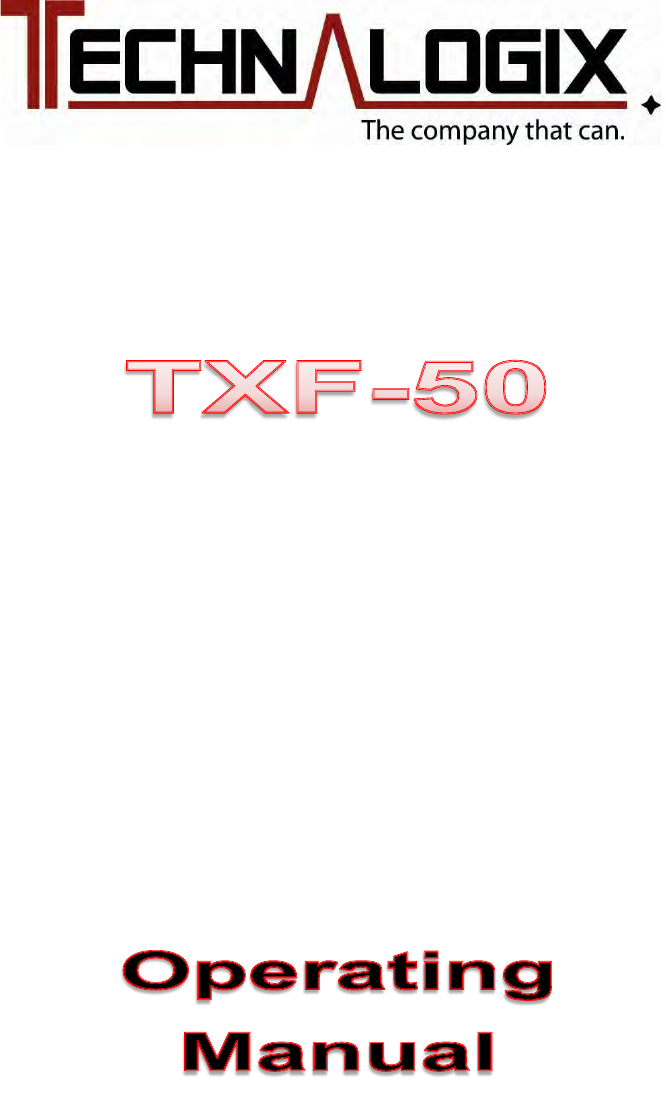
FM TRANSMITTER

Last Revised:
30-Sep-2014
Introduction
You’ve already unpacked it, haven’t you? You’ve unpacked it and plugged it in
and turned it on and fiddled with the knobs. No? Okay, good. Please take a few
minutes to read the manual and familiarize yourself with your new Technalogix
FM power amplifier or transmitter.
We believe that this user manual, the Quickstart package (Final Inspection
Report, Wiring Hookup, and Block Diagram), and of course our equipment,
should be everything you need to get on the air with a superb audio signal. We
understand that a capable and confident user will get the most out of our product
and we have made every attempt to educate readers of all technical levels. If
there is something that is not clear, or you require further information, please do
not hesitate to contact us and we’ll be glad to help out.
Technalogix Ltd.
#4, 8021 Edgar Industrial Place
Red Deer, Alberta, Canada
T4P 3R3
Phone: 403.347.5400
Fax: 403.347.7444
URL: www.technalogix.ca
Email: technical@technalogix.ca
sales@technalogix.ca
All information that is specific to your unit is contained within the Quickstart
package (Final Inspection Report, Wiring Hookup, and Block Diagram) included
in the shipped equipment container. This Quickstart package summarizes
performance specifications, provides wiring hookup details, and outlines specific
components found in the system.
We truly appreciate that you have chosen us as your RF equipment supplier.
Happy transmission!

1
Safeguards
2
Terms and
Warranty
3
Principle of
Operation
4
Installation
5
Operation
6
Control System
7
RF Components
8
Power Supply
9
Maintenance
10
Troubleshooting
General Safeguards
This section is written as a general guide to keep all five fingers on your hand
and is intended for those having previous knowledge and experience with these
kinds of equipment. It is not intended to contain a complete statement of all
safety precautions, which should be observed by personnel using this or other
electronic equipment.
Documentation
Read, retain and follow instructions before operating the equipment. There is a
lot of useful information in the manual, and besides, we spent a lot of time writing
it!
Environment
To reduce the risk of fire or electric shock, do not expose this equipment to rain,
moisture, or rye and sodas at the company Christmas party. Refer all servicing to
qualified service personnel.
Servicing
Do not attempt to service this equipment yourself as opening or removing covers
can result in a warm tingly feeling and will void the warranty. Refer all servicing
to qualified service personnel.

1
Safeguards
2
Terms and
Warranty
3
Principle of
Operation
4
Installation
5
Operation
6
Control System
7
RF Components
8
Power Supply
9
Maintenance
10
Troubleshooting
Safety and First Aid
Personnel engaged in the installation, operation, maintenance, or servicing of
electronic equipment are exposed to the hazard of high voltage. It is imperative
that all safety regulations and precautions are consistently observed. Knowledge
of first aid procedures is recommended. The following information is presented
as a reference only. The user should ensure that they are trained in proper first
aid and the necessary precautions, which may not be contained in this manual,
are followed.
At all times, avoid placing any part of the body in series between ground and
circuit points, whether power is on or off.
Dangerous voltage may be present in equipment even though power is off.
Do not open the cabinet. Refer servicing to qualified service personnel.
It is the duty of all personnel to be prepared to give adequate emergency first
aid treatment and thereby prevent avoidable loss of life.
There are three principle degrees of burns, recognizable as follows:
a first-degree burn reddens the skin.
a second-degree burn blisters the skin.
a third degree burn chars the flesh and frequently places the victim in a
state of shock accompanied by respiratory paralysis.
Respiratory paralysis can cause death by suffocation within seconds. It is
imperative that the approved methods of artificial respiration are initiated
immediately and continue until the victim’s breathing is normal.
A muscular spasm of unconsciousness may render the victim unable to break
free of the electric power. If this is the case, turn the power off immediately.
Do not touch the victim or you may share the same predicament!
If the power cannot be turned off immediately, very carefully loop a dry rope,
article of clothing, length of strong cloth or a rolled-up newspaper around the
victim and pull the victim free of the power source. Carefully avoid touching
the victim or clothing.
Once free of the power source, the victim must be placed in a reclining
position and covered with a blanket or newspapers to keep warm. At the first
opportunity, enlist help in summoning a doctor. If a doctor cannot be
summoned, transport the victim to the doctor or a hospital. Be sure the victim
is kept well covered and warm while awaiting professional treatment.

1
Safeguards
2
Terms and
Warranty
3
Principle of
Operation
4
Installation
5
Operation
6
Control System
7
RF Components
8
Power Supply
9
Maintenance
10
Troubleshooting
Operating Safeguards
Load Impedance
It is a known fact that our FM equipment enjoys 50-ohm load impedances. So
much so, that it is imperative you maintain 50-ohm impedances throughout your
system. In return, your equipment will provide you with maximum power transfer
to the antenna and decreased reflected power heading back towards the
amplifier pallets, reducing the amount of magic smoke that gets let out of the
equipment. Before anything is turned on, ensure that there is a 50-ohm path from
the output of each stage to the input of the next, all the way to the antenna.
Operating Warnings
Our FM equipment is designed to reliably generate a specific RF output power
level. Failing to adhere to overdriven amplifier, high reflected power, and high
temperature, and other warnings can decrease the reliability of your system, and
frankly, makes our repair department busy and grumpy. If you need to transmit to
a little larger coverage, you are better off increasing antenna gain, and more
importantly, antenna height above average terrain. On FM broadcast
frequencies, insufficient antenna height puts an upper limit on your range,
regardless of power levels, as the distance from your antenna to the radio
horizon is limited.
The radiated output power of this device is below the Industry Canada radio
frequency exposure limits. The device should be used in such a manner that the
potential for human contact during normal operation is minimized. Human
proximity to the antenna should not be less than 20 cm (7.9”).
La puissance de sortie rayonnée de cet appareil est inférieure aux limites
d'exposition de radio de fréquence Industrie Canada. Le dispositif doit être utilisé
de telle manière que le potentiel de contact humain pendant l'utilisation normale
soit minimisé. La proximité humaine à l'antenne ne doit pas être inférieure à 20
cm (7.9”).

1
Safeguards
2
Terms and
Warranty
3
Principle of
Operation
4
Installation
5
Operation
6
Control System
7
RF Components
8
Power Supply
9
Maintenance
10
Troubleshooting
Terms of Sale
Sales by Technalogix Ltd. (“Seller”) are made only on terms which are contained
in this policy. Seller hereby gives notice of its objection to any different/additional
terms and conditions. All sales are expressly conditional upon Buyers’ assent to
the terms and conditions set forth below. These terms and conditions may be
modified/ supplemented only by written document signed by authorized
representative of the Seller. These terms and conditions supersede any prior
and/or contemporaneous agreements/correspondence between Buyer and
Seller. Any order received and accepted by Seller shall be construed as
acceptance of Seller’s offer to sell its products to the Buyer in accordance with
terms and conditions of sale set forth herein. No waiver, whether express or
implied, by Seller of any of the terms or conditions hereof shall be deemed a
continuing waiver or trade custom between parties, but shall apply solely to the
instance to which the waiver is directed.
Ordering Information
All orders must be in writing and/or accompanied by a Purchase Order. A
minimum down payment is required with all orders. No orders are considered an
order until the payment has been made.
Pricing Policy
All prices are FOB shipping point and prices do not include freight, handling, and
insurance. All prices published/quoted by Seller may be changed at any time
without notice. Unless otherwise specified, written quotations expire 30 days from
date issued and subject to change/termination by notice during this period.
Taxes
Prices for all products do not include any sales, use, excise or other taxes. Buyer
agrees to pay all applicable taxes, duties and other fees on product and services
ordered. If Buyer claims an exemption from any tax, Buyer shall submit to Seller
the appropriate exemption certificates.
Shipping
Shipping is the responsibility of the Buyer. This includes all freight, customs and
brokerage charges, duties, and insurance.

1
Safeguards
2
Terms and
Warranty
3
Principle of
Operation
4
Installation
5
Operation
6
Control System
7
RF Components
8
Power Supply
9
Maintenance
10
Troubleshooting
Terms of Payment
Seller will provide credit terms to Buyer at its discretion. Such terms are subject
to change at all times. If credit is provided, Seller will invoice Buyer on the date
the product is ordered. Such invoices will be due and payable net thirty (30) days
from the date of invoice, subject to credit is not established or maintained, terms
shall be net cash on or prior to the Delivery Date. Seller reserves the right, at its
sole discretion at any time to revoke any credit previously extended. Past due
accounts shall be charged two percent (2%) per month, or the highest rate
permitted by Alberta law, whichever is less, and will be added to the outstanding
balance. In the event Buyer defaults on the payment, Buyer shall be liable for all
collection costs, including reasonable attorney’s fees and costs. Non-payment of
past due accounts will result in a lien against parts and all subsequent
assemblies or products that our components are in. Goods remain the property of
Seller until invoice is paid in full.
Changes and Cancellation
Purchase orders that have been accepted by Seller may not be changed/
cancelled, in whole or part, without written Seller consent. All changes must be
included in change order reflecting purchase order and submitted to the Seller.
All other changes will not be accepted/acknowledged. Changes may affect
delivery dates. Expenses incurred because of changes shall be charged to
Buyer. Buyer will be liable for Seller’s costs incurred, plus a reasonable profit, for
the portion of work terminated, in accordance with generally accepted accounting
principles, together with cancellation charges. Orders for standard product may
be changed by Buyer, with no penalty to Buyer, provided that Buyer provides
Seller notification at least 30 days prior to scheduled ship date. Order changes
received within 30 days of scheduled ship date may be subject to an order
change charge; a schedule detailing these charges will be forwarded to Buyer
when Buyer’s change order is acknowledged. In no event can any aspect of the
order be changed after the product shipment has occurred. Custom orders may
be cancelled by Buyer, provided that Buyer pays Seller for completed work
allocated to Buyer’s order at time of termination of the work at selling price and all
costs for work-in-progress and costs resulting from cancellation and reasonable
profit therein. Specific cancellation charges dependent on the type of custom
product ordered. A schedule detailing these charges will be forwarded to Buyer
when Buyer’s cancellation fee of up to 100% of the order, depending on the
stage of completion of the order at the date the cancellation or revised is
accepted.

1
Safeguards
2
Terms and
Warranty
3
Principle of
Operation
4
Installation
5
Operation
6
Control System
7
RF Components
8
Power Supply
9
Maintenance
10
Troubleshooting
Custom Products Policy
Custom items are not returnable. Items other than “off the shelf” products are
considered custom and are products/materials which have been altered,
amended and customized to your order, and not resalable.
Returns
Product return without written authorization by Seller will not be accepted.
Returns accepted only with a valid Return Material Authorization (RMA). To
receive authorization for product return, call Seller. There is a standard 25%
restocking cost assessed on most returns. All returned products (non-repair)
must be unused, and in original condition. No refund/credit given for damaged
products. We do not accept postage-due/ C.O.D. packages at any time.
Excusable Delay
Seller shall not be liable for any loss or damage resulting from any delay in
delivery or failure to deliver which is due to any cause beyond Seller’s control,
including, without limitation, acts of nature, unavailability of supplies or sources of
energy, riots, wars, fires, floods, epidemics, lockouts, strikes and slowdowns,
delays in delivery by supplies, or acts or omissions of the Buyer. The Buyer shall
be liable for stage charges, including but not limited to all third party costs and
expenses incurred by Seller, in holding or storing products for the Buyer or at the
Buyer’s request.
Assignment
Buyer shall not assign any duties nor assign any order or any interest therein
without written consent of the Seller. Any such actual or attempted assignment
shall entitle Seller to cancel the order upon written notice to the Buyer.
Installation
Seller assumes no obligation to install any product sold to place any products in
working order at Buyer’s premises and not responsible for freight damage.
Validity of Separate Clauses
If any provisions of this agreement shall be held invalid, illegal, or unenforceable,
the validity, legality or enforceability of the remaining provisions shall not be
affected or impaired thereby.

1
Safeguards
2
Terms and
Warranty
3
Principle of
Operation
4
Installation
5
Operation
6
Control System
7
RF Components
8
Power Supply
9
Maintenance
10
Troubleshooting
Warranty
Technalogix products have been completely tested and found to meet
specifications and be in proper operating condition. Technalogix-manufactured
products are warranted to be free from defects in materials and workmanship for
a period of two years from the date of shipment. Products sold through, but not
directly manufactured by Technalogix, carry the original manufacturer’s warranty.
Seller will not be liable for damages of whatever nature arising out of or in
connection with the equipment or its use thereof. Technalogix does not assume
responsibility for injury or damage resulting from the practices of untrained or
unqualified personnel in the handling of this equipment and does not include
misuse, neglect or accident, incorrect wiring and/or improper installation,
unauthorized repairs, modifications or use in violation of instructions issued by
Seller, incidental or consequential damages as a result of any defect, reshipment
cost or insurance of the unit or replacement units or parts, acts of nature,
damages due to AC or DC power supplied by customer to power the equipment
(see installation recommendation for surge protection), or acts of terrorism. Seller
agrees, at our option, to remedy warranted defects or furnish a new part in
exchange for any part of unit which, under normal installation, use and service,
becomes defective. The user pays for transportation costs to and from repair
facility. If you require on-site service, the cost to you will be $800.00 US per 8-
hour day plus air fare, meals, and transportation charges for personnel and
equipment.

1
Safeguards
2
Terms and
Warranty
3
Principle of
Operation
4
Installation
5
Operation
6
Control System
7
RF Components
8
Power Supply
9
Maintenance
10
Troubleshooting
Principle of Operation
The internal FM exciter found inside FM transmitter enclosures accepts analog,
digital or MPX audio signals and modulates them onto an FM carrier. The analog
signal can be either mono or stereo (both included as standard), while the digital
inputs are accepted on AES3, S/PDIF optical (Toslink), or S/PDIF coaxial inputs.
Also included on the Exciter circuit board are amplifier stages to increase the
modulated level from a few dBm up to several watts.
The RF power amplifier is designed to take a modulated FM carrier from the
Exciter (typically less than 30-watts depending on transmitter power level), and
amplifies the carrier to a level that is suitable for transmission through an
antenna, cavity, or alternative load. The power amplifier feeds this load through
an inline wattmeter and transmission line. For broadcast and over-the-air
amplifier systems, the pattern of the antenna then dictates the range and
coverage area.
The amplification is accomplished by one or many amplifier pallets internal to the
power amplifier system. If there is more than one amplifier pallet stage, then the
first pallet acts as a driver feeding Intermediate Power Amplifiers (IPAs) and/or
final stage pallets. If multiple final pallets are required, then a splitter and
combiner are also required before and after the final stages.
Technalogix manufactures FM amplifiers and transmission systems suitable for
87.5 to 108.0 MHz. Custom frequencies are available upon request if you require
carriers outside this range, including audio for VHF applications and other unique
requirements.
The RF amplifiers utilize readily available RF components wherever possible,
thus enhancing the serviceability of the equipment. The amplifier modules are
stable for high reliability and long service life and feature ultra linear amplification
and individual channel RF output filtering, unless ordered otherwise.
The Block Diagram is included with the Quickstart package to illustrate the
specific component flow of the RF amplifier system and to provide specific
configuration and model information.

1
Safeguards
2
Terms and
Warranty
3
Principle of
Operation
4
Installation
5
Operation
6
Control System
7
RF Components
8
Power Supply
9
Maintenance
10
Troubleshooting
Installation
This section contains installation recommendations, unpacking, inspection, and
installation instructions for the power amplifier or transmitter. We are sure that
you are chomping at the bit to install your new system, so we recommend that
you read the following sections very carefully.
Building Recommendations
The quality of the building is of great importance if you are to expect long life and
continued performance from the power amplifier or transmitter. The building must
be clean, dry, temperature controlled and secure. Don’t forget to allow space in
the building for any additional racks to house test equipment, a workbench area,
line regulating transformers, ladders, equipment and parts storage, first aid kit,
emergency generator if used, as well as heating and cooling devices that may be
unique to your installation. A beer fridge is optional. A sloping roof will tend to
develop leaks less rapidly. The building should be well roofed with good material.
The cooling load will be lowered with reflective or light colored roofing material.
Electrical Service Recommendations
Technalogix recommends that a qualified, licensed local electrician be consulted
for the required electrical service. We suggest local electricians because:
The personnel knows the local codes
The personnel can be on site readily
You are apt to get better overall support if you give what business you can
to local suppliers
Technalogix recommends that proper AC line conditioning and surge
suppression be provided on the primary AC input to the power amplifier or
transmitter. If DC is used as a source, a DC-DC converter is recommended to
provide isolation between the supply and the load. All electrical service should
be installed with your national electrical code in your area, any applicable
provincial or state codes, and good engineering practice. Special consideration
should be given to lightning protection of all systems in view of the vulnerability of
many sites to lightning. Lightning arrestors are recommended in the service
entrance. Gas Discharge Tubes (GDT) may help in preventing lightning, which
was forecast for another day, from creating a bad day. Straight and short grounds
are recommended. The electrical serviced must be well grounded. Do not
connect the unit to an open delta primary power supply, as voltage fluctuations
could harm the unit. Branch your circuits. Do not allow your lights, your
workbench plugs, and your transmitting or translating equipment to operate on
one circuit breaker. Each amplifier or transmitter should have its own circuit
breaker, so a failure in one does not shut off the whole installation.

1
Safeguards
2
Terms and
Warranty
3
Principle of
Operation
4
Installation
5
Operation
6
Control System
7
RF Components
8
Power Supply
9
Maintenance
10
Troubleshooting
Antenna and Tower Recommendations (if applicable)
Your preliminary engineering workgroup should establish your antenna and tower
requirements, if applicable, both for receiving and transmitting antennas.
Construction of sturdy, high quality antenna/tower systems will pay off in terms of
coverage of your service area, the overall quality and saleability of your radiated
signal, and reduced maintenance expenses. Technalogix provides complete
turnkey antenna systems if needed. If your site is serving as a translator, your
receiving antenna should be in line of sight to the originating station all year
round. The foliage will change with season. Transmitting antennas can enhance
or seriously impair the amplifier or transmitter output.
The selection, routing, and length of coaxial cable are extremely important in the
installation. If there is a 3 dB line loss in the cable between your unit’s output and
the transmitting antenna, the unit will only deliver half power. Buy the best cable
you can obtain, route it via the shortest way to the antenna, and keep it straight.
Do not form it into sharp bends on its way. Do not use any more cable fittings for
the installation than absolutely necessary. All cautions here apply equally to all
coaxial cables in the system - input and output.
Pay attention to radial ice accumulation when designing the transmission system.
It is not uncommon for at least an inch of ice to build up on a tower or antenna in
some locations. This in turn significantly increases the weight, cross section, and
wind loading of the system, not to mention creating issues from reflective power.
Attaching the transmission line to the tower is crucial to maintain a safe and
reliable operation. Nylon wire ties and electrical tape will breakdown in the
sunlight and ultimately fail, creating a potentially dangerous situation. It is
important to use proper clamps and hoisting grips and also ensure that the
transmission line is grounded to the tower in several locations. When high
currents flow through the tower in the event of lightning strikes, some of that
current will flow through the outer conductors of the transmission lines. Due to
the resistance difference between the steel tower and copper transmission line, a
significant voltage can be developed, often resulting in arcing between the outer
jacket and outer conductor, thus pitting the conductor.
Preventative maintenance is crucial in ensuring that safety is maintained.
Specifically, check that transmission line grounds are tight and are not missing
any hardware. Frequently inspect support clamps or spring hangers. Consider
investing in an ice break, if you haven’t already done so, as shards of falling ice
can damage the transmission line – and if it is going to happen, it will happen at
an important time. Check the tower light photocells and conduit.

1
Safeguards
2
Terms and
Warranty
3
Principle of
Operation
4
Installation
5
Operation
6
Control System
7
RF Components
8
Power Supply
9
Maintenance
10
Troubleshooting
The better-known tower manufacturers offer complete technical and safety
documentation with their towers. Be sure that you have this information as it
regards wind loading, guying, etc. The best-designed antenna system will
function poorly if shortcuts and compromises are used during installation. Follow
the manufacturer’s instructions exactly, along with any engineering data prepared
for the site. Be absolutely safe and certain about this aspect as human lives may
be at stake.
Shelter Security
The FCC requires that the equipment be secure from entry or control by
unauthorized persons, and that any hazardous voltages or other dangers
(including most tower bases) be protected by locks or fences as necessary to
protect personnel and prevent unauthorized tampering or operation. Security of
the building further implies that it be secure from wildlife. Use sturdy construction
materials, including sheet metal if necessary. Holes around conduit, cable, and
other similar entry points should be stuffed with steel wool and caulked to prevent
entry of wildlife. Other features of security for your shelter may include its location
with respect to the prevailing wind conditions. Locations leeward of some natural
topographical feature will prevent wind damage and snowdrifts. Check the soil
runoff conditions that may slow or hasten wind or water erosion and other
concerns that may be unique to your location.
Heating and Cooling Requirements
The environment’s temperature will contribute greatly to the length of the power
amplifier’s or transmitter’s life. Technalogix recommends that the building’s
filtered air intake must have capacity for all air-flow in the building plus an
additional 20%. Keep the intake below the roofline to avoid intake of solar heated
air. Please ensure that the intake and exhaust areas are on the same side of the
building to avoid pressure differentials during windy conditions. Also, do not
position intake near exhaust’s preheated air. If air conditioning is required to cool
the shelter, discuss the situation with a qualified HVAC technician. Under
average conditions, 12,000 BTUs will cool approximately 500 square feet to a
comfortable level.
The fans internal to the enclosures help cool the components. The specific fan
voltages and part numbers are listed in the Block Diagram included with the
Quickstart package.

1
Safeguards
2
Terms and
Warranty
3
Principle of
Operation
4
Installation
5
Operation
6
Control System
7
RF Components
8
Power Supply
9
Maintenance
10
Troubleshooting
Unpacking and Inspection
Check the outside of the container. Carefully open the container and remove the
power amplifier or transmitter and any accessories. Retain all packing material
that can be reassembled in the event that the equipment must be returned to the
factory.
Exercise care in handling equipment during inspection to prevent
damage due to rough or careless handling.
Visually inspect the enclosure of the power amplifier or transmitter for damage
that may have occurred during shipment. Check for evidence of water damage,
bent or warped chassis, loose screws or nuts, or extraneous packing material in
connectors or fan failures. Inspect all connectors for bent connector pins. If the
equipment is damaged, a claim should be filed with the carrier once the extent of
the damage is assessed. Technalogix cannot stress too strongly the importance
of immediate careful inspection of the equipment and subsequent immediate
filing of the necessary claims against the carrier if necessary. If possible, inspect
the equipment in the presence of the delivery person. If the equipment is
damaged, the carrier is your first area of recourse. If the equipment is damaged
and must be returned to the factory, phone for a return authorization number.
Claims for loss or damage may not be withheld from any payment to
Technalogix, nor may any payment due be withheld pending the outcome
thereof. Technalogix cannot guarantee the carrier’s performance.
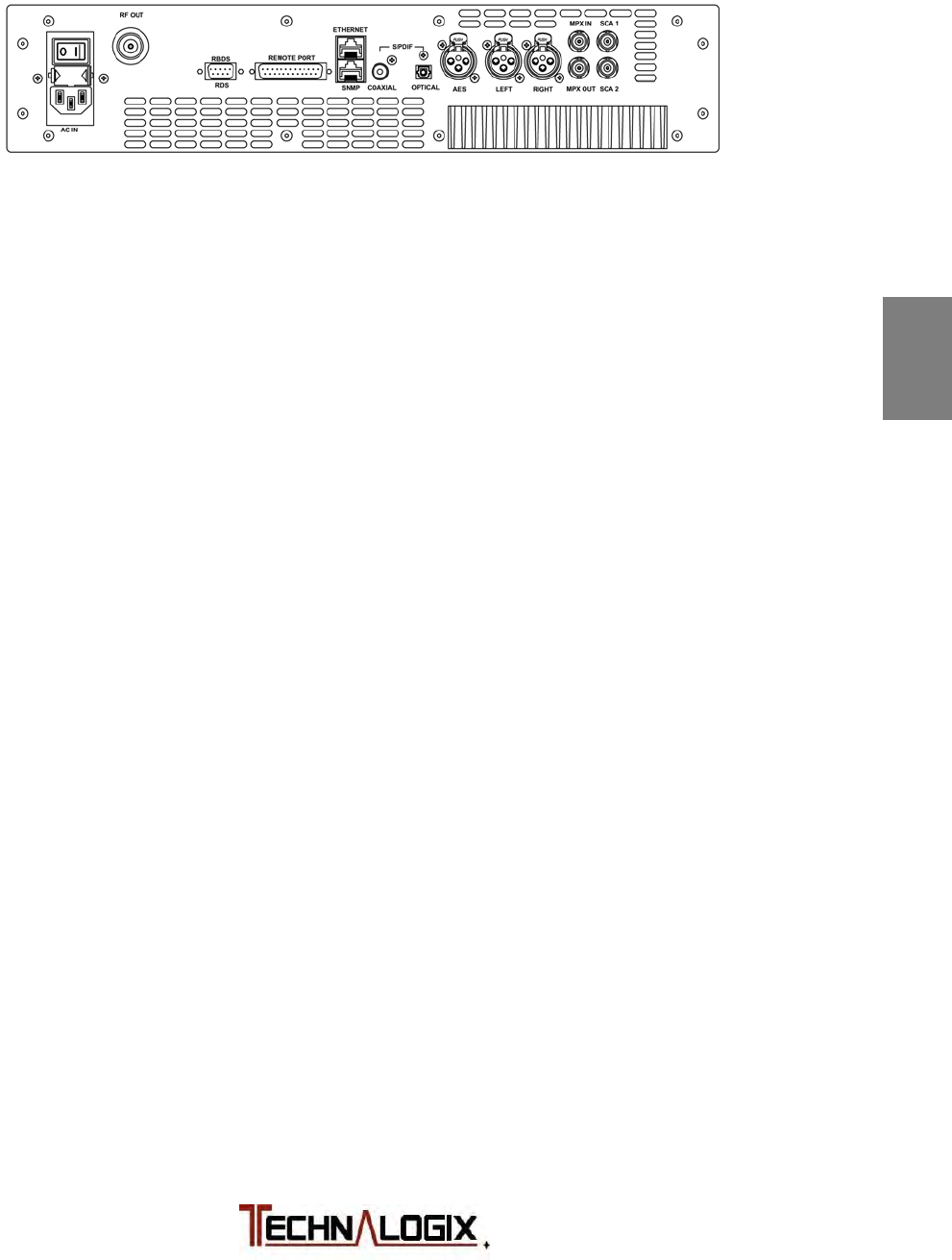
1
Safeguards
2
Terms and
Warranty
3
Principle of
Operation
4
Installation
5
Operation
6
Control System
7
RF Components
8
Power Supply
9
Maintenance
10
Troubleshooting
Panel Connections
AC IN: Single phase AC input to feed internal AC/DC switching power supplies.
Check with factory as not all power supplies are universal 110/220V.
RF OUT: FM modulated RF carrier output (N female or 7-16 DIN female)
RBDS/RDS: Configuration and control of RBDS/RDS encoder in transmitter
accomplished through RS232 (female) connector.
REMOTE PORT: Parallel parameter interface (DB25 female)
ETHERNET: Remote control and monitoring via Ethernet (RJ45 jack)
SNMP: Simple Network Management Protocol (SNMP) remote control and
monitoring (RJ45)
S/PDIF COAX: Digital audio input, Sony/Phillips Digital Interface, coaxial (RCA female)
S/PDIF OPTICAL: Digital audio input, Sony/Phillips Digital Interface, optical (Toslink female)
AES (digital): Digital audio input, AES/EBU professional audio interface (XLR female)
LEFT (analog): Analog audio input, left channel, (XLR female)
RIGHT (analog): Analog audio input, right channel, (XLR female). For Mono operation,
use the Right input.
MPX IN: External MPX input. Used when external stereo encoders or processors
present. (BNC female)
MPX OUT: MPX output signal from exciter. Used for external processing. (BNC
female)
SCA1/SCA2: Input connection from SCA generator or source, intended for 60 to 99
kHz. Typically modulated to 10%, or 7.5 kHz deviation.

1
Safeguards
2
Terms and
Warranty
3
Principle of
Operation
4
Installation
5
Operation
6
Control System
7
RF Components
8
Power Supply
9
Maintenance
10
Troubleshooting
Initial Hook Up
1. Ensure that the antenna has been swept and, ideally, has a return loss of
greater than 20dB (VSWR = 1.2:1). This should be done before connecting
the antenna cable to the system’s output. The power amplifier’s control
system allows the user to change the VSWR trip point up to a maximum level
of 1.8:1, unless a custom VSWR protection system has been requested.
Strive for the lowest possible return loss to maximize transmission distance
and improve operating performance. Unless requested otherwise at the time
of purchase, VSWR levels between the trip point set by the user and 1.8:1 (or
custom VSWR trip point) will cause a fold back in power. VSWR levels past
1.8:1 (or custom VSWR trip point) will cause the system to shut down or fold
back with attenuation to avoid damage.
2. Place the amplifier in its permanent location near a receptacle supplying the
required AC or DC mains voltage.
3. Place an appropriate AC or DC power line protector, conditioner, and/or surge
suppressor across the supply line. This small investment is highly
recommended to protect the equipment from power surges and spikes (not
covered by warranty).
4. Install a lightning surge arrestor or Gas Discharge Tube (GDT) on the coax
near the antenna to protect the amplifier. This small investment is highly
recommended to protect the equipment from lightning (not covered by
warranty).
5. Connect the transmitting antenna cable to the RF OUT female connector on
the PA enclosure’s RF output. On units that have a separate filter or
filter/power supply enclosure after the power amplifier enclosure, ensure to
connect the transmitting antenna cable on the last enclosure in the chain to
the RF Out and connect the RF coaxial between the power amplifier and the
second enclosure in the chain. The system must be loaded into a 50-ohm
load before any power is turned on for over-the-air systems. The Wiring
Hookup is included in the Quickstart package included in shipping and
visually summarizes the aforementioned information.

1
Safeguards
2
Terms and
Warranty
3
Principle of
Operation
4
Installation
5
Operation
6
Control System
7
RF Components
8
Power Supply
9
Maintenance
10
Troubleshooting
6. Connect the desired audio source connection, analog mono or stereo, digital
audio, or MPX. Subcarrier signals can be connected to the SCA1 or SCA2
BNC connectors.
7. Connect additional control/monitoring cables if desired. SNMP or Ethernet
should be connected to the lower RJ45 on the back panel. Remote port
connections are made to the DB25 connector and the internal RDS in
controlled by RS232 on the DB9 connector.
At this stage, the system is set up and ready to do a preliminary start up, as
outlined in the “Operating Procedure” section.
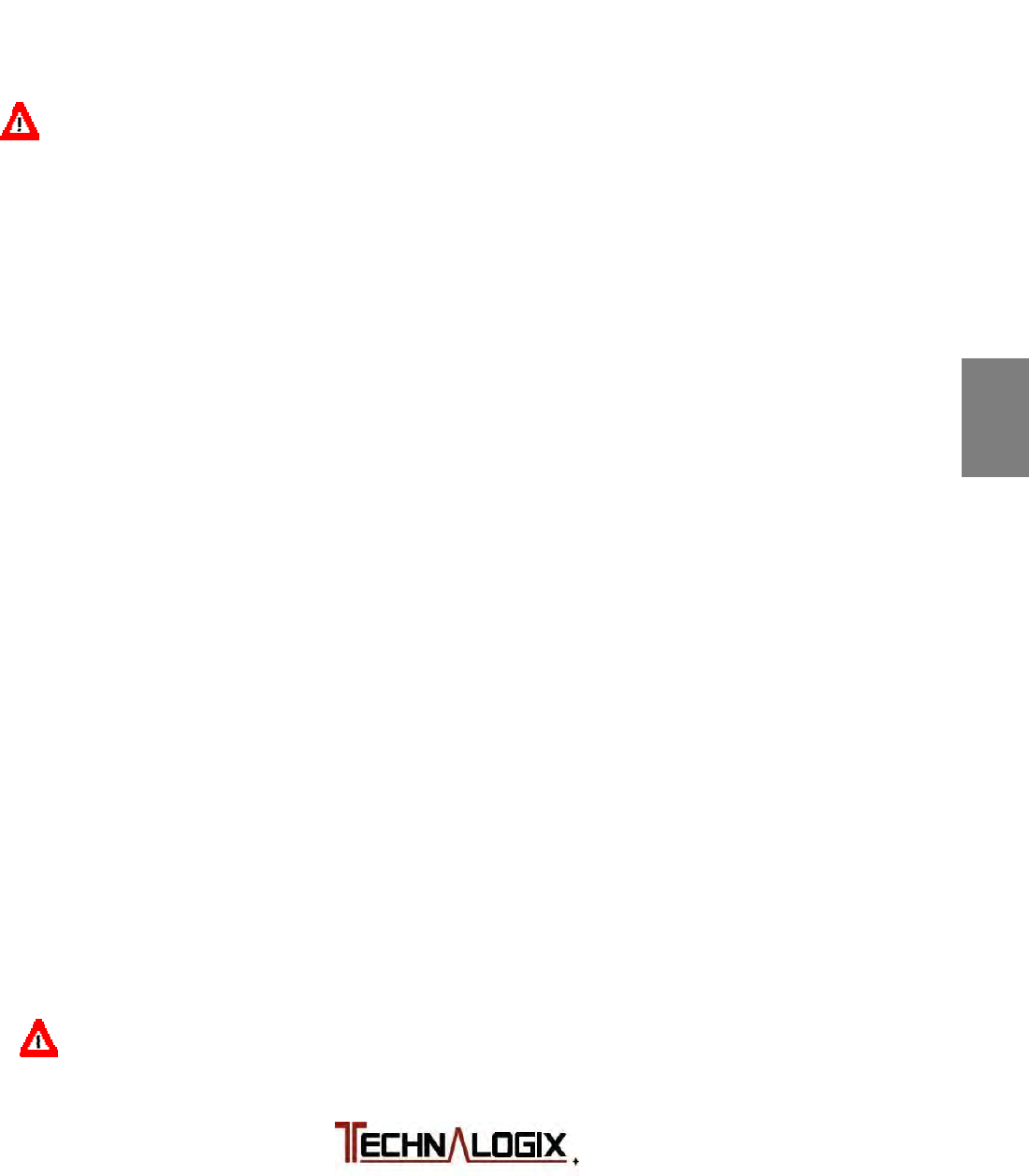
1
Safeguards
2
Terms and
Warranty
3
Principle of
Operation
4
Installation
5
Operation
6
Control System
7
RF Components
8
Power Supply
9
Maintenance
10
Troubleshooting
Operating Procedure
Assuming the previous installation instructions have been completed and
cautions noted, and the power amplifier is ready to receive a properly modulated
RF signal, proceed with the following steps to place the system in operation. The
power amplifier has been factory aligned for a specific frequency (per system
specification), signal levels and optimum performance.
IT IS HIGHLY RECOMMENDED THAT YOU RUN YOUR SYSTEM INTO A
DUMMY LOAD BEFORE INSTALLING TO MAKE SURE THERE ARE NO
DAMAGES CAUSED IN SHIPPING AND THE UNIT IS RUNNING PROPERLY
1. Verify that all control and RF cables are tight and properly seated in or on the
mating connector.
2. Plug in the desired audio source: analog (left and right for stereo), digital or
MPX. For mono audio use the Right XLR input.
3. With the power amplifier loaded into the antenna, cavity, alternative load, or
dummy load power up the amplifier by turning on power supply either via the
ON/OFF switch on the back of the power amplifier.
4. Verify that the power amplifier fans are all on. The power amplifier fans are
powered via DC voltage so this is an indication that the power supply is
started and running. There may be fans installed in the filter or power supply
enclosures, if applicable.
5. The internal soft start circuitry will turn the bias voltages off until the power
supply to the amplifier pallets is fully stable. The front display indicates when
the soft start is running with either a displayed message when an LCD option
is installed or via maximum attenuation when a touch screen option is
installed. Once complete, the Forward and Reflected Power, Power Supply,
and Temperature readings will appear on the display. Deviation is shown on
the FM screen.
6. Adjust RF output power on the power amplifier to about 10% of rated forward
power. The output power level is adjusted from the power amplifier’s RF
Levels screen. Then turn the carrier on, the Carrier On/Off is in the top right
corner of the touch display on all screens. If the unit contains more than one
final amplifier pallet (illustrated in your Block Diagram included in the
Quickstart package), ensure that the final pallet currents on the multiple finals
all match within 10% of each other. With multiple finals, the final pallet
currents should always match within this range under all operating conditions.
Front panel readings will vary slightly upon turn on. Steady state parameters
can be taken after approximately one hour.
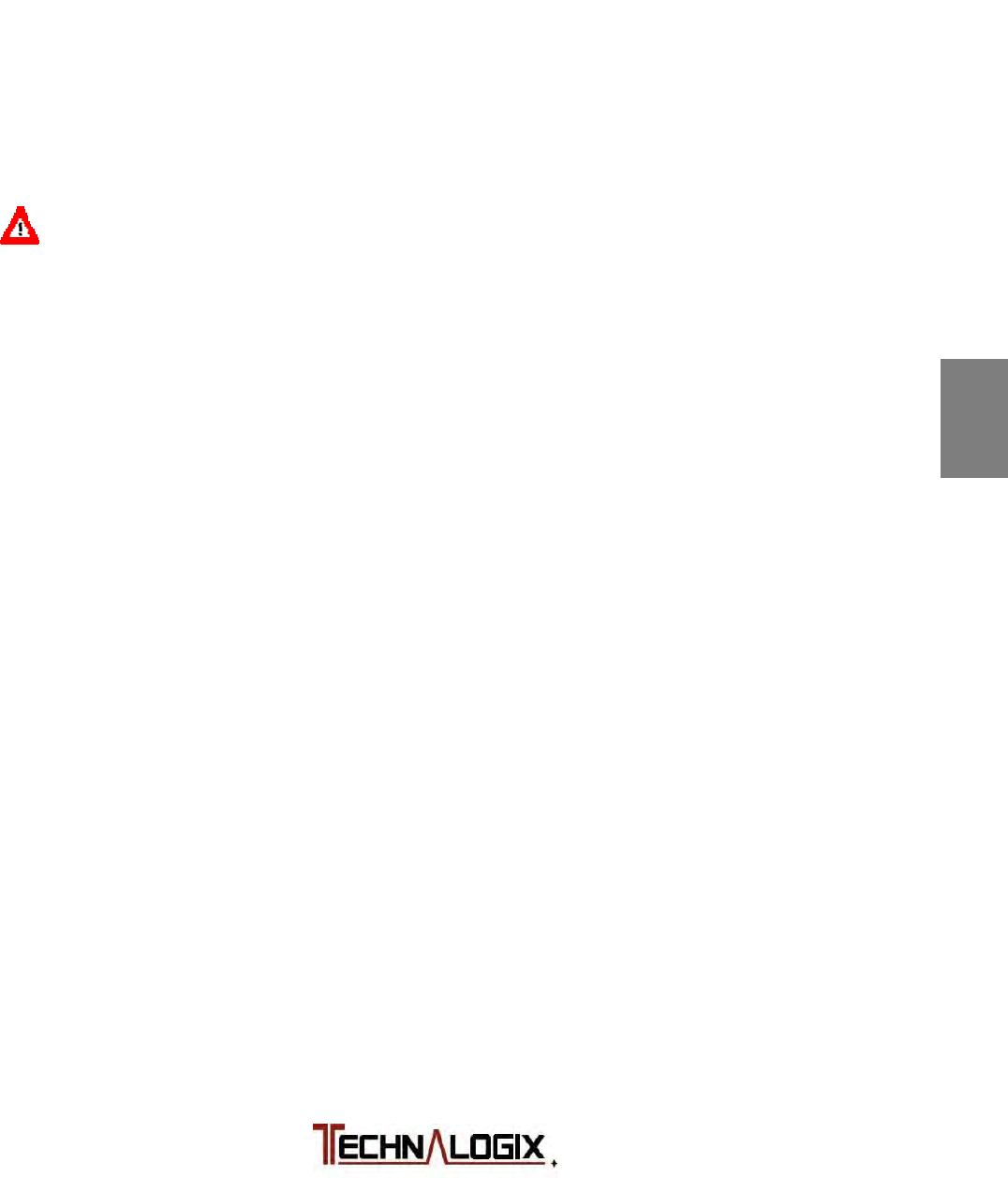
1
Safeguards
2
Terms and
Warranty
3
Principle of
Operation
4
Installation
5
Operation
6
Control System
7
RF Components
8
Power Supply
9
Maintenance
10
Troubleshooting
7. Ideally, the RFL Power should read zero. However, should a high VSWR be
detected, the system will automatically fold back. Under normal conditions, a
well installed and setup system should indicate RFL power less than 3% of
FWD power.
8. Adjust RF output power on the power amplifier to desired level. The output
power level can be adjusted from the power amplifier’s RF Levels screen.
Keep in mind that the system will fold back or shut down (depending on
severity) should the forward RF output power level exceed the trip overdrive
point.
Pease note that 100% should be the maximum FWD power. Typically,
customers run the systems at 90% to avoid occasional AC power line spikes
or transients from tripping the shutdowns. The difference of 10% will provide a
marginal difference in range (tower height will have a much more significant
effect on range in the case of over-the-air) or cavity excitation.
9. Verify that the power supply reads correctly (see supplied final inspection
sheet for factory settings of power supply levels) on the display of the power
amplifier. You should see no more than 3% fluctuations in DC supply voltage,
and even less with a properly conditioned AC source to the power supply.
10. Look at the transmitted output using suitable test equipment. If the output
quality is unsatisfactory, check the input signals, connections to the antenna
system, antenna and transmission line VSWR, and the physical condition of
the antenna.
11. Select the appropriate input from the FM Controls screen on the front panel.
12. Adjust the attenuation for the input if needed from the Audio Levels screen on
the front panel. Check the modulation level on the main RF Display or FM
display on the front panel.
13. After warm up, compare the temperature of the equipment from the front
display to the temperature recorded in the final inspection sheet, included in
shipping. Assuming ambient temperatures are close (our factory is typically
around 18 to 25˚C), your temperature reading should be very close to the
factory reading. Use your temperature measurement as a method to monitor
fan performance (though on higher power units, fan current is also
monitored). A fan failure or air blockage will show an increase in temperature,
assuming ambient temperature is not varying.

1
Safeguards
2
Terms and
Warranty
3
Principle of
Operation
4
Installation
5
Operation
6
Control System
7
RF Components
8
Power Supply
9
Maintenance
10
Troubleshooting
For FM broadcast applications, if the quality of transmission is unsatisfactory, the
difficulty is often with the receiving antenna or with obstructions in the path
between the amplifier/antenna and receiver. There is also a troubleshooting
section located later in this manual.
At this time, Technalogix recommends that you document your measurements to
use as a reference over time. The measurements can be made either from the
front display, or remotely via the Remote Port (DB25), Ethernet (lower RJ45), or
SNMP (lower RJ45), whose operation is explained in the Monitor and Control
System sections.

1
Safeguards
2
Terms and
Warranty
3
Principle of
Operation
4
Installation
5
Operation
6
Control System
7
RF Components
8
Power Supply
9
Maintenance
10
Troubleshooting
Monitor and Control System
Control System Overview
The control system is used for a variety of functions, the most important of which
is ensuring that the amplifier or transmitter continues to operate in a safe manner.
The control system also allows the user to monitor and control the amplifier or
transmitter from both the front panel and remotely through the parallel port,
Ethernet, or SNMP access port.
The control system is comprised of three modules. These modules work together
to provide all the functions of the control system and include: Display Interface,
Exciter (in the case of a transmitter), and Temperature Sensor modules. The
operation of each module is outlined in the following sections and illustrated in
the following block diagram. Multiple revisions of the modules may be included.
Specific revision numbers of the modules are listed on the Final Inspection
Report included in the Quickstart Package and also in the Versions screen if the
touchscreen option was ordered.
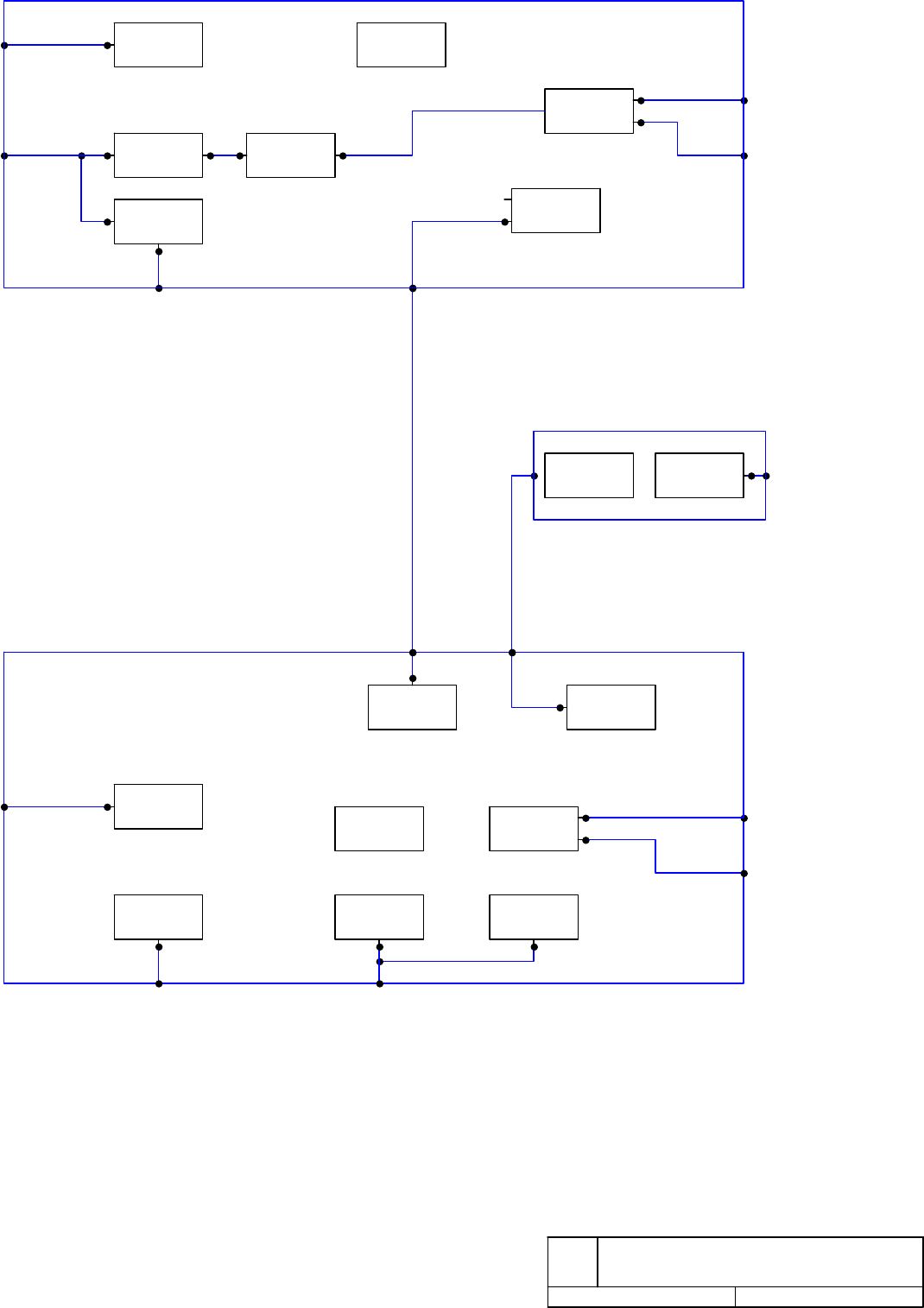
CAN
INTERFACE
TEMP AND
SHUTDOWN
INTERFACE
CAT5
REAL
TIME
CLOCK
RF
SHUTDOWN
FAULT
COMPARATORS
SYSTEM
MEASUREMENTS
DC OUT
DC IN
PANEL
SWITCH
INTERFACE
MEMBRANE
SWITCH
CAT5
DISPLAY
INTERFACE
TOUCHSCREEN
RF TO GAIN
STAGES
TEMP
SENSOR
SHUTDOWN
INTERFACE
TEMPERATURE SENSOR
+5V
SWITCHING
SUPPLY
CHARACTER
LCD
CONTRAST
SUPPLY
EXTERNAL
DC-DC
CONVERTER
CAN
INTERFACE
DISPLAY INTERFACE / OLED INTERFACE
FM EXCITER
AUDIO IN
RJ45
INTERFACE
RF-TO-DC
CONVERTER RF SAMPLE
FROM
COUPLER
RFL
FWD
REMOTE
PORT
DB25 PARALLEL
INTERFACE
ETHERNET SNMP
AUDIO
PROCESSING
(FM)
Adrenaline Block Diagram - FM
Date: June 9, 2014 Page: 1 of 1
Rev ID
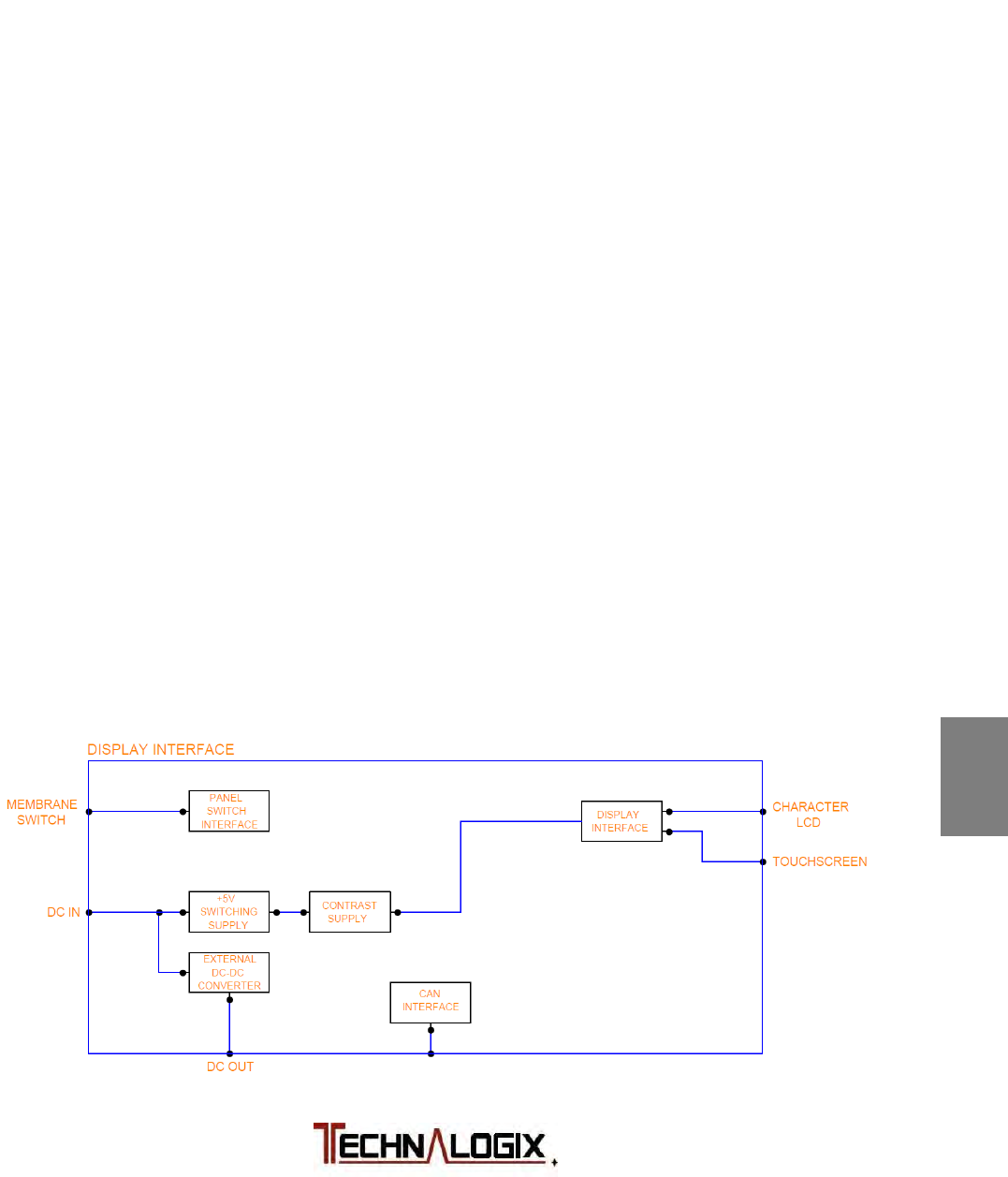
1
Safeguards
2
Terms and
Warranty
3
Principle of
Operation
4
Installation
5
Operation
6
Control System
7
RF Components
8
Power Supply
9
Maintenance
10
Troubleshooting
Display Interface Module
REV 1.02 (ASY 016)
Touchscreen Option
The primary function of the Display Interface module is, as the name suggests,
providing the display and user interface for the control system. This circuit board
is mounted behind the front panel of the power amplifier enclosure(s) in the
amplifier system, near the 4.3” touchscreen or OLED display. All switch/settings
and user interface is handled through the resistive touchscreen. The touchscreen
on the front panel is connected to the Display Interface PCB through a cable.
These components provide the user with the ability to monitor the following
power amplifier or transmitter parameters from the front panel:
• Forward (incident) power at the power amplifier or transmitter output.
• Reflected (reverse) power at the power amplifier or transmitter output.
• DC voltage of the power amplifier’s or transmitter’s power supply.
• DC current in the power amplifier or transmitter.
• Temperature of the heat sink of the power amplifier or transmitter.
• The time since the amplifier or transmitter was last shut down.
• History of faults and events.
• Indication if there is attenuation added to the front end of the power
amplifier or transmitter indicating fold back in RF power (indicates amount
of attenuation).
• Settings to change the VSWR trip point shutdown between 1.1:1 and
1.8:1.
• Settings to change the RF power units between % power (maximum of
110%) or watts.
• Summary of PCB modules and assembly numbers specific to the power
amplifier or transmitter.
A block diagram of the Display Interface PCB follows:

1
Safeguards
2
Terms and
Warranty
3
Principle of
Operation
4
Installation
5
Operation
6
Control System
7
RF Components
8
Power Supply
9
Maintenance
10
Troubleshooting
The hardware of the Display Interface module is based around microcontroller
(U101). This part interfaces directly with the touchscreen to provide output and
receive input from the user. It also communicates with the RF board (and DC
Distribution Module, if installed) over a Controller Area Network (CAN) bus. This
communication is facilitated by U103, and passes through a CAT5 cable attached
to connector J104 and J105. The communication link with the RF module allows
the Display Interface Module to receive information about the forward power,
reflected power, and temperature of the amplifier/transmitter, as well as relay
commands from the user to the rest of the system. If the DC Distribution Module
is installed (on higher power systems with multiple pallets), then the Display
Interface receives DC currents from the DC Distribution via the same CAN bus.
Other elements of the Display Interface module are also controlled by the
microcontroller. A buzzer (BZ101) and software status LED (D101), which flashes
when the software / microcontroller is running, are all controlled through a buffer
(U102). DC supply enters through connector J103, which powers the PCB and
also the optional DC-DC converter (based around U111), if populated. The PCB
voltage is regulated at +5V by U106 and associated circuitry. The touchscreen
interfaces to the Display Interface via connector J107.
The fuses on the Display Interface are all resettable. F102 protects the +5V line
while F101 protects the DC-DC converter, if installed.
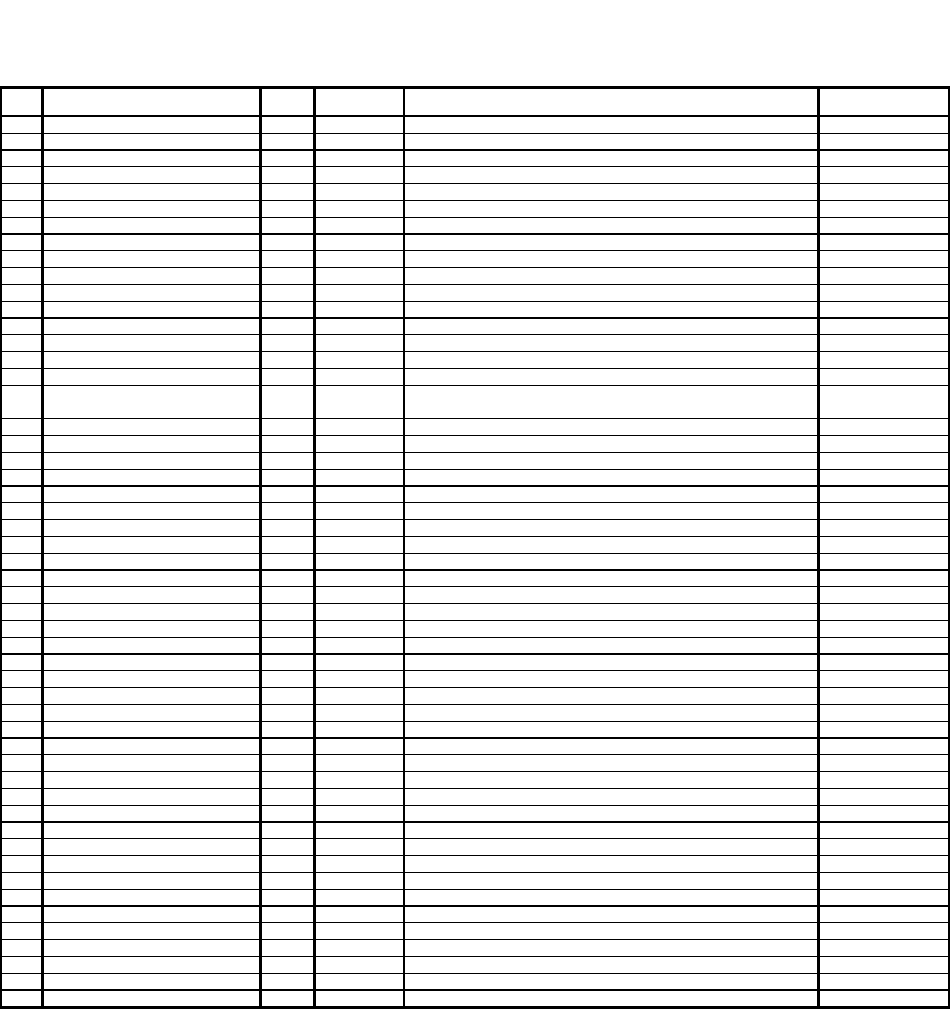
Circuit: Display Interface with DC-DC, with touchscreen
Revision: 1.02
Modified:
Item Designations Qty BIN # Description Package
1 PCB 1 PCB 0016 PCB, Display Interface, revision 1.02, 0.62" FR4, 1oz finished -
2 C114, C115 2 CAP 06802 CAPACITOR, 22pF, 50Vdc, ceramic SMD 0805
3 C122 1 CAP 10602 CAPACITOR, 560pF, 50Vdc, ceramic SMD 0603
4 C103 1 CAP 11503 CAPACITOR, 1000pF, 50Vdc, ceramic SMD 0603
5 C123 1 CAP 13002 CAPACITOR, 2700pF, 50Vdc, ceramic SMD 0603
6 C127 1 CAP 13802 CAPACITOR, 4700pF, 50Vdc, ceramic SMD 0603
7 C108, C113, C121, C124, C131 5 CAP 14904 CAPACITOR, 0.01uF (10,000pF), 50Vdc, ceramic SMD 0603
8 C125, C126 2 CAP 14904 CAPACITOR, 0.01uF (10,000pF), 100Vdc, ceramic SMD 0603
9 C132 1 CAP 15703 CAPACITOR, 0.022uF (22,000pF), 50V, ceramic SMD 0603
10 C128 1 CAP 15902 CAPACITOR, 0.027uF (27nF), 50Vdc, ceramic SMD 0603
11 C104, C105 2CAP 17204 CAPACITOR, 0.1uF (100nF), 25V, 10%, ceramic SMD 0603
12 C130 1CAP 19603 CAPACITOR, 1uF, 35Vdc, ceramic SMD 0603
13 C120 1CAP 22273 CAPACITOR, 10uF, 35V, tantalum SMD 6032
14 R129, R130 2 RES 2961 RESISTOR, 60.4ohm, 1%, 1/8W SMD 0603
15 R105 1RES 3212 RESISTOR, 100Ω, 1%, 1/8W SMD 0805
16 R134 1 RES 3762 RESISTOR, 300Ω, 1%, 1/8W SMD 0805
17 R101, R103, R106, R110, R111,
R116, R123 7RES 4502 RESISTOR, 1.0kΩ, 1%, 1/8W SMD 0805
18 R102 1 RES 4842 RESISTOR, 2.0kΩ, 1%, 1/8W SMD 0805
19 R104 1 RES 5673 RESISTOR, 8.2kΩ, 1%, 1/4W SMD 1206
20 R124 1 RES 6122 RESISTOR, 18.7kΩ, 1%, 1/8W SMD 0805
21 R125 1 RES 6282 RESISTOR, 25.5kΩ, 1%, 1/8W SMD 0805
22 R127 1 RES 6382 RESISTOR, 30.1kΩ, 1%, 1/8W SMD 0805
23 R133 1 RES 6492 RESISTOR, 37.4kΩ, 1%, 1/8W SMD 0805
24 RN101 1RES 4510 RESISTOR NETWORK, 1kΩ, 8-resistor, 10-pin, 1/16W Panasonic EXB-A
25 RN102 1 RES 5810 RESISTOR NETWORK, 10kΩ, 8-resistor, 10-pin, 1/16W Panasonic EXB-A
26 F101 1 FUS 1651 FUSE, 0.5A hold, resettable, polyswitch, 24V SMD 1812
27 F102 1 FUS 1953 FUSE, 0.75A hold, resettable, polyswitch, 24V SMD 1812
28 L101 1IND 0221 INDUCTOR, 0.01uH, 450mA, DCR=130mΩSMD 1210
29 L103 1IND 0992 INDUCTOR, 150nH, Imax=2.6A, DCR=0.024 omhs SMD 1210
30 L104 1IND 5811 Inductor, common mode choke, 22uH, 200mA SMT ACT45B
31 D102, D103 2SEM 09005 DIODE, LED, green, 2.2V, 16mcd SMD 0603
32 D101 1SEM 09006 DIODE, LED, orange, 2.0V, 6.3mcd SMD 0603
33 D105, D106 2 SEM 19005 DIODE, schottky, 100V, 1A, single SMA
34 U102 1ICT 10008 IC, buffer, tri-state, quad, non-inv, 5V TSSOP-14
35 U103 1 ICT 12017 IC, CAN, transceiver, 5V, 1 driver, 1 receiver SOIC-8
36 U106 1 ICT 48003 IC, regulator, 5.0V, 1A, simple switcher, 4.5-60V in TO-263-5
37 U111 1 ICT 48026 IC, regulator, switcher, 75V, 1.5A, buck TSSOP-16
38 U109, U110 2 ICT 36001 IC, optocoupler, dual, transistor output, 150mA per channel SOIC-8
39 U105 1 ICT 56002 IC, supervisor, 4.50V threshold, open drain (no pullup) SOT-23
40 U101 1 ICT 32037 IC, microcontroller, flash, 16k X 16 (32KB) program, CAN, 40MHz SOIC-28
41 S101 1 SWT 0001 SWITCH, DIP, 7-position, extended actuator SMT
42 C133 1 CAP 24072 CAPACITOR, 100uF, 10V, tantalum SMD 7343-31 EIA
43 Y101 1CLK 0011 CRYSTAL, 7.3728MHz, 18pF, +/- 20ppm SMT
44 BZ101 1 AUD 0001 BUZZER, magnetic, 4-7V, 2.5kHz, 90dB SMT
45 L106 1 IND 4441 INDUCTOR, 470uH +/- 10%, Irms=0.8A, DCR=0.820mΩSMT
46 L102 1 IND 4442 INDUCTOR, 470uH +/- 10%, Irms=2.6A, DCR=0.133mΩSMT
47 C101 1CAP 24014 CAPACITOR, 100uF, 63Vdc, electrolytic Panasonic VS G
48 J103 1 CON 64502 CONNECTOR, terminal block, 5-pos, receptacle, 0.2", 15A THT
49 J107 1 CON 31530 CONNECTOR, header, 10-pos, 1.25mm, R/A, SMD SMT
50 J101 1 CON 45024 CONNECTOR, modular, jack, 6-6, vert, board lock, panel stops THT
51 J104 1 CON 45020 CONNECTOR, modular, jack, 8-8, vertical, shielded THT
52 J103 1 CON 64503 CONNECTOR, terminal block, 5-pos, plug, 0.2", 15A -
Bill of Materials - ASY 0016 (was ASY 016A)
22-Nov-13
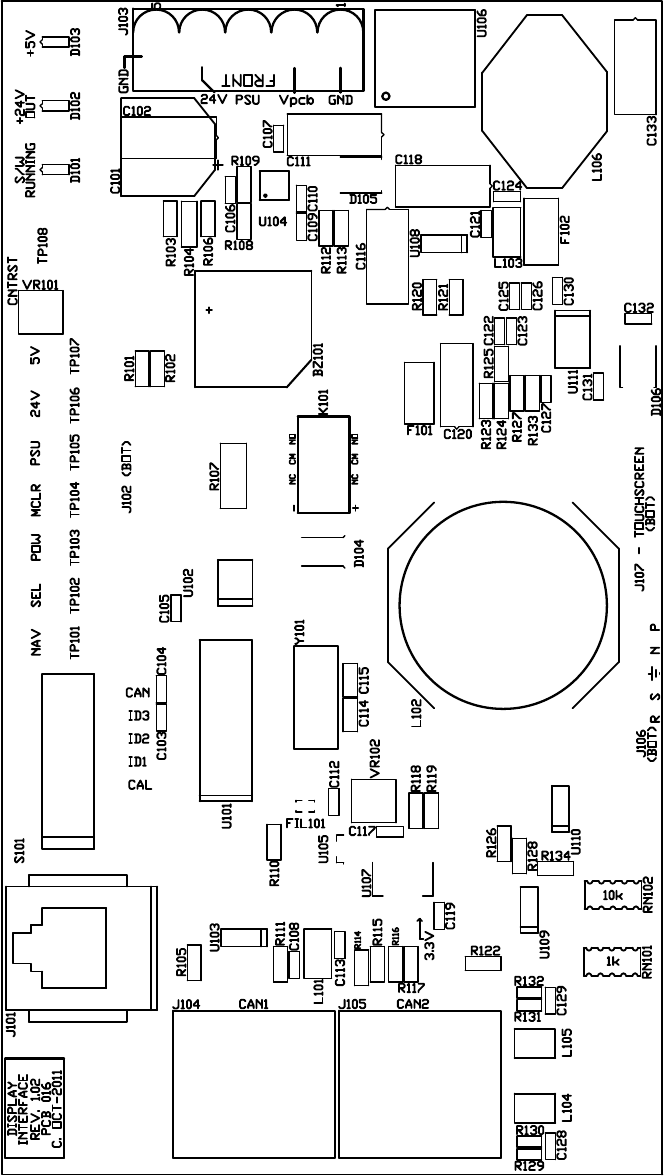
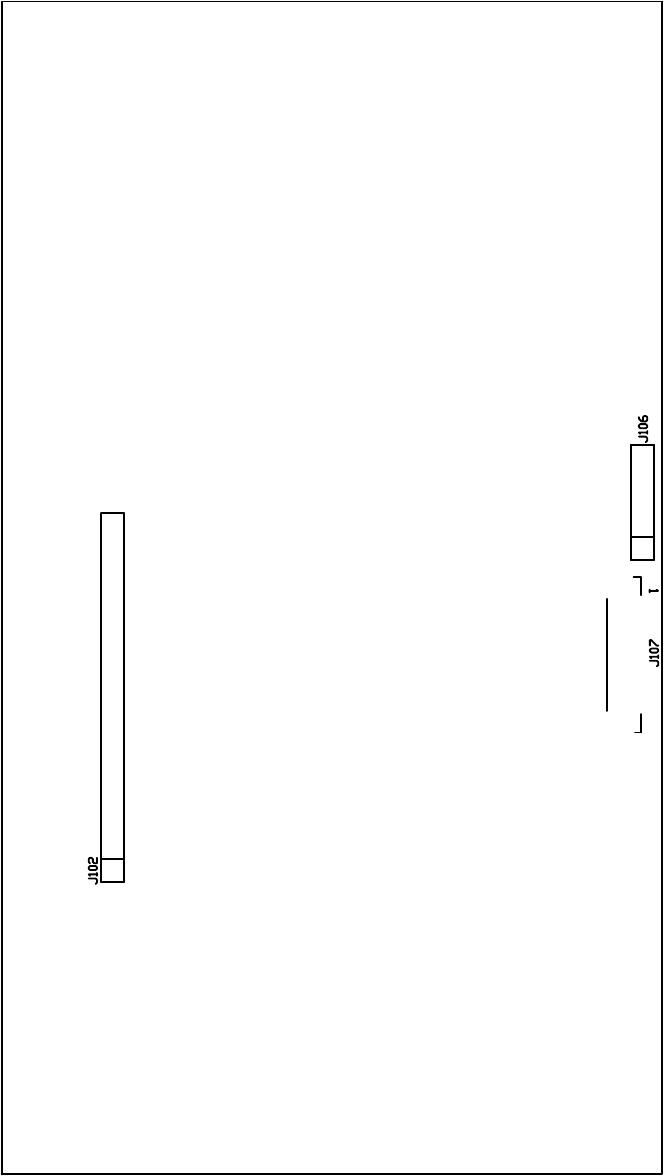
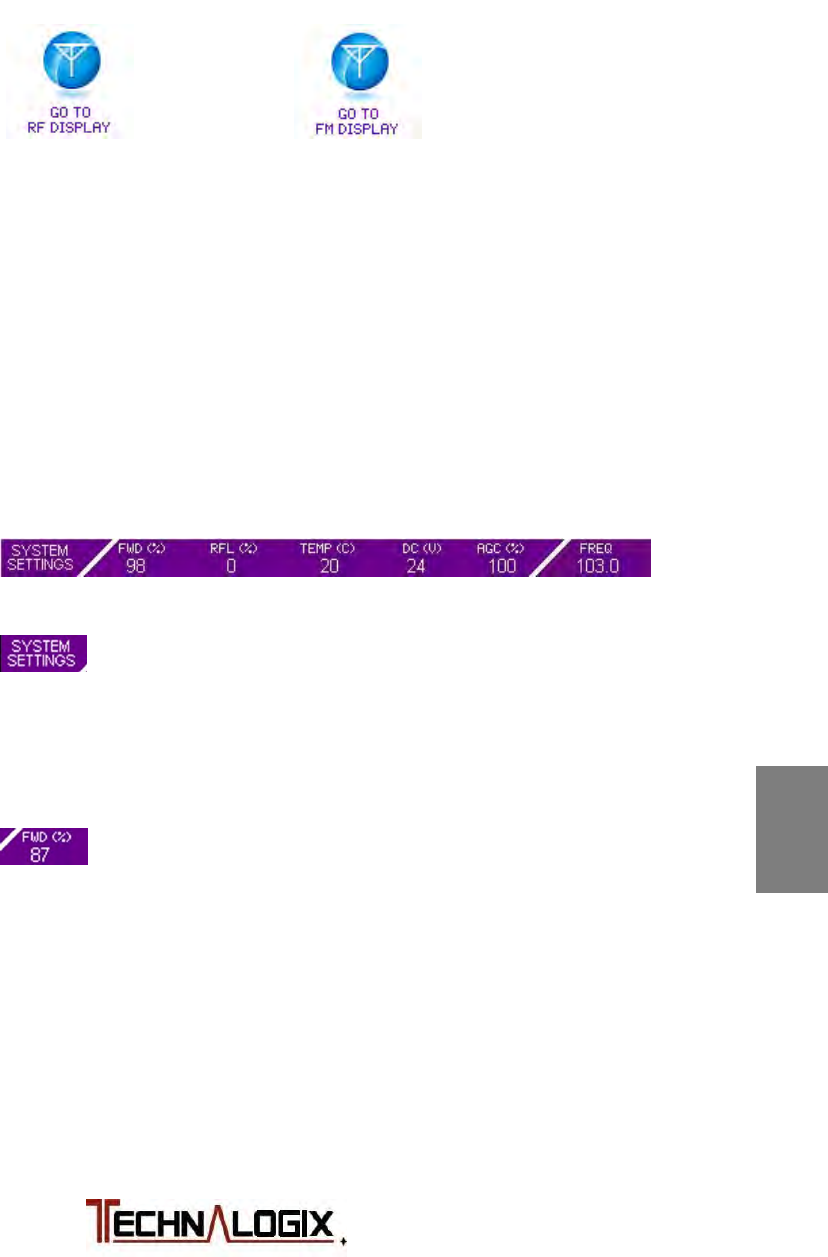
1
Safeguards
2
Terms and
Warranty
3
Principle of
Operation
4
Installation
5
Operation
6
Control System
7
RF Components
8
Power Supply
9
Maintenance
10
Troubleshooting
Main Screens
From each of the two main screens, the RF and the FM main screen, all of the
system’s main parameters can be viewed at a quick glance. To toggle between
these two screens, simply touch:
or
For the Main RF and Main FM screen, there are three common components
between each screen:
Level Bars: The four level bars show real time system performance and
help illustrate any transient changes that occur. Some of the
units of measure can be adjusted in Settings Menu
described later in this section.
Summary Bar: The summary bar at the bottom of the screen will stay in
place no matter what screen is being viewed to allow for an
operating summary at any time, as described below:
Toggles between Main Screens and Menu Screen for
settings. The menu screen has additional settings and
monitoring over the Main Screen, and is illustrated in the
next section.
Forward RF power level in % or watts. Mimics data from
level bar. Overdrive protection starts at 110% where the
power amplifier/transmitter folds back power by adding
attenuation to the input until a safe level obtained. System
continually checks power level and tries to bring RF power
level back to where it was when fault occurred. If overdrive
occurs, a warning is displayed in red text near the top of the
touchscreen and the event recorder logs the event.
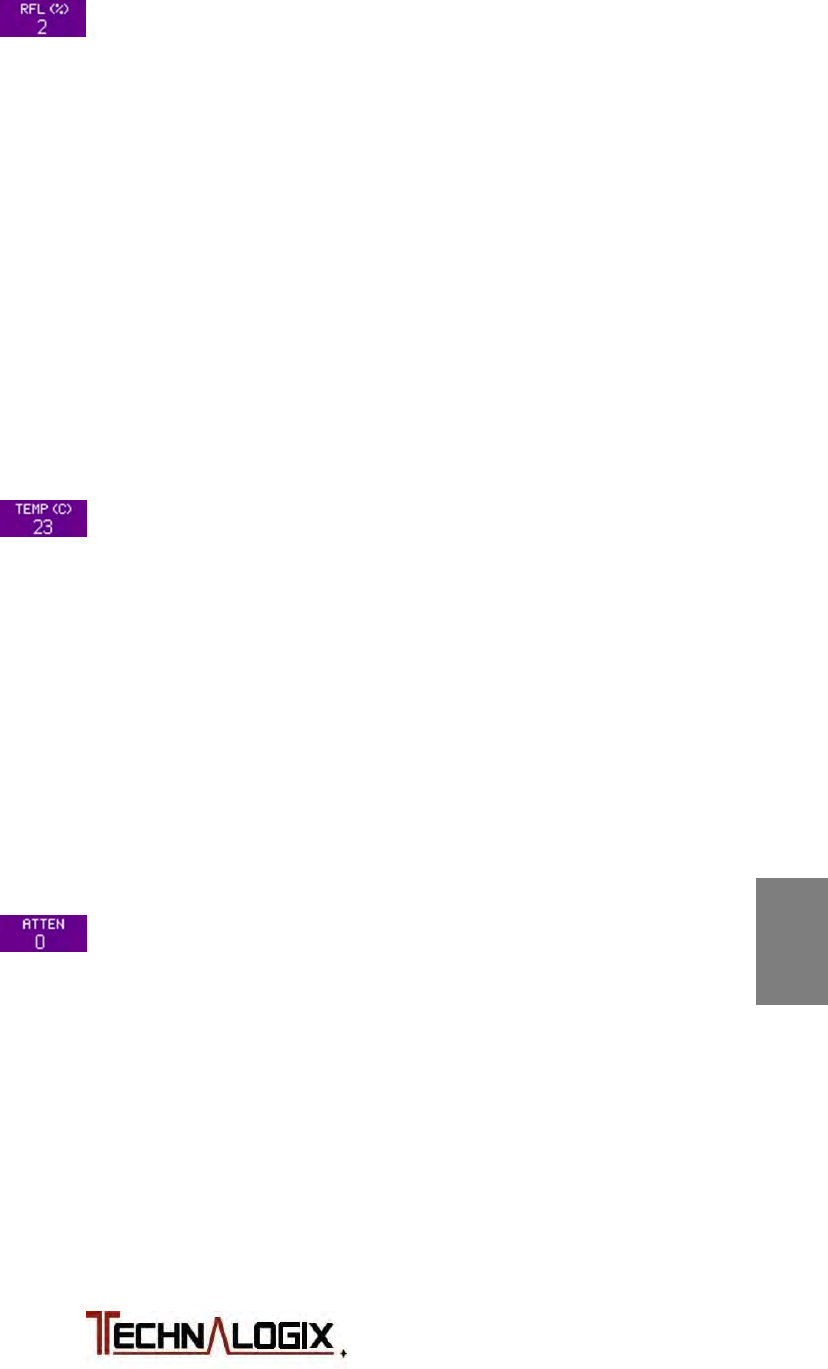
1
Safeguards
2
Terms and
Warranty
3
Principle of
Operation
4
Installation
5
Operation
6
Control System
7
RF Components
8
Power Supply
9
Maintenance
10
Troubleshooting
Reflected RF power level in % or watts. Mimics data from
level bar. The VSWR fault occurs when the measured
VSWR of system exceeds the user-defined VSWR trip point
found in the RF Levels Menu (described later in section). If
VSWR exceeds the shutdown level, but is below 1.8:1 (or a
custom VSWR protection point), then attenuation is added to
the amplifier/transmitter input until a safe level is reached. If
the measured VSWR exceeds 1.8:1 (or a custom VSWR trip
point, then the RF carrier is turned off to protect the
amplifier/transmitter chain. Then the system will continually
check to see if it is safe to come back on. This scheme helps
ensure that the system stays on air as long as possible
before doing a complete shutdown. If high reflected occurs, a
warning is displayed in red text near the top of the
touchscreen and the event recorder logs the event.
Temperature from sensor mounted on heat sink surface.
Shutdown trip point is factory set at a predetermined level to
keep the amplifier/transmitter pallets safe. Should a fan fail
inside the power amplifier/transmitter enclosure, or air
conditioning fails inside the broadcast facility causing the
temperature to exceed the trip point, the control system will
lower forward RF power until a safe level of measured
temperature is achieved. The system will continually try and
bring the RF power back to the same level when the fault
occurred if it is safe to do so, a warning is displayed in red
text near the top of the touchscreen, and the event recorder
logs the event.
RF output power is determined largely in part by the amount
of attenuation that the control system places on the input of
the power amplifier/transmitter. Whether a fault occurs and
attenuation gets added or the user requests a change in RF
power level via the web/SNMP/Remote Port interface, the
attenuation section of the summary bar conveys important
operating information. If the user requests a change in
forward power level via the web interface, SNMP monitoring
and control, or simply via the Remote Port connector on the
back of the enclosure, and an asterisk (*) is placed next to
the attenuation value in the summary bar. This informs the
user whether or not the attenuation was added due to a fault
or simply because it was requested.
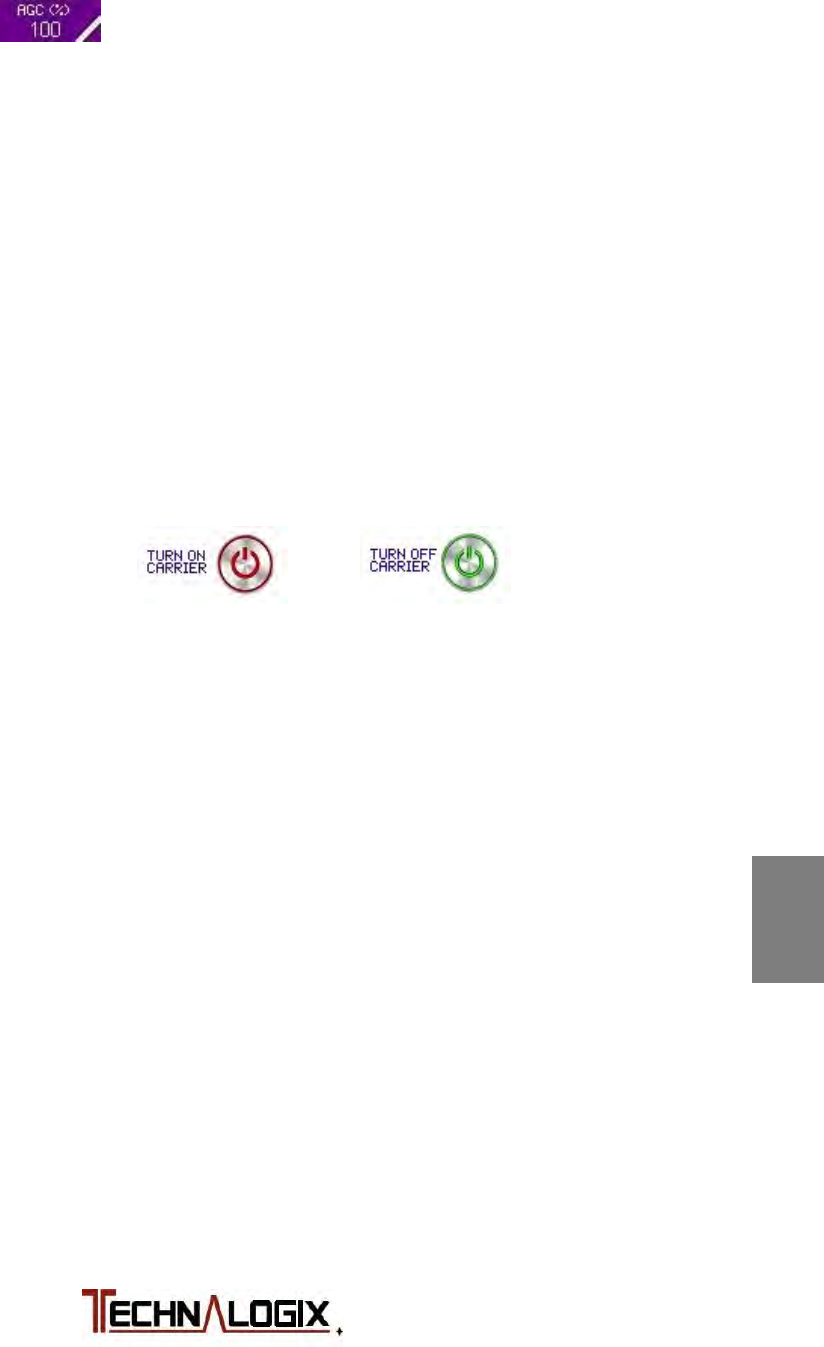
1
Safeguards
2
Terms and
Warranty
3
Principle of
Operation
4
Installation
5
Operation
6
Control System
7
RF Components
8
Power Supply
9
Maintenance
10
Troubleshooting
The AGC sets the desired output power level. This is set on
the RF Levels screen where it can be increased or
decreased by +-1% or +-10% increments. The current AGC
setting is shown in the RF Levels screen and on the bottom
banner. The display can be changed to show in Watts rather
than percent but the step size for setting the AGC will still be
in increments of 1 or 10%.
Carrier Switch: From any screen, the FM amplifier or transmitter carrier can
be turned on or off to facilitate adjustments, settings, and
testing/troubleshooting. To toggle carrier states, simply touch
the switch icon:
The same result occurs by turning on or off the system via
the web or SNMP interface, or through controlling of the
Remote Port. A quick beep from the on-board buzzer
signifies that the response has been taken. The power
supplies and fan will remain active while the carrier is turned
off via this switch.
If additional screens, details, and settings are required, several additional
screens can be accessed through the SYSTEM SETTINGS button described
later in this section.
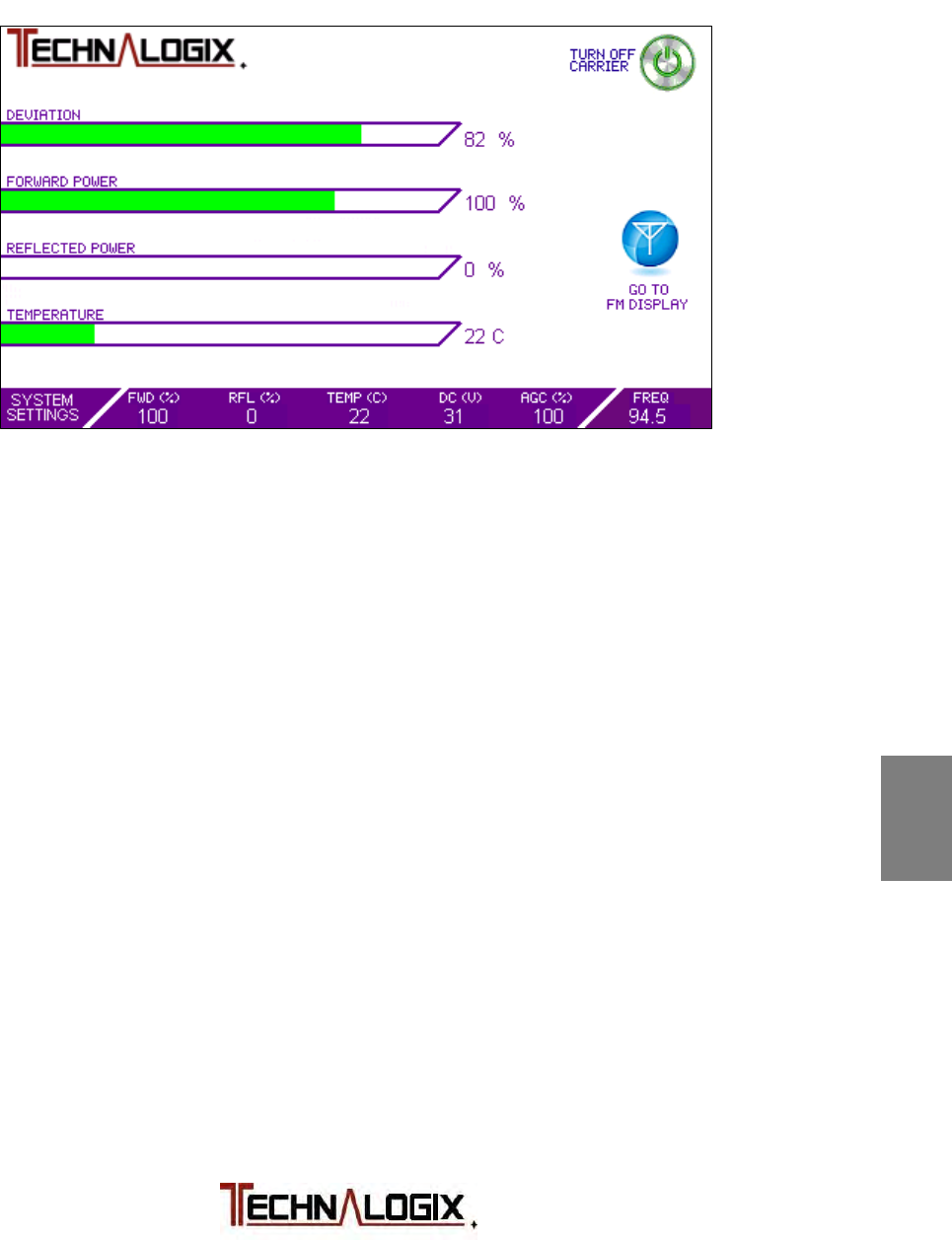
1
Safeguards
2
Terms and
Warranty
3
Principle of
Operation
4
Installation
5
Operation
6
Control System
7
RF Components
8
Power Supply
9
Maintenance
10
Troubleshooting
Main RF Screen
The Main RF Screen summarizes key parameters for the RF carrier of the FM
signal, as illustrated below:
FORWARD POWER: This is the power heading out of the power amplifier or
transmitter to the antenna or load, measured in watts or scaled percentage,
depending on how the units are set in the Settings Screen).
REFLECTED POWER: This is the power coming back in to the power amplifier
or transmitter from the antenna or load, measured in watts or scaled percentage,
depending on how the units are set in the Settings Screen). As there is no
internal circulator or isolator installed within the enclosure, it is important to
minimize VSWR with a good quality antenna installed using proper broadcast
techniques. Ice build-up on the antenna and damages to 50 ohm transmission
line can also generate damaging reflected power.
TEMPERATURE: The temperature is measured on top of the heatsink near the
final transistors and displayed here. User can toggle between Celsius and
Fahrenheit from the Settings Screen. In the event that this temperature exceeds
the factory set trip point, the RF carrier level will fold back to protect the unit.
Common causes for high temperatures can include failed internal fans or air
conditioning in the broadcast facility or a blocked fan.
DC VOLTAGE: The switching power supply DC output voltage is displayed here.
If additional screens, details, and settings are required, several additional
screens can be accessed through the SYSTEM SETTINGS button described
later in this section.
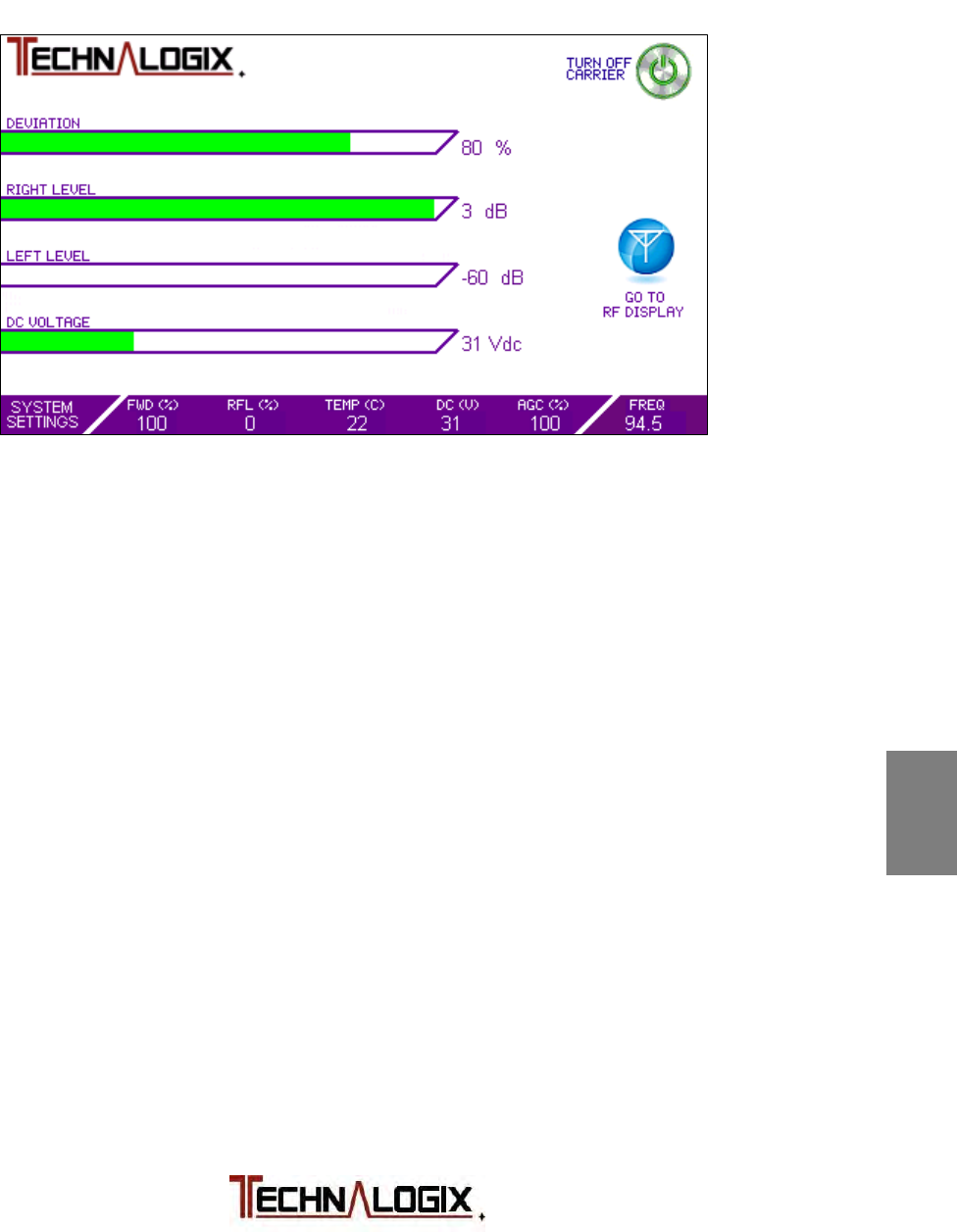
1
Safeguards
2
Terms and
Warranty
3
Principle of
Operation
4
Installation
5
Operation
6
Control System
7
RF Components
8
Power Supply
9
Maintenance
10
Troubleshooting
Main FM Screen
The Main FM Screen summarizes key parameters for the audio that resides on
the RF carrier of the FM signal, as illustrated below:
DEVIATION: The maximum frequency excursion from the carrier center
frequency is illustrated on this level bar. Typical maximum deviation, required by
Industry Canada or FCC, is 75 kHz to avoid bleeding into adjacent channel
bands of 200kHz bandwidths. 100% represents a full 75 kHz deviation.
RIGHT LEVEL: Right level bar represents the audio level on the right audio input
channel.
LEFT LEVEL: Left level bar represents the audio evel on the left audio input
channel.
DC VOLTAGE: The switching power supply DC output voltage is displayed here.
If additional screens, details, and settings are required, several additional
screens can be accessed through the SYSTEM SETTINGS button described
later in this section.
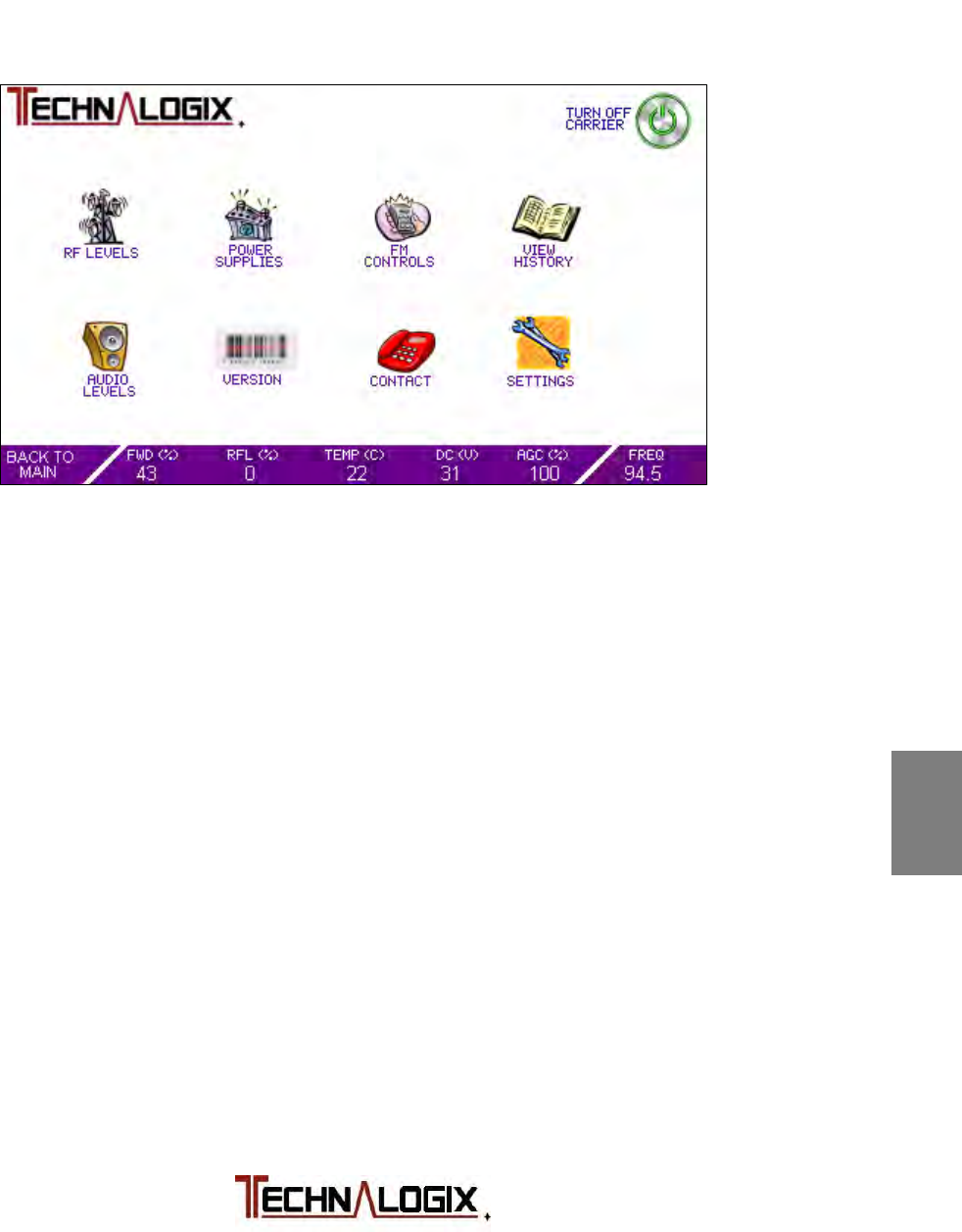
1
Safeguards
2
Terms and
Warranty
3
Principle of
Operation
4
Installation
5
Operation
6
Control System
7
RF Components
8
Power Supply
9
Maintenance
10
Troubleshooting
Menu Screen
The menu screen allows the user to dive into further details of the power amplifier
or transmitter operation. Pressing the BACK TO MAIN button will toggle between
the Main Screens and the Menu Screen. The Menu Screen is shown below:
Each of the menu icons on the Menu Screen allow the user to take additional
readings or make settings that are not provided from the Main RF and FM
Screens. Any changes to settings will be stored in non-volatile memory.
While the user is in the sub menu screens (anything besides the Main Screens),
full monitoring and protection is taking place. This means that as a user makes a
change to a setting or parameter that jeopardizes the power amplifier or
transmitter, the control system will provide protection, display the fault in red text
near the top of the touchscreen, and stay in the current menu.
The individual menu screens will now be covered.
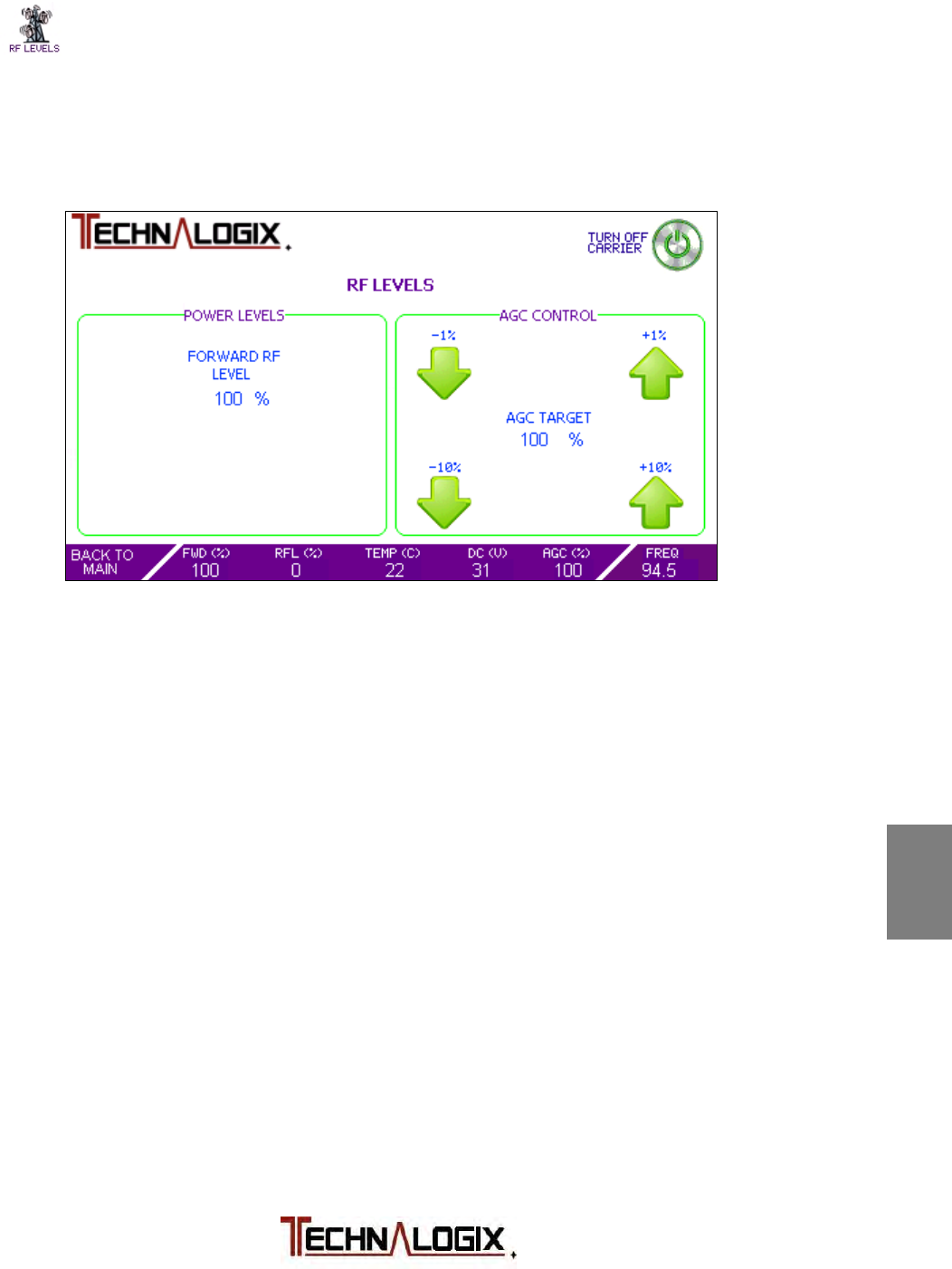
1
Safeguards
2
Terms and
Warranty
3
Principle of
Operation
4
Installation
5
Operation
6
Control System
7
RF Components
8
Power Supply
9
Maintenance
10
Troubleshooting
RF Levels Screen
This screen allows the user to change settings to the RF levels, including the
Forward RF level (the reflected (VSWR) trip point is changed from the Settings
screen. From the RF Levels screen, the user can also toggle between AGC and
Manual mode. The RF Levels Screen is displayed below:
To adjust Forward RF Level:
Press the up or down arrows (in either 1 or 10% increments or decrements) until
the desired Forward RF level is reached. If the adjusted level exceeds 110%, the
protection will kick in and the system will fold back the RF power to a safe level.
There may be a residual amount of Forward RF power even at 0% setting, but it
should be insignificant.
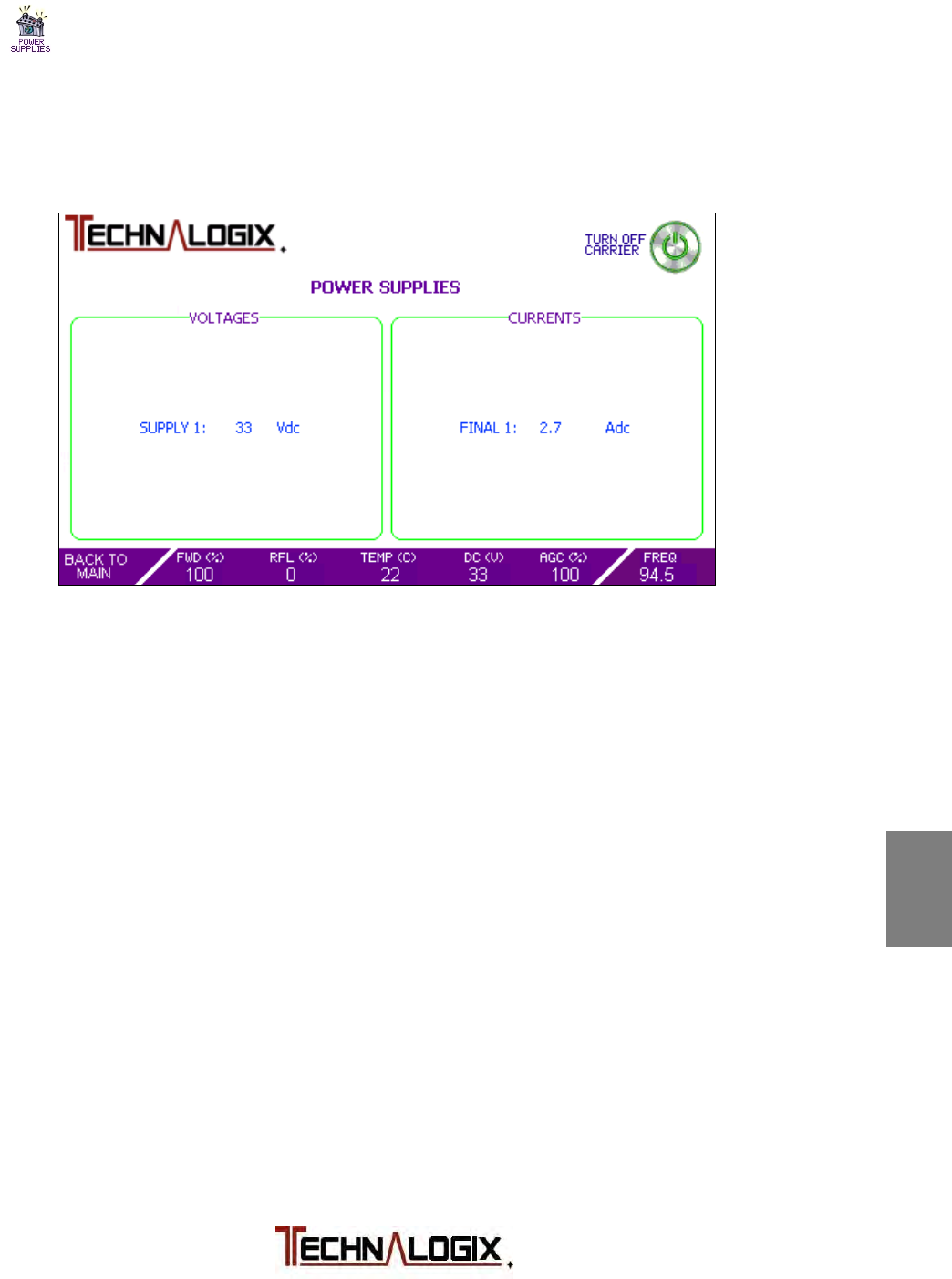
1
Safeguards
2
Terms and
Warranty
3
Principle of
Operation
4
Installation
5
Operation
6
Control System
7
RF Components
8
Power Supply
9
Maintenance
10
Troubleshooting
Power Supplies Screen
This screen allows the user to view individual voltage and current readings. The
Power Supplies Screen is displayed below:
DC supply voltages are nominally 24, 30, or 48Vdc depending on the system.
Readings of this voltage in the Power Supplies Screen, and on the summary bar
at the bottom of the touchscreen, should not vary more than +/- 2%.
If multiple amplifier pallets are included in the amplifier chain, then the individual
currents will all be displayed in the Currents section of the screen. In the case of
multiple pallets in the chain, typically the user should see matching of the final
pallets to within approximately 10%. Anything outside this range is usually a sign
that there may be an issue. Transistor device could be the culprit, or the tragic
spilt-drink-on-amplifier incident. Our team would be glad to walk you through any
troubleshooting issues or questions you may have.
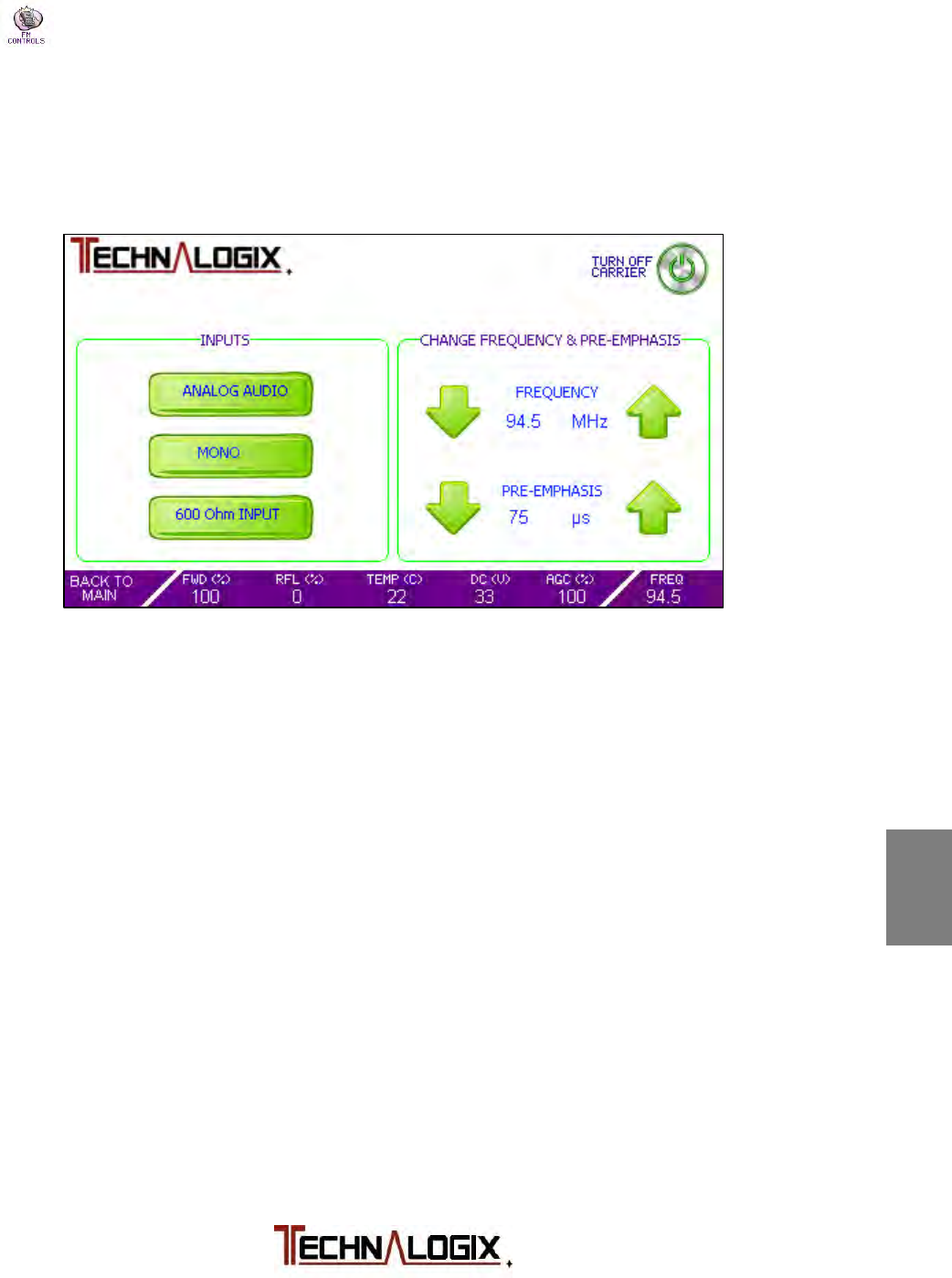
1
Safeguards
2
Terms and
Warranty
3
Principle of
Operation
4
Installation
5
Operation
6
Control System
7
RF Components
8
Power Supply
9
Maintenance
10
Troubleshooting
FM Controls Screen
The FM Controls Screen allows a user to setup audio inputs and FM settings. As
fun as fooling around with the smallest screwdriver you own in the back of a dark
rack sounds, all of these settings can be done from the front touch screen.
Audio Source: As Technalogix FM transmitters include analog and digital
audio inputs as standard, the user can change audio input
sources on the fly and can switch between analog and digital
audio sources. When digital audio is selected, the
Mono/Stereo selection icon changes to allow selection
between the various digital audio inputs (Toslink optical,
coax, AES).
Mono/Stereo: All Technalogix FM transmitters have a stereo encoder built
in to the exciter circuit board. The user can switch between
Mono and Stereo option by simply touching this icon on the
touch screen.
Input Impedance: When analog audio input is selected as a source, the user
can adjust the input impedance of the exciter in the
transmitter between 600 and 10k ohms.

1
Safeguards
2
Terms and
Warranty
3
Principle of
Operation
4
Installation
5
Operation
6
Control System
7
RF Components
8
Power Supply
9
Maintenance
10
Troubleshooting
Frequency: With the exciter being agile, the user can change frequency
from the front touch screen. The step size is 100 kHz. At the
lower and upper frequency limits of the FM band, the
frequency will wrap back around.
Pre-Emphasis: Pre-emphasis adds a boost to high frequencies in the FM
signal to increase the signal above the noise floor. The FM
signal then is de-emphasized at the radio receiver end.
Users can change the amount of pre-emphasis to suit their
location and receivers. A lower pre-emphasis, say 50 us
versus 75 us, is a lighter boost, but also increases high
frequency headroom. Setting the pre-emphasis to 0 us turn
off the pre-emphasis. Standard North American pre-
emphasis is set to 75 us on the transmitter side, while most
of the rest of the world incorporates 50 us.
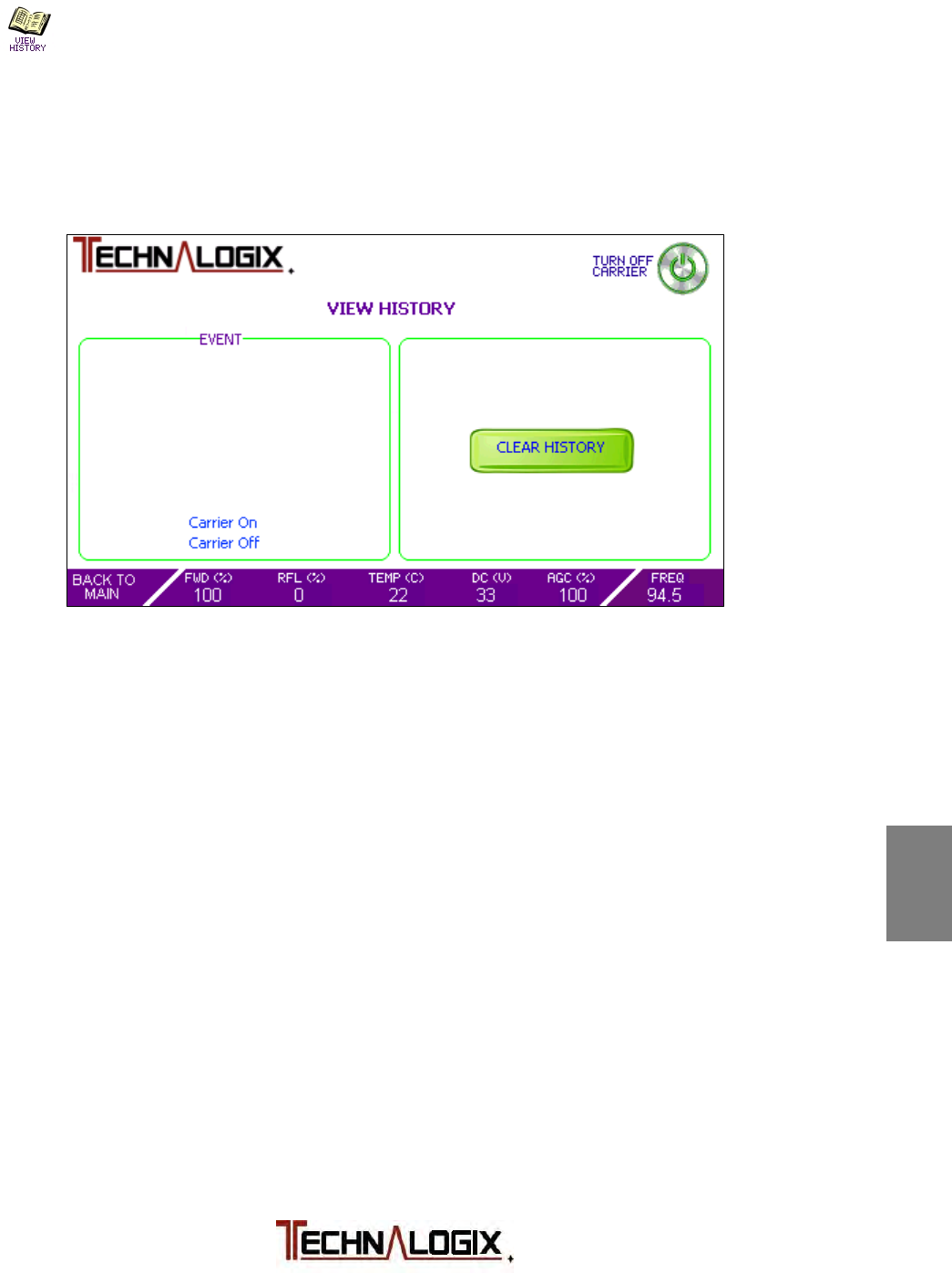
1
Safeguards
2
Terms and
Warranty
3
Principle of
Operation
4
Installation
5
Operation
6
Control System
7
RF Components
8
Power Supply
9
Maintenance
10
Troubleshooting
History Screen
The History Screen provides a summary of the most recent events that have
occurred in the power amplifier or transmitter. An event can either be a fault or
simply an action like turning on or off the carrier. The format of the History Screen
is illustrated below:
Ten of the most recent events are displayed on the History Screen. As more
events occur, the earliest recorded event gets displaced on the screen.
The user can clear the history screen by pressing the CLEAR HISTORY. Users
will find this screen useful in correlating events in the power amplifier or
transmitter with external events like weather and changes to the broadcast
facility’s environment.
The events are recorded in non-volatile memory so they are safe in the event of a
power outage or pesky lightning-strike-wins-fight-with-power-supply.
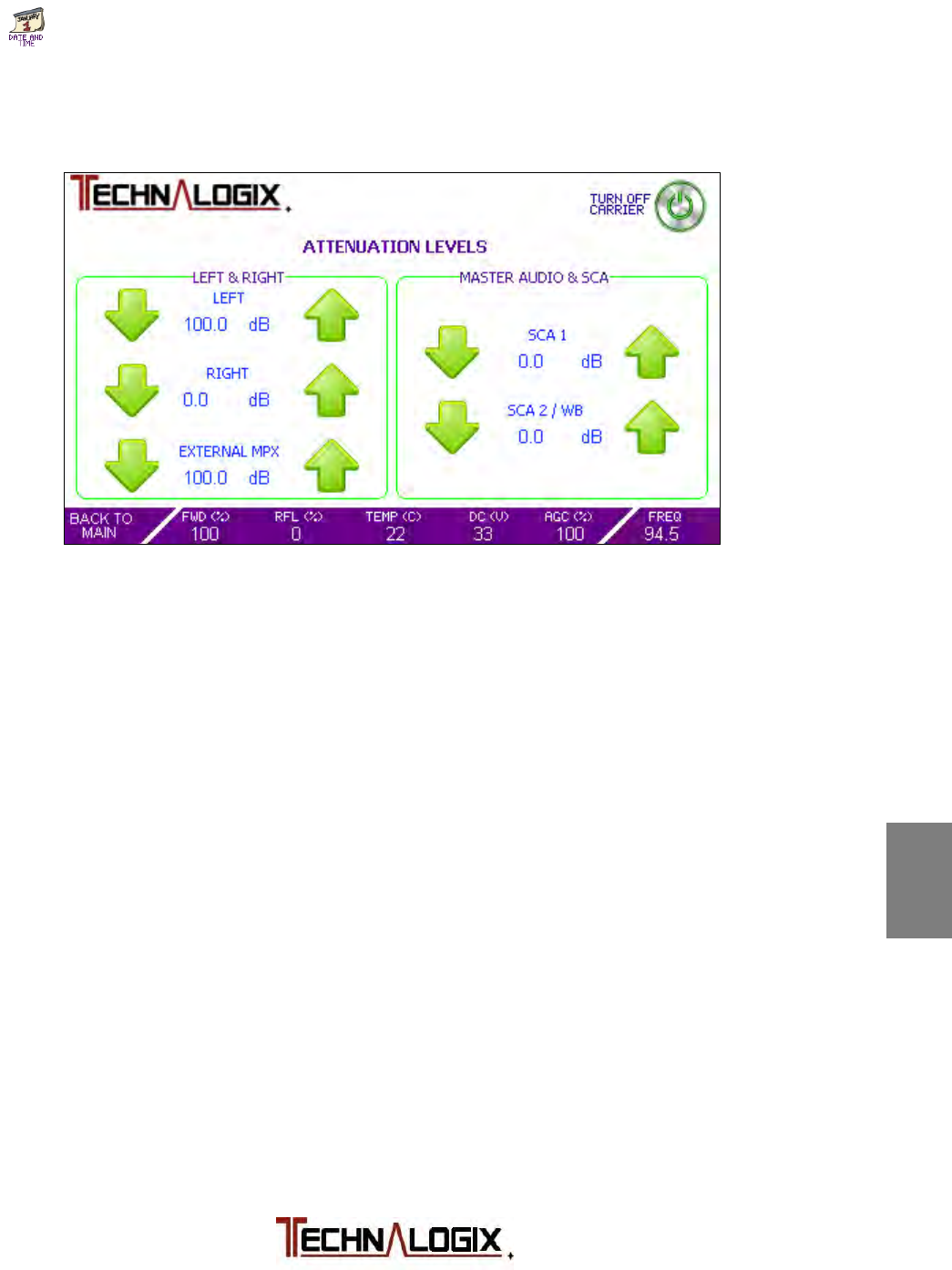
1
Safeguards
2
Terms and
Warranty
3
Principle of
Operation
4
Installation
5
Operation
6
Control System
7
RF Components
8
Power Supply
9
Maintenance
10
Troubleshooting
Audio Levels Screen
The Audio Levels Screen allows the user to tweak audio input levels all from the
front touch screen.
Step sizes will vary from 0.5 dB up to 2.0 dB depending on the current audio,
MPX, and SCA input levels.
Attenuation levels of 100 dB indicate that attenuation is at maximum for that
particular input signal.
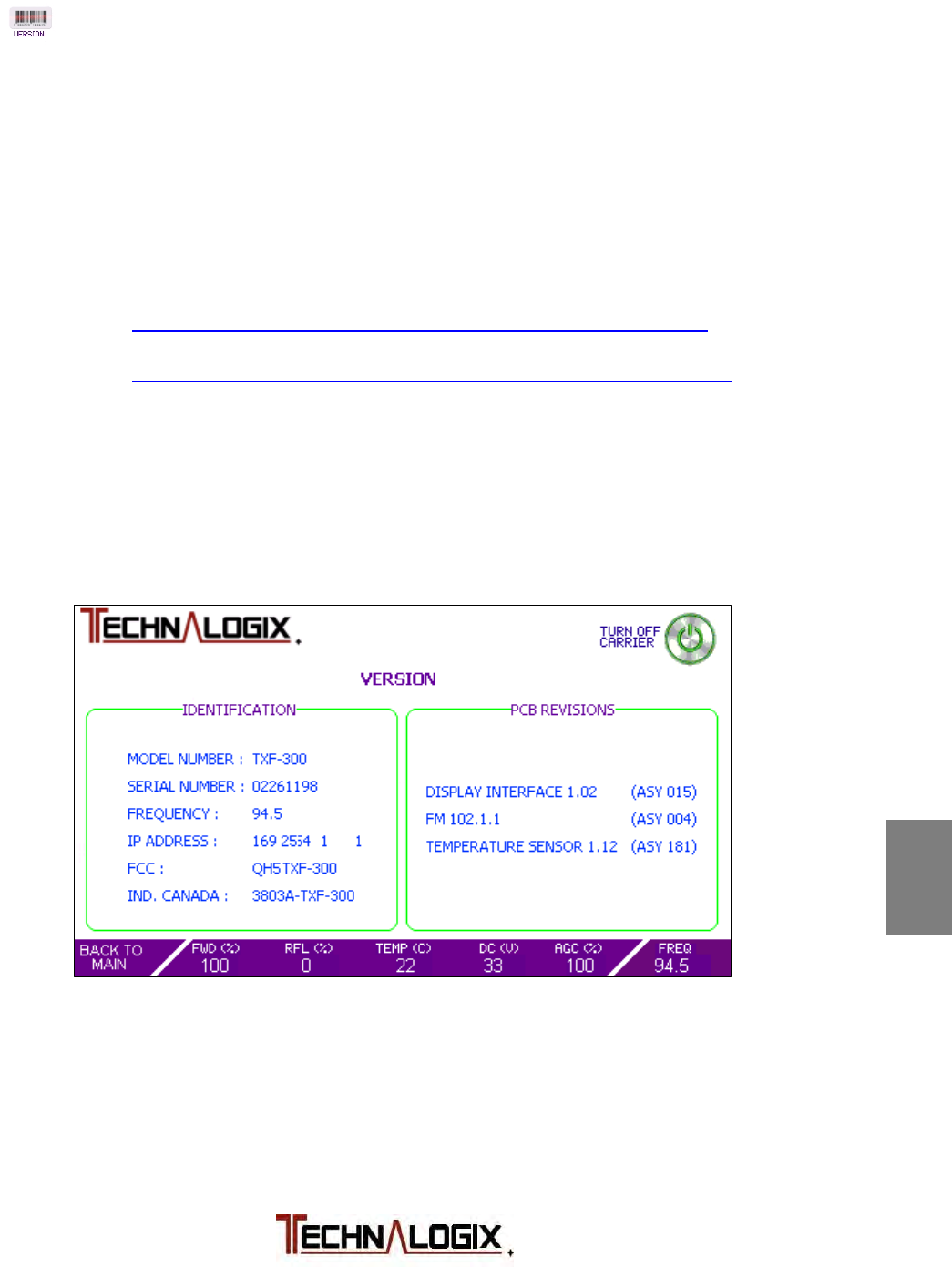
1
Safeguards
2
Terms and
Warranty
3
Principle of
Operation
4
Installation
5
Operation
6
Control System
7
RF Components
8
Power Supply
9
Maintenance
10
Troubleshooting
Version Screen
The Version Screen contains no user-settable items, but is intended as an
identification screen to the user. It also helps Technalogix maintain its unmatched
service reputation by allowing our technicians and Service team to know exactly
what versions of PCBs are inside a customer’s unit, even several years down the
road. The versions can then be correlated to factory documentation. In addition,
current government certification numbers are included for Industry Canada and
FCC. Please contact Technalogix if you require copies of the actual grants, or
visit:
FCC: https://fjallfoss.fcc.gov/oetcf/eas/reports/GenericSearch.cfm
(grantee code QH5)
Ind. Canada: http://www.ic.gc.ca/app/sitt/reltel/srch/nwRdSrch.do?lang=eng
(company 3803)
Finally, general information is included in the Version Screen for users who may
not be familiar with the equipment and do not want to venture into the dusty
abyss behind the rack or cabinet searching for tiny ID tags. The Version Screen
is illustrated below:
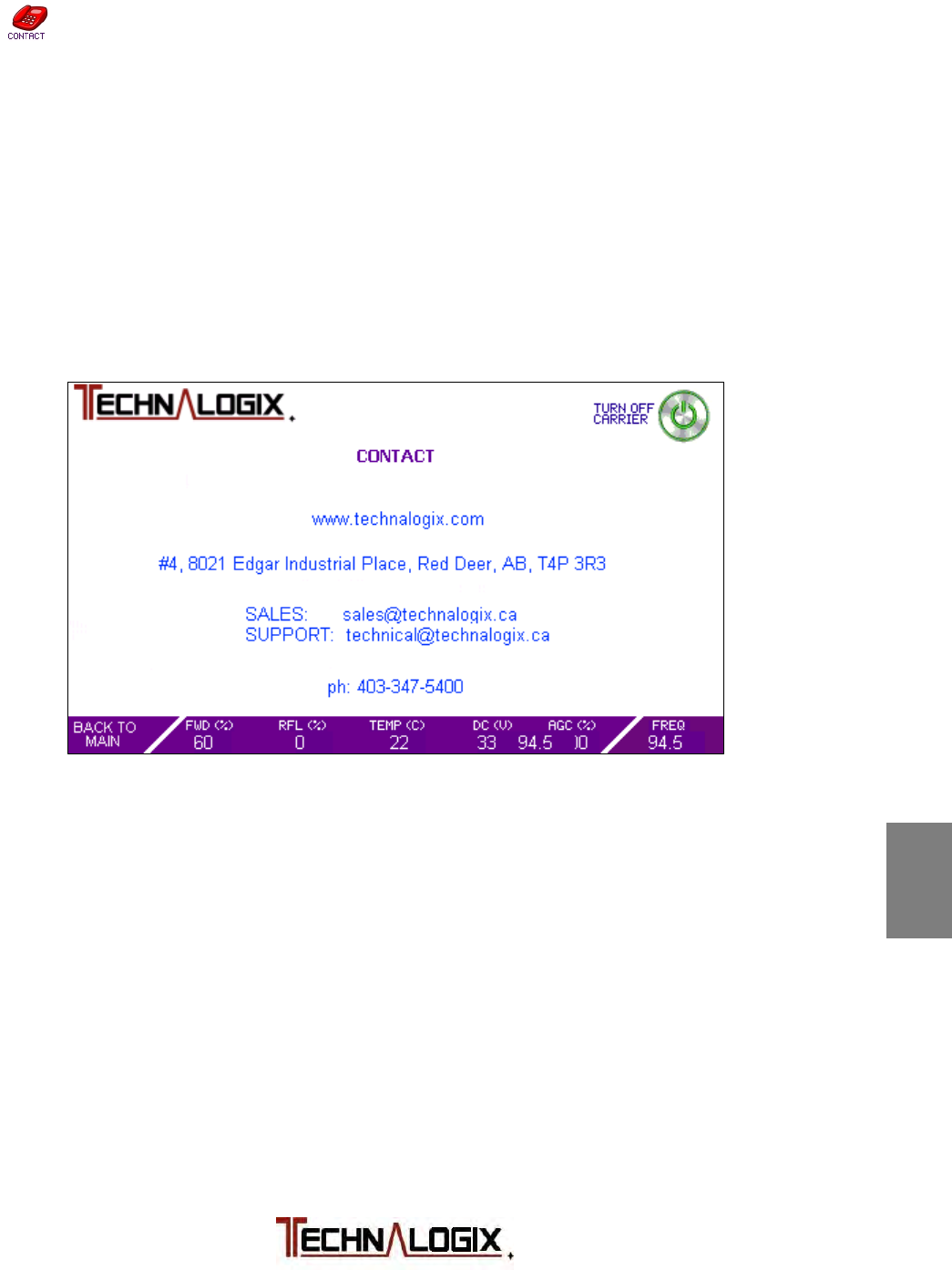
1
Safeguards
2
Terms and
Warranty
3
Principle of
Operation
4
Installation
5
Operation
6
Control System
7
RF Components
8
Power Supply
9
Maintenance
10
Troubleshooting
Contact Screen
The Contact Screen provides an easy means for the user to get in touch with
Technalogix for anything. Whether they have a technical or installation question
or simply want to chat about how gosh darn cool our equipment is, Technalogix
welcomes questions, feedback, and contact.
If you are in the area, please feel free to stop by to tour the facility, test drive
some state of the art products, or get a refresher on some training.
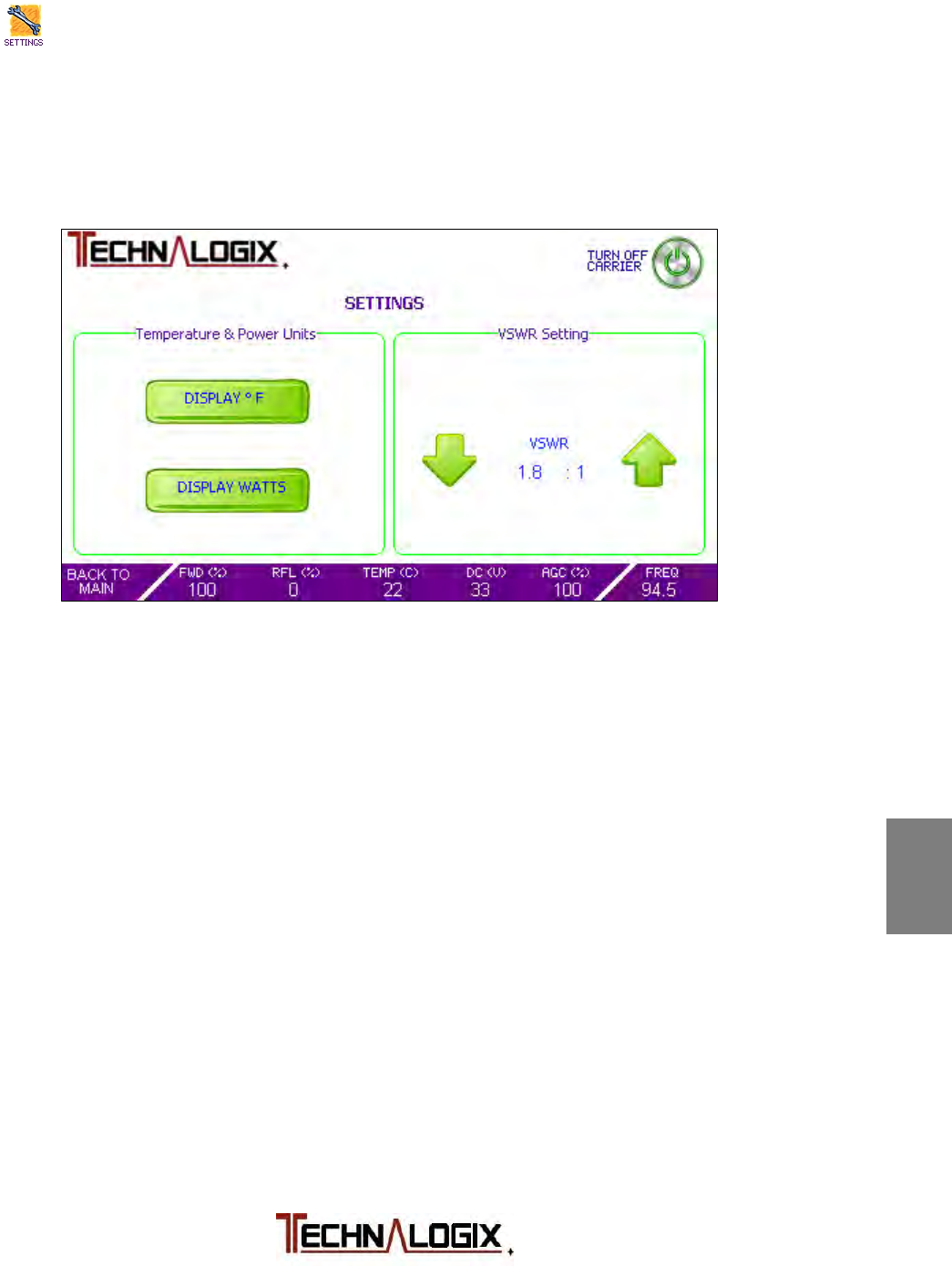
1
Safeguards
2
Terms and
Warranty
3
Principle of
Operation
4
Installation
5
Operation
6
Control System
7
RF Components
8
Power Supply
9
Maintenance
10
Troubleshooting
Settings Screen
“You say tomato...”
The Settings Screen allows the user to modify some of their preferences on how
information is displayed on the touchscreen, as seen in the figure below:
Pressing the DISPLAY ⁰ F button will convert all temperature readings to degrees
Fahrenheit from Celsius (and vice versa). Temperature protection trip points are
factory set.
Similarly, the user can switch between watts or percentage for their RF power
readings. When in percentage mode, the power amplifier or transmitter is
designed for a maximum operating power of 100% with overdrive protection
typically at 110%.
To change the VSWR Shutdown Trip Point:
Use the up and down arrows to set the VSWR shutdown trip point to between
1.1:1 and the factory determined upper limit. If a measured VSWR is found above
the set trip point, but below the factory determined upper limit, then the system
will fold back the forward power to a safe level. If the measured VSWR exceeds
the factory determined upper limit, then the carrier will be initially turned right off.
Technalogix may have provided custom firmware with the amplifier or transmitter
that may deviate from the above operation. Please consult factory for any client-
ordered custom settings.

1
Safeguards
2
Terms and
Warranty
3
Principle of
Operation
4
Installation
5
Operation
6
Control System
7
RF Components
8
Power Supply
9
Maintenance
10
Troubleshooting
FM Exciter Module
REV 1.02 (ASY 0071)
The FM Exciter module accepts analog and digital audio inputs, processes the
audio, and then modulates the audio onto an FM carrier in the range of 87.5 to
108.0 MHz. This modulated signal is then fed into a small gain stage before
passing the signal off to the final gain amplifier stage(s).
Analog input can be balanced or unbalanced, though the former will provide a
higher quality signal. Digital audio can be sourced from AES, S/PDIF optical
(Toslink), or S/PDIF coaxial.
The following pages illustrate the schematics of the FM Exciter module.
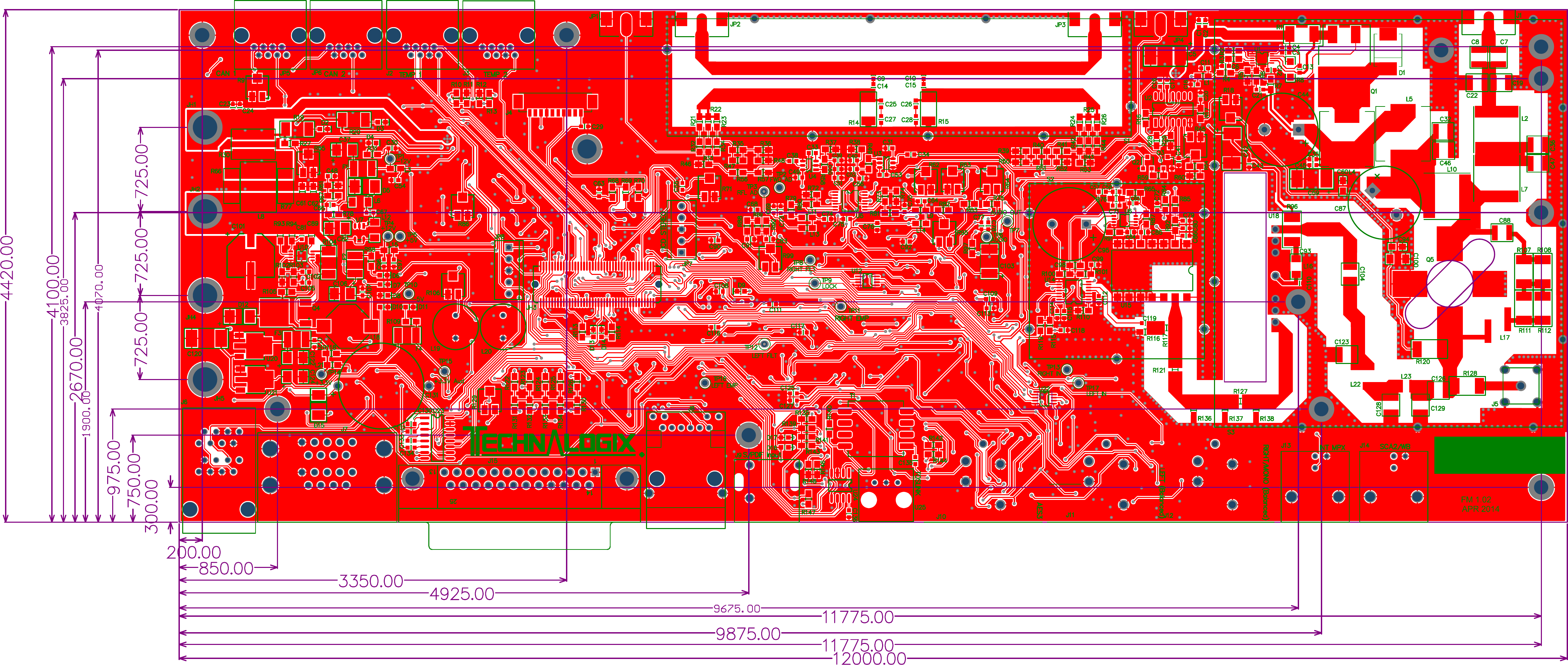
C1
P0C101
P0C102
C2
P0C201
P0C202
C3
P0C301 P0C302
C4
P0C401
P0C402
C5
P0C501
P0C502
C6
P0C601 P0C602
C7
P0C701
P0C702
C8
P0C801
P0C802
C9
P0C901
P0C902
C10
P0C1001
P0C1002
C11
P0C1101
P0C1102
C12
P0C1201
P0C1202 C13
P0C1301
P0C1302
C14
P0C1401
P0C1402
C15
P0C1501
P0C1502
C16
P0C1601
P0C1602
C17
P0C1701
P0C1702
C18
P0C1801 P0C1802 C19
P0C1901
P0C1902
C20
P0C2001
P0C2002 C21
P0C2101 P0C2102 C22
P0C2201
P0C2202
C23
P0C2301
P0C2302
C24
P0C2401
P0C2402 C25
P0C2501
P0C2502 C26
P0C2601
P0C2602
C27
P0C2701
P0C2702 C28
P0C2801
P0C2802
C29
P0C2901
P0C2902
C30
P0C3001 P0C3002
C31
P0C3101 P0C3102
C32
P0C3201
P0C3202
C33
P0C3301 P0C3302 C34
P0C3401
P0C3402
C35
P0C3501 P0C3502
C36
P0C3601
P0C3602
C37
P0C3701
P0C3702
C38
P0C3801 P0C3802
C39
P0C3901 P0C3902
C40
P0C4001 P0C4002
C41
P0C4101
P0C4102
C42
P0C4201
P0C4202 C43
P0C4301
P0C4302
C44
P0C4401
P0C4402
C45 P0C4501 P0C4502 C46
P0C4601
P0C4602
C47
P0C4701
P0C4702
C48
P0C4801
P0C4802 C49
P0C4901 P0C4902
C50
P0C5001 P0C5002
C51
P0C5101 P0C5102
C52
P0C5201 P0C5202
C53
P0C5301 P0C5302
C54
P0C5401
P0C5402
C55
P0C5501
P0C5502 C56
P0C5601
P0C5602
C57
P0C5701
P0C5702
C58
P0C5801
P0C5802
C59
P0C5901
P0C5902
C60
P0C6001 P0C6002
C61
P0C6101 P0C6102
C62
P0C6201 P0C6202
C63
P0C6301
P0C6302
C64
P0C6401 P0C6402 C65
P0C6501 P0C6502
C66
P0C6601
P0C6602
C67
P0C6701
P0C6702
C68
P0C6801
P0C6802
C69
P0C6901
P0C6902
C70
P0C7001
P0C7002
C71
P0C7101
P0C7102
C72
P0C7201
P0C7202
C73
P0C7301
P0C7302
C74
P0C7401 P0C7402
C75
P0C7501
P0C7502
C76
P0C7601 P0C7602
C77
P0C7701
P0C7702
C78
P0C7801
P0C7802
C79
P0C7901 P0C7902
C80
P0C8001 P0C8002
C81
P0C8101
P0C8102
C82
P0C8201
P0C8202
C83
P0C8301
P0C8302 C84
P0C8401 P0C8402 C85
P0C8501 P0C8502
C86
P0C8601 P0C8602
C87
P0C8701
P0C8702
C88
P0C8801
P0C8802
C89
P0C8901 P0C8902
C90
P0C9001 P0C9002 C91
P0C9101 P0C9102
C92
P0C9201 P0C9202
C93
P0C9301 P0C9302
C94
P0C9401 P0C9402
C95
P0C9501 P0C9502
C96
P0C9601
P0C9602
C97
P0C9701
P0C9702 C98
P0C9801 P0C9802
C99
P0C9901
P0C9902
C100
P0C10001
P0C10002
C101
P0C10101 P0C10102
C102
P0C10201 P0C10202
C103
P0C10301
P0C10302
C104
P0C10401
P0C10402
C105
P0C10501
P0C10502 C106
P0C10601
P0C10602
C107
P0C10701
P0C10702 C108
P0C10801
P0C10802 C109
P0C10901 P0C10902
C110
P0C11001 P0C11002
C111
P0C11101
P0C11102
C112
P0C11201
P0C11202
C113
P0C11301
P0C11302
C114
P0C11401
P0C11402
C115
P0C11501
P0C11502
C116
P0C11601 P0C11602 C117
P0C11701
P0C11702
C118
P0C11801 P0C11802
C119
P0C11901 P0C11902
C120
P0C12001
P0C12002
C121
P0C12101
P0C12102
C122
P0C12201
P0C12202
C123
P0C12301
P0C12302
C124
P0C12401
P0C12402
C125
P0C12501 P0C12502
C126
P0C12601
P0C12602
C127
P0C12701 P0C12702
C128
P0C12801
P0C12802 C129
P0C12901
P0C12902
C130
P0C13001 P0C13002
C131
P0C13101
P0C13102
C132
P0C13201 P0C13202
C133
P0C13301 P0C13302
C134
P0C13401 P0C13402
C135
P0C13501
P0C13502
C136
P0C13601
P0C13602
D1
P0D101
P0D102
D2
P0D201 P0D202 D3
P0D301
P0D302
D4
P0D401
P0D402
D5
P0D501
P0D502
D6
P0D601
P0D602
D7
P0D701 P0D702
D8
P0D801 P0D802
D9
P0D901 P0D902
D10
P0D1001 P0D1002 D11
P0D1101 P0D1102
D12
P0D1201
P0D1202
D13 P0D1301 P0D1302
D14 P0D1401 P0D1402
D15
P0D1501
P0D1502
D16 P0D1601 P0D1602
D17 P0D1701 P0D1702
F1
P0F101
P0F102
F2
P0F201
P0F202
F3
P0F301
P0F302
F4
P0F401
P0F402
J1
P0J101
P0J102
J2
P0J200
P0J201
P0J202
P0J203
P0J204
P0J205
P0J206
P0J207
P0J208
J3
P0J300
P0J301
P0J302
P0J303
P0J304
P0J305
P0J306
P0J307
P0J308
J4
P0J400
P0J401
P0J402
P0J403
P0J404
P0J405
P0J406
P0J407
P0J408
P0J409
P0J4010
J5
P0J500
P0J501
J6
P0J600
P0J601
P0J602
P0J603
P0J604
P0J605
P0J606
P0J607
P0J608
P0J609
P0J6010
P0J6011
P0J6012
P0J6013
P0J6014
P0J6015
P0J6016
J7
P0J700
P0J701 P0J702 P0J703 P0J704 P0J705
P0J706 P0J707 P0J708 P0J709
P0J7010
P0J7011
P0J7012
P0J7013
P0J7014
P0J7015 P0J7016 P0J7017 P0J7018
J8
P0J800
P0J801 P0J802 P0J803 P0J804 P0J805 P0J806
P0J807 P0J808 P0J809 P0J8010
P0J8011
J9
P0J900
P0J901
P0J902
P0J903
J10
P0J1000
P0J1001
P0J1002
P0J1003
J11
P0J1100
P0J1101
P0J1102
P0J1103
J12
P0J1200
P0J1201
P0J1202
P0J1203 J13
P0J1300
P0J1301
P0J1302
P0J1303
J14
P0J1400
P0J1401
P0J1402
P0J1403
J15
P0J1500
P0J1501 P0J1502 P0J1503 P0J1504 P0J1505 P0J1506 P0J1507 P0J1508 P0J1509 P0J15010 P0J15011 P0J15012 P0J15013
P0J15014 P0J15015 P0J15016 P0J15017 P0J15018 P0J15019 P0J15020 P0J15021 P0J15022 P0J15023 P0J15024 P0J15025
JH1
P0JH101
JH2
P0JH201
JH3
P0JH300
P0JH301 P0JH302 P0JH303 P0JH304 P0JH305 P0JH306 P0JH307 P0JH308 P0JH309 P0JH3010 P0JH3011 P0JH3012 P0JH3013 P0JH3014 P0JH3015 P0JH3016 P0JH3017 P0JH3018 P0JH3019 P0JH3020 P0JH3021 P0JH3022 P0JH3023 P0JH3024 P0JH3025 P0JH3026 P0JH3027 P0JH3028 P0JH3029 P0JH3030 P0JH3031 P0JH3032 P0JH3033 P0JH3034 P0JH3035 P0JH3036 P0JH3037 P0JH3038 P0JH3039 P0JH3040 P0JH3041 P0JH3042 P0JH3043 P0JH3044 P0JH3045 P0JH3046 P0JH3047 P0JH3048 P0JH3049 P0JH3050 P0JH3051 P0JH3052 P0JH3053 P0JH3054 P0JH3055 P0JH3056 P0JH3057 P0JH3058 P0JH3059 P0JH3060 P0JH3061 P0JH3062 P0JH3063 P0JH3064 P0JH3065 P0JH3066 P0JH3067 P0JH3068 P0JH3069 P0JH3070 P0JH3071 P0JH3072 P0JH3073 P0JH3074 P0JH3075 P0JH3076 P0JH3077 P0JH3078 P0JH3079 P0JH3080
JH4
P0JH401
JH5
P0JH501
JP1
P0JP101
P0JP102
JP2
P0JP201
P0JP202
JP3
P0JP301
P0JP302
JP4
P0JP401
P0JP402
JP5
P0JP500
P0JP501
P0JP502
P0JP503
P0JP504
P0JP505
P0JP506
P0JP507
P0JP508
JP6
P0JP600
P0JP601
P0JP602
P0JP603
P0JP604
P0JP605
P0JP606
P0JP607
P0JP608
JP7
P0JP701
P0JP702 P0JP703
P0JP704
P0JP705
JP8
P0JP801
P0JP802
P0JP803
P0JP804
P0JP805
L1
P0L101 P0L102
L2
P0L201
P0L202
L3
P0L301 P0L302 L4
P0L401
P0L402
L5
P0L501
P0L502
L6
P0L601
P0L602
L7
P0L701
P0L702
L8
P0L801 P0L802
L9
P0L901 P0L902
L10
P0L1001
P0L1002
L11
P0L1101 P0L1102
L12
P0L1201
P0L1202
L13
P0L1301 P0L1302 L14
P0L1401 P0L1402
L15
P0L1501 P0L1502
L16
P0L1601
P0L1602
L17
P0L1701
P0L1702
L18
P0L1801 P0L1802
L19
P0L1901
P0L1902
L20
P0L2001
P0L2002
L21
P0L2101 P0L2102
L22
P0L2201
P0L2202
L23
P0L2301
P0L2302
Q1
P0Q101
P0Q102
P0Q103
Q2
P0Q201
P0Q202
P0Q203
Q3
P0Q301 P0Q302
P0Q303
Q4
P0Q401
P0Q403
P0Q404
Q5
P0Q50D P0Q50G
P0Q50S
R1
P0R101
P0R102
R2
P0R201 P0R202
R3
P0R301 P0R302
R4
P0R401 P0R402
R5
P0R501 P0R502
R6
P0R601 P0R602
R7
P0R701 P0R702
R8
P0R801
P0R802
R9
P0R901
P0R902
P0R903
R10
P0R1001 P0R1002
R11
P0R1101 P0R1102
R12
P0R1201 P0R1202
R13
P0R1301 P0R1302
R14
P0R1401
P0R1402
R15
P0R1501
P0R1502
R16
P0R1601 P0R1602
R17
P0R1701 P0R1702
R18
P0R1801
P0R1802
P0R1803
R19
P0R1901
P0R1902
R20
P0R2001
P0R2002
R21
P0R2101 P0R2102
R22
P0R2201 P0R2202
R23
P0R2301 P0R2302
R24
P0R2401 P0R2402
R25
P0R2501 P0R2502
R26
P0R2601 P0R2602
R27
P0R2701 P0R2702
R28
P0R2801 P0R2802
R29
P0R2901 P0R2902
R30
P0R3001
P0R3002
R31
P0R3101 P0R3102
R32
P0R3201 P0R3202
R33
P0R3301 P0R3302
R34
P0R3401 P0R3402
R35
P0R3501 P0R3502
R36
P0R3601 P0R3602
R37
P0R3701 P0R3702
R38
P0R3801 P0R3802 R39
P0R3901 P0R3902
R40
P0R4001 P0R4002
R41
P0R4101 P0R4102
R42
P0R4201 P0R4202
R43
P0R4301 P0R4302
R44
P0R4401 P0R4402
R45
P0R4501
P0R4502
P0R4503
R46 P0R4601 P0R4602 R47
P0R4701 P0R4702 R48
P0R4801 P0R4802
R49
P0R4901 P0R4902
R50
P0R5001 P0R5002
R51
P0R5101 P0R5102
R52
P0R5201 P0R5202
R53
P0R5301 P0R5302
R54
P0R5401 P0R5402
R55
P0R5501
P0R5502
P0R5503
R56
P0R5601 P0R5602
R57
P0R5701 P0R5702
R58
P0R5801 P0R5802
R59 P0R5901 P0R5902 R60 P0R6001 P0R6002
R61
P0R6101 P0R6102
R62
P0R6201
P0R6202
P0R6203
R63
P0R6301
P0R6302
P0R6303
R64
P0R6401
P0R6402
P0R6403
R65
P0R6501 P0R6502
R66 P0R6601
P0R6602
R67
P0R6701 P0R6702
R68
P0R6801 P0R6802
R69
P0R6901 P0R6902
R70
P0R7001 P0R7002
R71
P0R7101
P0R7102
P0R7103
R72
P0R7201 P0R7202
R73
P0R7301 P0R7302
R74
P0R7401 P0R7402
R75
P0R7501 P0R7502 R76
P0R7601 P0R7602
R77
P0R7701
P0R7702
R78
P0R7801 P0R7802
R79
P0R7901 P0R7902
R80
P0R8001 P0R8002
R81
P0R8101 P0R8102
R82
P0R8201 P0R8202 R83
P0R8301 P0R8302
R84
P0R8401 P0R8402
R85
P0R8501 P0R8502
R86
P0R8601
P0R8602
P0R8603
R87
P0R8701 P0R8702
R88
P0R8801 P0R8802
R89
P0R8901 P0R8902
R90
P0R9001 P0R9002
R91
P0R9101 P0R9102
R92
P0R9201 P0R9202
R93
P0R9301 P0R9302
R94
P0R9401 P0R9402
R95
P0R9501
P0R9502
P0R9503
R96
P0R9601
P0R9602
R97
P0R9701 P0R9702
R98
P0R9801 P0R9802
R99
P0R9901
P0R9902
P0R9903
R100 P0R10001 P0R10002 R101
P0R10101 P0R10102
R102
P0R10201 P0R10202
R103
P0R10301 P0R10302
R104
P0R10401
P0R10402
R105
P0R10501 P0R10502 R106
P0R10601
P0R10602
P0R10603
R107
P0R10701
P0R10702
R108
P0R10801
P0R10802
R109 P0R10901 P0R10902 R110
P0R11001 P0R11002
R111
P0R11101
P0R11102
R112
P0R11201
P0R11202
R113
P0R11301
P0R11302
R114
P0R11401 P0R11402
R115 P0R11501 P0R11502
R116
P0R11601 P0R11602
R117
P0R11701 P0R11702
R118
P0R11801 P0R11802
R119
P0R11901 P0R11902
R120
P0R12001
P0R12002
R121
P0R12101 P0R12102
R122
P0R12201 P0R12202
R123
P0R12301 P0R12302
R124
P0R12401 P0R12402
R125
P0R12501 P0R12502
R126
P0R12601 P0R12602
R127
P0R12701 P0R12702
R128
P0R12801
P0R12802
R129
P0R12901
P0R12902
P0R12903
R130
P0R13001 P0R13002
R131 P0R13101 P0R13102
R132 P0R13201 P0R13202
R133 P0R13301 P0R13302
R134 P0R13401 P0R13402
R135
P0R13501 P0R13502 R136
P0R13601 P0R13602
R137
P0R13701 P0R13702
R138
P0R13801 P0R13802
R139
P0R13901 P0R13902
R140
P0R14001 P0R14002
R141
P0R14101 P0R14102 R142
P0R14201 P0R14202
R143
P0R14301 P0R14302
R144
P0R14401 P0R14402
R145
P0R14501 P0R14502
R146
P0R14601 P0R14602
R147
P0R14701
P0R14702
S1
P0S100
S2
P0S200
S3
P0S300
T1
P0T101
P0T102
P0T103
P0T104 P0T105
P0T106
P0T107
P0T108
TP1
P0TP101
TP2
P0TP201
TP3
P0TP301
TP4
P0TP401
TP5
P0TP501
TP6
P0TP601
TP7
P0TP701
TP8
P0TP801
TP9
P0TP901
TP10
P0TP1001
TP11
P0TP1101
TP12
P0TP1201
TP13
P0TP1301
TP14
P0TP1401
TP15
P0TP1501
TP16
P0TP1601
TP17
P0TP1701
U1
P0U101
P0U102
P0U103
P0U104
P0U105 P0U106
P0U107
P0U108
P0U109
P0U1010
U2
P0U201
P0U202
P0U203
P0U204
P0U205
P0U206
P0U207 P0U208
P0U209
P0U2010
P0U2011
P0U2012
P0U2013
P0U2014
U3
P0U301
P0U302
P0U303 P0U304
P0U305
P0U306
U4
P0U401
P0U402
P0U403 P0U404
P0U405
P0U406
U5
P0U501
P0U502
P0U503
P0U504
P0U505
P0U506
P0U507 P0U508
P0U509
P0U5010
P0U5011
P0U5012
P0U5013
P0U5014
U6
P0U601
P0U602
P0U603
P0U604 P0U605
P0U606
P0U607
P0U608
U7
P0U701
P0U702
P0U703 P0U704
P0U705
U8
P0U807
U9
P0U906
U10
P0U1001
P0U1002
P0U1003
P0U1004 P0U1005
P0U1006
P0U1007
P0U1008
P0U1009
U11
P0U1105
U12
P0U1201
P0U1202
P0U1203
P0U1204 P0U1205
P0U1206
P0U1207
P0U1208
U13
P0U1304
U14
P0U1401
P0U1402
P0U1403
P0U1404
P0U1405
P0U1406
P0U1407
P0U1408 P0U1409
P0U14010
P0U14011
P0U14012
P0U14013
P0U14014
P0U14015
P0U14016 U15
P0U1501
P0U1502 P0U1503
P0U1504
P0U1505 P0U1506 P0U1507
P0U1508 P0U1509 P0U15010
P0U15011
P0U15012 P0U15013
P0U15014
U16
P0U1603
U17
P0U1702
U18
P0U1801
P0U1802
P0U1803
P0U1804
P0U1805
P0U1806
P0U1807
U19
P0U1901
U20
P0U2001
P0U2002
P0U2003
U21
P0U2101
P0U2102
P0U2103 U22
P0U2201
P0U2202
P0U2203
P0U2204 P0U2205
P0U2206
P0U2207
P0U2208
U23
P0U2301
P0U2302
P0U2303
P0U2304
P0U2305
P0U2306
P0U2307
P0U2308 P0U2309
P0U23010
P0U23011
P0U23012
P0U23013
P0U23014
P0U23015
P0U23016
U24
P0U2401
P0U2402
P0U2403
P0U2404 P0U2405
P0U2406
P0U2407
P0U2408
U25
P0U2500
P0U2501 P0U2502 P0U2503
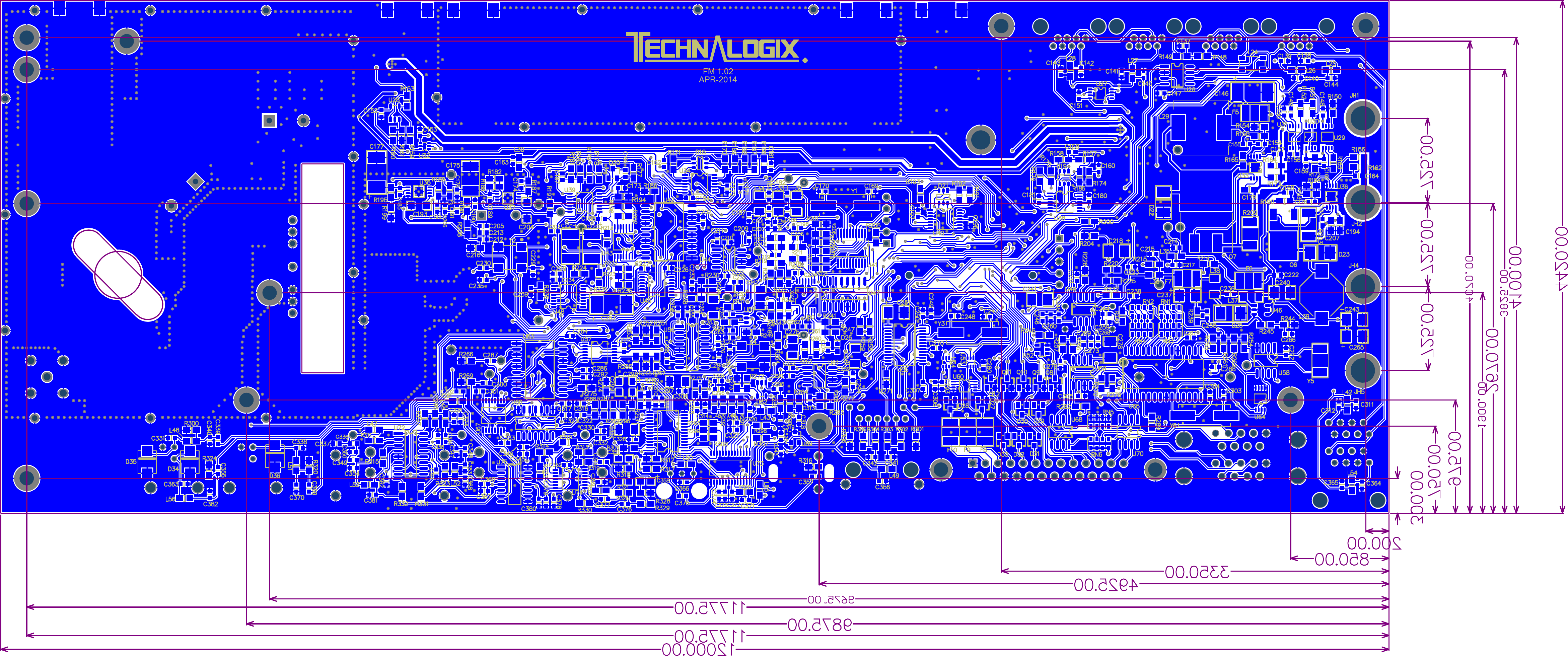
C137
P0C13701
P0C13702
C138
P0C13801 P0C13802
C139
P0C13901 P0C13902
C140
P0C14001 P0C14002
C141
P0C14101
P0C14102
C142
P0C14201
P0C14202
C143
P0C14301
P0C14302
C144
P0C14401 P0C14402
C145
P0C14501
P0C14502
C146
P0C14601
P0C14602
C147
P0C14701
P0C14702
C148
P0C14801
P0C14802
C149
P0C14901
P0C14902
C150
P0C15001
P0C15002
C151
P0C15101
P0C15102
C152
P0C15201
P0C15202
C153
P0C15301
P0C15302
C154
P0C15401
P0C15402
C155
P0C15501
P0C15502
C156
P0C15601
P0C15602
C157
P0C15701
P0C15702
C158
P0C15801 P0C15802
C159
P0C15901
P0C15902
C160
P0C16001
P0C16002
C161
P0C16101
P0C16102
C162
P0C16201
P0C16202
C163
P0C16301
P0C16302
C164
P0C16401
P0C16402
C165
P0C16501
P0C16502
C166
P0C16601
P0C16602
C167
P0C16701
P0C16702
C168
P0C16801
P0C16802
C169
P0C16901
P0C16902
C170
P0C17001
P0C17002
C171
P0C17101
P0C17102
C172
P0C17201
P0C17202
C173
P0C17301 P0C17302
C174
P0C17401
P0C17402
C175
P0C17501
P0C17502
C176
P0C17601
P0C17602
C177
P0C17701
P0C17702
C178 P0C17801 P0C17802
C179
P0C17901 P0C17902
C180
P0C18001
P0C18002
C181
P0C18101
P0C18102
C182
P0C18201
P0C18202
C183
P0C18301 P0C18302
C184
P0C18401 P0C18402
C185
P0C18501
P0C18502
C186
P0C18601
P0C18602
C187
P0C18701
P0C18702
C188
P0C18801 P0C18802
C189
P0C18901
P0C18902
C190
P0C19001
P0C19002
C191
P0C19101
P0C19102
C192
P0C19201
P0C19202
C193
P0C19301 P0C19302
C194
P0C19401 P0C19402
C195
P0C19501
P0C19502
C196
P0C19601
P0C19602
C197
P0C19701
P0C19702
C198
P0C19801 P0C19802
C199
P0C19901
P0C19902
C200
P0C20001
P0C20002
C201
P0C20101
P0C20102
C202
P0C20201
P0C20202
C203
P0C20301 P0C20302
C204
P0C20401
P0C20402
C205
P0C20501
P0C20502
C206
P0C20601
P0C20602
C207
P0C20701 P0C20702
C208
P0C20801
P0C20802
C209
P0C20901
P0C20902
C210
P0C21001 P0C21002
C211
P0C21101 P0C21102
C212
P0C21201
P0C21202
C213
P0C21301 P0C21302
C214
P0C21401
P0C21402
C215
P0C21501 P0C21502
C216
P0C21601 P0C21602
C217
P0C21701
P0C21702
C218
P0C21801
P0C21802
C219
P0C21901
P0C21902
C220
P0C22001
P0C22002
C221
P0C22101
P0C22102
C222
P0C22201 P0C22202
C223
P0C22301 P0C22302
C224
P0C22401
P0C22402
C225
P0C22501 P0C22502
C226
P0C22601 P0C22602
C227
P0C22701
P0C22702
C228
P0C22801
P0C22802
C229
P0C22901
P0C22902
C230
P0C23001
P0C23002
C231
P0C23101
P0C23102
C232
P0C23201
P0C23202
C233
P0C23301
P0C23302
C234
P0C23401 P0C23402
C235
P0C23501 P0C23502
C236
P0C23601
P0C23602
C237
P0C23701
P0C23702
C238
P0C23801 P0C23802
C239
P0C23901
P0C23902
C240
P0C24001
P0C24002
C241
P0C24101
P0C24102
C242
P0C24201
P0C24202 C243
P0C24301
P0C24302
C244
P0C24401 P0C24402
C245
P0C24501
P0C24502
C246
P0C24601
P0C24602
C247
P0C24701
P0C24702
C248
P0C24801
P0C24802
C249
P0C24901
P0C24902
C250
P0C25001
P0C25002
C251
P0C25101
P0C25102
C252
P0C25201 P0C25202
C253
P0C25301
P0C25302
C254
P0C25401
P0C25402
C255
P0C25501
P0C25502
C256
P0C25601
P0C25602
C257
P0C25701
P0C25702
C258
P0C25801
P0C25802
C259
P0C25901 P0C25902
C260
P0C26001
P0C26002
C261
P0C26101 P0C26102
C262
P0C26201 P0C26202
C263
P0C26301 P0C26302
C264
P0C26401 P0C26402
C265
P0C26501
P0C26502
C266
P0C26601 P0C26602
C267
P0C26701
P0C26702
C268
P0C26801
P0C26802
C269
P0C26901 P0C26902
C270
P0C27001 P0C27002
C271
P0C27101
P0C27102
C272
P0C27201
P0C27202
C273
P0C27301
P0C27302
C274
P0C27401
P0C27402
C275
P0C27501
P0C27502
C276
P0C27601 P0C27602
C277
P0C27701
P0C27702
C278
P0C27801
P0C27802
C279
P0C27901
P0C27902
C280
P0C28001
P0C28002
C281
P0C28101
P0C28102
C282
P0C28201 P0C28202
C283
P0C28301
P0C28302
C284
P0C28401
P0C28402
C285
P0C28501
P0C28502
C286
P0C28601 P0C28602
C287
P0C28701 P0C28702
C288
P0C28801
P0C28802
C289
P0C28901 P0C28902
C290
P0C29001
P0C29002
C291
P0C29101
P0C29102
C292
P0C29201 P0C29202
C293
P0C29301
P0C29302
C294
P0C29401
P0C29402
C295
P0C29501
P0C29502
C296
P0C29601
P0C29602
C297
P0C29701
P0C29702
C298
P0C29801 P0C29802
C299
P0C29901 P0C29902
C300
P0C30001 P0C30002
C301
P0C30101 P0C30102 C302 P0C30201 P0C30202 C303
P0C30301
P0C30302
C304
P0C30401
P0C30402
C305
P0C30501
P0C30502
C306
P0C30601
P0C30602
C307
P0C30701
P0C30702
C308
P0C30801 P0C30802
C309
P0C30901
P0C30902
C310
P0C31001
P0C31002
C311
P0C31101
P0C31102
C312
P0C31201
P0C31202
C313
P0C31301
P0C31302
C314
P0C31401
P0C31402
C315
P0C31501
P0C31502
C316
P0C31601 P0C31602
C317
P0C31701 P0C31702
C318
P0C31801
P0C31802
C319
P0C31901
P0C31902
C320
P0C32001
P0C32002
C321
P0C32101
P0C32102
C322
P0C32201
P0C32202
C323
P0C32301 P0C32302
C324
P0C32401
P0C32402
C325
P0C32501
P0C32502
C326
P0C32601
P0C32602
C327
P0C32701 P0C32702
C328
P0C32801
P0C32802
C329
P0C32901
P0C32902
C330
P0C33001
P0C33002
C331
P0C33101 P0C33102 C332
P0C33201 P0C33202
C333
P0C33301
P0C33302
C334
P0C33401
P0C33402
C335
P0C33501
P0C33502
C336
P0C33601
P0C33602
C337
P0C33701
P0C33702
C338
P0C33801
P0C33802
C339
P0C33901
P0C33902
C340
P0C34001
P0C34002
C341
P0C34101
P0C34102
C342
P0C34201
P0C34202
C343
P0C34301
P0C34302
C344
P0C34401
P0C34402
C345
P0C34501 P0C34502
C346
P0C34601
P0C34602
C347
P0C34701
P0C34702
C348
P0C34801
P0C34802
C349
P0C34901 P0C34902
C350
P0C35001
P0C35002 C351
P0C35101 P0C35102
C352
P0C35201
P0C35202
C353
P0C35301
P0C35302
C354
P0C35401 P0C35402
C355
P0C35501
P0C35502
C356
P0C35601
P0C35602
C357
P0C35701 P0C35702
C358
P0C35801 P0C35802
C359
P0C35901
P0C35902
C360
P0C36001 P0C36002
C361
P0C36101
P0C36102
C362
P0C36201
P0C36202
C363
P0C36301 P0C36302 C364
P0C36401 P0C36402
C365
P0C36501
P0C36502
C366
P0C36601
P0C36602
C367
P0C36701 P0C36702
C368
P0C36801
P0C36802
C369
P0C36901
P0C36902
C370
P0C37001
P0C37002
C371
P0C37101
P0C37102
C372
P0C37201
P0C37202
C373
P0C37301 P0C37302
C374
P0C37401
P0C37402
C375
P0C37501
P0C37502
C376
P0C37601
P0C37602
C377
P0C37701
P0C37702
C378
P0C37801
P0C37802
C379
P0C37901
P0C37902
C380
P0C38001
P0C38002
C381
P0C38101
P0C38102
C382
P0C38201
P0C38202
D18
P0D1801
P0D1802
P0D1803 P0D1804
P0D1805
P0D1806
D19
P0D1901
P0D1902
P0D1903 P0D1904
P0D1905
P0D1906
D20
P0D2001
P0D2002
P0D2003
D21
P0D2101
P0D2102
P0D2103 P0D2104
P0D2105
P0D2106
D22
P0D2201
P0D2202
D23
P0D2301
P0D2302
D24
P0D2401 P0D2402
D25
P0D2501
P0D2502
D26
P0D2601
P0D2602
D27
P0D2701
P0D2702
P0D2703
D28
P0D2801
P0D2802
P0D2803
D29
P0D2901
P0D2902
P0D2903
D30
P0D3001
P0D3002
P0D3003
D31
P0D3101
P0D3102
P0D3103
D32
P0D3201
P0D3202
P0D3203
D33
P0D3301
P0D3302
P0D3303
D34 P0D3401
P0D3402
D35
P0D3501
P0D3502
D36
P0D3601
P0D3602
F5
P0F501
P0F502
F6
P0F601
P0F602
F7
P0F701
P0F702
F8
P0F801
P0F802
F9
P0F901
P0F902
F10
P0F1001
P0F1002
FM 1
L24
P0L2401
P0L2402 P0L2403
P0L2404 L25
P0L2501 P0L2502
L26
P0L2601 P0L2602
L27
P0L2701 P0L2702
L28
P0L2801 P0L2802
L29
P0L2901
P0L2902
L30
P0L3001 P0L3002
L31
P0L3101 P0L3102
L32
P0L3201
P0L3202
L33
P0L3301
P0L3302
L34
P0L3401
P0L3402
L35
P0L3501 P0L3502
L36
P0L3601 P0L3602
L37
P0L3701
P0L3702
L38
P0L3801
P0L3802
L39
P0L3901 P0L3902
L40
P0L4001 P0L4002
L41
P0L4101
P0L4102
L42
P0L4201 P0L4202
L43
P0L4301 P0L4302
L44
P0L4401 P0L4402
L45
P0L4501 P0L4502
L46
P0L4601 P0L4602
L47
P0L4701 P0L4702
L48
P0L4801 P0L4802
L49
P0L4901 P0L4902
L50
P0L5001 P0L5002
L51
P0L5101 P0L5102
L52
P0L5201 P0L5202
L53
P0L5301 P0L5302
L54
P0L5401 P0L5402
L55
P0L5501
P0L5502
L56
P0L5601 P0L5602
Q6
P0Q601
P0Q603
P0Q604
Q7
P0Q701
P0Q702
P0Q703
Q8
P0Q801
P0Q802
P0Q803
Q9
P0Q901
P0Q902
P0Q903
Q10
P0Q1001
P0Q1002
P0Q1003
Q11
P0Q1101
P0Q1102
P0Q1103
Q12
P0Q1201
P0Q1202
P0Q1203
R148
P0R14801 P0R14802
R149
P0R14901 P0R14902
R150
P0R15001 P0R15002
R151
P0R15101 P0R15102
R152
P0R15201 P0R15202
R153
P0R15301 P0R15302
R154 P0R15401 P0R15402
R155
P0R15501 P0R15502
R156
P0R15601 P0R15602
R157
P0R15701 P0R15702
R158
P0R15801 P0R15802
R159
P0R15901 P0R15902
R160
P0R16001
P0R16002
R161
P0R16101
P0R16102
R162
P0R16201 P0R16202
R163
P0R16301 P0R16302
R164
P0R16401 P0R16402
R165
P0R16501 P0R16502
R166
P0R16601 P0R16602
R167
P0R16701 P0R16702
R168
P0R16801 P0R16802
R169
P0R16901 P0R16902
R170
P0R17001 P0R17002
R171
P0R17101 P0R17102
R172
P0R17201 P0R17202
R173
P0R17301 P0R17302
R174
P0R17401 P0R17402
R175
P0R17501 P0R17502
R176
P0R17601 P0R17602
R177
P0R17701 P0R17702
R178
P0R17801 P0R17802
R179
P0R17901 P0R17902
R180
P0R18001 P0R18002
R181
P0R18101 P0R18102
R182
P0R18201 P0R18202
R183
P0R18301 P0R18302
R184
P0R18401 P0R18402
R185
P0R18501 P0R18502
R186
P0R18601 P0R18602
R187
P0R18701 P0R18702
R188
P0R18801 P0R18802
R189
P0R18901 P0R18902
R190
P0R19001 P0R19002
R191
P0R19101 P0R19102
R192
P0R19201 P0R19202
R193
P0R19301 P0R19302
R194
P0R19401 P0R19402
R195
P0R19501 P0R19502
R196
P0R19601 P0R19602
R197
P0R19701 P0R19702
R198
P0R19801 P0R19802
R199
P0R19901 P0R19902
R200
P0R20001 P0R20002
R201
P0R20101 P0R20102
R202
P0R20201 P0R20202
R203
P0R20301
P0R20302
R204
P0R20401 P0R20402
R205
P0R20501 P0R20502
R206
P0R20601 P0R20602
R207 P0R20701 P0R20702
R208
P0R20801 P0R20802
R209
P0R20901
P0R20902
R210
P0R21001 P0R21002
R211
P0R21101 P0R21102
R212
P0R21201 P0R21202
R213
P0R21301 P0R21302
R214
P0R21401 P0R21402
R215
P0R21501 P0R21502
R216
P0R21601 P0R21602
R217
P0R21701 P0R21702
R218
P0R21801 P0R21802
R219
P0R21901 P0R21902 R220
P0R22001 P0R22002
R221
P0R22101 P0R22102
R222
P0R22201 P0R22202
R223
P0R22301 P0R22302
R224
P0R22401 P0R22402
R225
P0R22501 P0R22502
R226
P0R22601 P0R22602
R227
P0R22701 P0R22702
R228
P0R22801 P0R22802
R229
P0R22901 P0R22902
R230
P0R23001 P0R23002
R231
P0R23101 P0R23102
R232
P0R23201 P0R23202
R233
P0R23301 P0R23302
R234
P0R23401 P0R23402
R235
P0R23501 P0R23502
R236
P0R23601 P0R23602
R237
P0R23701 P0R23702
R238
P0R23801 P0R23802
R239
P0R23901 P0R23902
R240
P0R24001 P0R24002
R241
P0R24101 P0R24102
R242
P0R24201 P0R24202
R243
P0R24301 P0R24302
R244
P0R24401 P0R24402
R245
P0R24501 P0R24502
R246 P0R24601 P0R24602
R247
P0R24701 P0R24702
R248
P0R24801 P0R24802
R249
P0R24901 P0R24902
R250
P0R25001 P0R25002
R251
P0R25101 P0R25102
R252
P0R25201 P0R25202
R253
P0R25301 P0R25302
R254
P0R25401 P0R25402
R255
P0R25501 P0R25502
R256
P0R25601 P0R25602
R257
P0R25701
P0R25702
R258
P0R25801 P0R25802
R259
P0R25901 P0R25902
R260
P0R26001 P0R26002
R261
P0R26101 P0R26102
R262
P0R26201 P0R26202
R263
P0R26301 P0R26302
R264
P0R26401 P0R26402
R265
P0R26501 P0R26502
R266
P0R26601 P0R26602
R267
P0R26701 P0R26702
R268
P0R26801 P0R26802
R269
P0R26901 P0R26902
R270
P0R27001 P0R27002
R271
P0R27101 P0R27102
R272
P0R27201 P0R27202
R273
P0R27301 P0R27302
R274
P0R27401 P0R27402
R275
P0R27501 P0R27502
R276
P0R27601 P0R27602
R277
P0R27701 P0R27702
R278
P0R27801 P0R27802
R279
P0R27901 P0R27902
R280
P0R28001 P0R28002
R281
P0R28101 P0R28102 R282
P0R28201 P0R28202
R283
P0R28301 P0R28302
R284
P0R28401 P0R28402
R285
P0R28501 P0R28502
R286
P0R28601 P0R28602
R287
P0R28701 P0R28702
R288
P0R28801 P0R28802
R289
P0R28901 P0R28902
R290
P0R29001 P0R29002
R291
P0R29101 P0R29102
R292
P0R29201 P0R29202
R293 P0R29301 P0R29302
R294
P0R29401 P0R29402
R295
P0R29501 P0R29502
R296
P0R29601 P0R29602
R297
P0R29701 P0R29702
R298
P0R29801 P0R29802
R299
P0R29901 P0R29902
R300
P0R30001 P0R30002 R301
P0R30101 P0R30102
R302
P0R30201 P0R30202
R303
P0R30301 P0R30302
R304
P0R30401 P0R30402
R305
P0R30501 P0R30502
R306
P0R30601 P0R30602
R307
P0R30701 P0R30702
R308
P0R30801 P0R30802
R309
P0R30901 P0R30902
R310
P0R31001 P0R31002
R311
P0R31101 P0R31102
R312
P0R31201 P0R31202
R313
P0R31301 P0R31302
R314
P0R31401 P0R31402
R315
P0R31501 P0R31502
R316
P0R31601 P0R31602
R317
P0R31701 P0R31702
R318
P0R31801 P0R31802
R319
P0R31901 P0R31902
R320
P0R32001 P0R32002
R321
P0R32101 P0R32102
R322
P0R32201 P0R32202
R323
P0R32301 P0R32302
R324
P0R32401 P0R32402
R325
P0R32501 P0R32502
R326
P0R32601 P0R32602
R327
P0R32701 P0R32702
R328
P0R32801 P0R32802
R329
P0R32901 P0R32902
R330
P0R33001 P0R33002
R331
P0R33101 P0R33102
R332
P0R33201 P0R33202
RN1
P0RN101
P0RN102
P0RN103
P0RN104 P0RN105
P0RN106
P0RN107
P0RN108
RN2
P0RN201
P0RN202
P0RN203
P0RN204 P0RN205
P0RN206
P0RN207
P0RN208
RN3
P0RN301
P0RN302
P0RN303
P0RN304 P0RN305
P0RN306
P0RN307
P0RN308
RN4
P0RN401
P0RN402
P0RN403
P0RN404 P0RN405
P0RN406
P0RN407
P0RN408
RN5
P0RN501
P0RN502
P0RN503
P0RN504 P0RN505
P0RN506
P0RN507
P0RN508
RN6
P0RN601
P0RN602
P0RN603
P0RN604 P0RN605
P0RN606
P0RN607
P0RN608
U26
P0U2601
P0U2602
P0U2603
P0U2604 P0U2605
P0U2606
P0U2607
P0U2608
U27
P0U2701
P0U2702
P0U2703
P0U2704 P0U2705
P0U2706
P0U2707
P0U2708
U28
P0U2801
P0U2802
P0U2803 P0U2804
P0U2805
U29
P0U2901
P0U2902
P0U2903
P0U2904 P0U2905
P0U2906
P0U2907
P0U2908
U30
P0U3001
P0U3002
P0U3003
P0U3004 P0U3005
P0U3006
P0U3007
P0U3008
U31
P0U3101
P0U3102
P0U3103
P0U3104 P0U3105
P0U3106
P0U3107
P0U3108
U32
P0U3201
P0U3202
P0U3203 P0U3204
P0U3205
P0U3206
U33
P0U3301
P0U3302
P0U3303
P0U3304 P0U3305
P0U3306
P0U3307
P0U3308
P0U3309
U34
P0U3401
P0U3402
P0U3403
P0U3404
P0U3405
P0U3406
P0U3407 P0U3408
P0U3409
P0U34010
P0U34011
P0U34012
P0U34013
P0U34014
U35
P0U3501
P0U3502
P0U3503
P0U3504 P0U3505
P0U3506
P0U3507
P0U3508
P0U3509
U36
P0U3601
P0U3602
P0U3603
P0U3604 P0U3605
P0U3606
P0U3607
P0U3608
P0U3609
U37
P0U3701
P0U3702
P0U3703
P0U3704 P0U3705
P0U3706
P0U3707
P0U3708
P0U3709
U38
P0U3801
P0U3802
P0U3803
P0U3804
P0U3805
P0U3806
P0U3807 P0U3808
P0U3809
P0U38010
P0U38011
P0U38012
P0U38013
P0U38014
U39
P0U3901
P0U3902
P0U3903
P0U3904
P0U3905
P0U3906
P0U3907 P0U3908
P0U3909
P0U39010
P0U39011
P0U39012
P0U39013
P0U39014
U40
P0U4001
P0U4002
P0U4003
P0U4004
P0U4005
P0U4006
P0U4007 P0U4008
P0U4009
P0U40010
P0U40011
P0U40012
P0U40013
P0U40014
U41
P0U4101
P0U4102
P0U4103
P0U4104
P0U4105
P0U4106
P0U4107
P0U4108
P0U4109
P0U41010 P0U41011
P0U41012
P0U41013
P0U41014
P0U41015
P0U41016
P0U41017
P0U41018
P0U41019
P0U41020
U42
P0U4201
P0U4202
P0U4203
P0U4204
P0U4205
P0U4206
P0U4207
P0U4208
P0U4209
P0U42010 P0U42011
P0U42012
P0U42013
P0U42014
P0U42015
P0U42016
P0U42017
P0U42018
P0U42019
P0U42020
U43
P0U4301
P0U4302
P0U4303
P0U4304
P0U4305
P0U4306
P0U4307 P0U4308
P0U4309
P0U43010
P0U43011
P0U43012
P0U43013
P0U43014
U44
P0U4401
P0U4402
P0U4403
P0U4404 P0U4405
P0U4406
P0U4407
P0U4408
U45
P0U4501
P0U4502
P0U4503
P0U4504
P0U4505
P0U4506
P0U4507
P0U4508 P0U4509
P0U45010
P0U45011
P0U45012
P0U45013
P0U45014
P0U45015
P0U45016
U46
P0U4601
P0U4602
P0U4603 P0U4604
P0U4605
U47
P0U4701
P0U4702
P0U4703
P0U4704
P0U4705
P0U4706
P0U4707
P0U4708 P0U4709
P0U47010
P0U47011
P0U47012
P0U47013
P0U47014
P0U47015
P0U47016
U48 P0U4801
P0U4802
P0U4803
P0U4804
P0U4805
P0U4806
P0U4807
P0U4808 P0U4809
P0U48010
P0U48011
P0U48012
P0U48013
P0U48014
P0U48015
P0U48016
U49
P0U4901
P0U4902
P0U4903
P0U4904 P0U4905
P0U4906
P0U4907
P0U4908
U50
P0U5001
P0U5002
P0U5003
P0U5004
P0U5005
P0U5006
P0U5007 P0U5008
P0U5009
P0U50010
P0U50011
P0U50012
P0U50013
P0U50014
U51
P0U5101
P0U5102
P0U5103 P0U5104
P0U5105
U52 P0U5201
P0U5202
P0U5203 P0U5204
P0U5205
U53
P0U5301
P0U5302
P0U5303 P0U5304
P0U5305
P0U5306
U54
P0U5401
P0U5402
P0U5403 P0U5404
P0U5405
P0U5406
U55
P0U5501
P0U5502
P0U5503
P0U5504
P0U5505
P0U5506
P0U5507
P0U5508
P0U5509
P0U55010
P0U55011
P0U55012
P0U55013
P0U55014 P0U55015
P0U55016
P0U55017
P0U55018
P0U55019
P0U55020
P0U55021
P0U55022
P0U55023
P0U55024
P0U55025
P0U55026
P0U55027
P0U55028
U56
P0U5601
P0U5602
P0U5603
P0U5604
P0U5605
P0U5606
P0U5607
P0U5608 P0U5609
P0U56010
P0U56011
P0U56012
P0U56013
P0U56014
P0U56015
P0U56016
U57
P0U5701
P0U5702
P0U5703
P0U5704
P0U5705
P0U5706
P0U5707 P0U5708
P0U5709
P0U57010
P0U57011
P0U57012
P0U57013
P0U57014
U58
P0U5801
P0U5802
P0U5803
P0U5804 P0U5805
P0U5806
P0U5807
P0U5808
U59
P0U5901
P0U5902
P0U5903
P0U5904 P0U5905
P0U5906
P0U5907
P0U5908
U60
P0U6001
P0U6002
P0U6003
P0U6004 P0U6005
P0U6006
P0U6007
P0U6008
U61
P0U6101
P0U6102
P0U6103
P0U6104 P0U6105
P0U6106
P0U6107
P0U6108
U62
P0U6201
P0U6202
P0U6203 P0U6204
P0U6205
U63
P0U6301
P0U6302
P0U6303
P0U6304
P0U6305
P0U6306
P0U6307
P0U6308
P0U6309
P0U63010 P0U63011
P0U63012
P0U63013
P0U63014
P0U63015
P0U63016
P0U63017
P0U63018
P0U63019
P0U63020
U64
P0U6401
P0U6402
P0U6403
P0U6404 P0U6405
P0U6406
P0U6407
P0U6408
U65
P0U6501
P0U6502
P0U6503
P0U6504
P0U6505
P0U6506
P0U6507
P0U6508
P0U6509
P0U65010
P0U65011
P0U65012
P0U65013
P0U65014 P0U65015
P0U65016
P0U65017
P0U65018
P0U65019
P0U65020
P0U65021
P0U65022
P0U65023
P0U65024
P0U65025
P0U65026
P0U65027
P0U65028
U66
P0U6601
P0U6602
P0U6603
P0U6604
P0U6605
P0U6606
P0U6607 P0U6608
P0U6609
P0U66010
P0U66011
P0U66012
P0U66013
P0U66014
U67
P0U6701
P0U6702
P0U6703
P0U6704
P0U6705
P0U6706
P0U6707
P0U6708 P0U6709
P0U67010
P0U67011
P0U67012
P0U67013
P0U67014
P0U67015
P0U67016
U68
P0U6801
P0U6802
P0U6803
P0U6804 P0U6805
P0U6806
P0U6807
P0U6808
U69
P0U6901 P0U6902
P0U6903
U70
P0U7001
P0U7002
P0U7003
P0U7004 P0U7005
P0U7006
P0U7007
P0U7008
U71
P0U7101
P0U7102
P0U7103
P0U7104
P0U7105
P0U7106
P0U7107
P0U7108
P0U7109
P0U71010
P0U71011
P0U71012
P0U71013
P0U71014 P0U71015
P0U71016
P0U71017
P0U71018
P0U71019
P0U71020
P0U71021
P0U71022
P0U71023
P0U71024
P0U71025
P0U71026
P0U71027
P0U71028
U72
P0U7201
P0U7202
P0U7203
P0U7204
P0U7205
P0U7206
P0U7207
P0U7208 P0U7209
P0U72010
P0U72011
P0U72012
P0U72013
P0U72014
P0U72015
P0U72016
U73
P0U7301
P0U7302
P0U7303
P0U7304
P0U7305
P0U7306
P0U7307
P0U7308
P0U7309
P0U73010
P0U73011
P0U73012
P0U73013
P0U73014 P0U73015
P0U73016
P0U73017
P0U73018
P0U73019
P0U73020
P0U73021
P0U73022
P0U73023
P0U73024
P0U73025
P0U73026
P0U73027
P0U73028
U74
P0U7401
P0U7402
P0U7403
P0U7404
P0U7405
P0U7406
P0U7407 P0U7408
P0U7409
P0U74010
P0U74011
P0U74012
P0U74013
P0U74014
U75
P0U7501
P0U7502
P0U7503
P0U7504
P0U7505
P0U7506
P0U7507 P0U7508
P0U7509
P0U75010
P0U75011
P0U75012
P0U75013
P0U75014
Y1
P0Y101 P0Y102
Y2
P0Y201 P0Y202
P0Y203 P0Y204
Y3
P0Y301 P0Y302
Y4
P0Y401 P0Y402
P0Y403 P0Y404
Y5
P0Y501
P0Y502
Y6
P0Y601 P0Y602
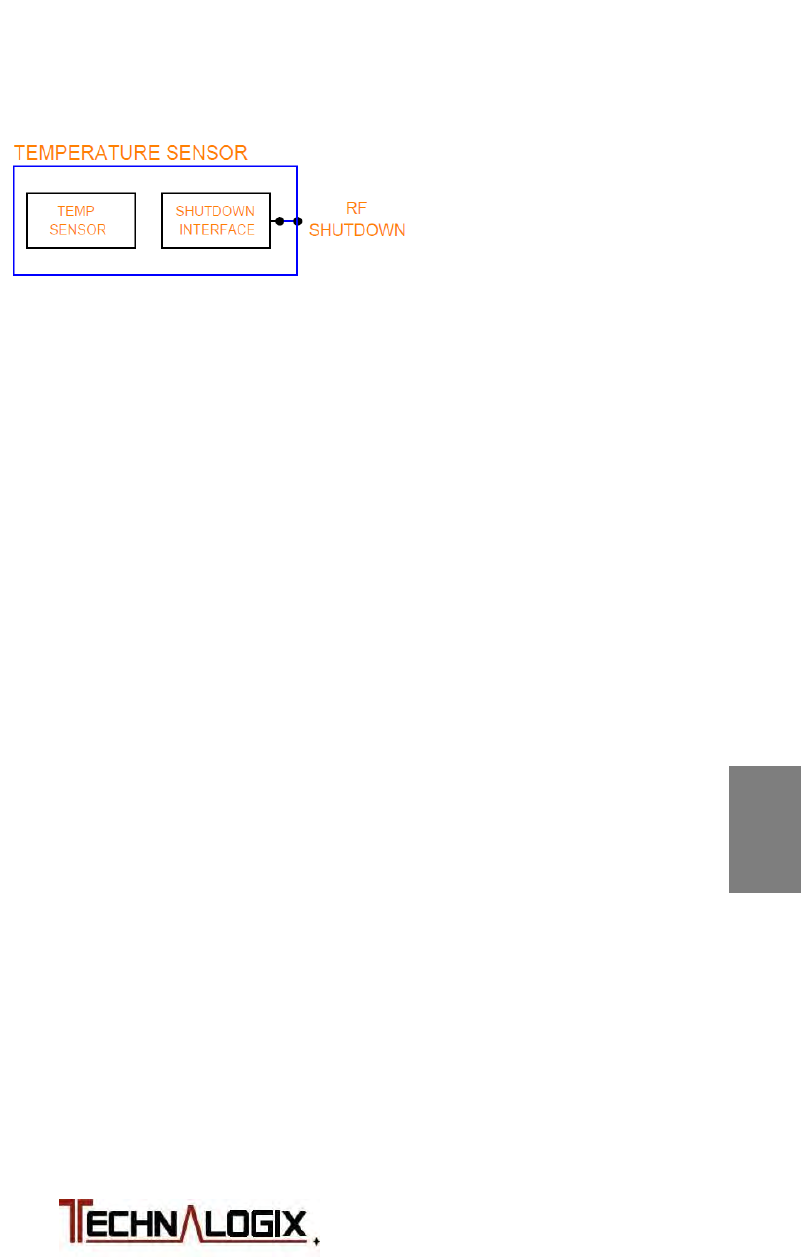
1
Safeguards
2
Terms and
Warranty
3
Principle of
Operation
4
Installation
5
Operation
6
Control System
7
RF Components
8
Power Supply
9
Maintenance
10
Troubleshooting
Temperature Sensor Module
REV 1.13 (ASY 0183)
The Temperature Sensor module is a small board mounted to the main heatsink
of the amplifier/transmitter. The main purpose of the temperature sensor module
is to take temperature readings of the heatsink. The following is a block diagram
of the Temperature Sensor module:
The temperature sensor IC is U701 which, after it has taken a reading, relays the
digital information to the RF PCB module through J700. Also passing through
J700 is a driver disable signal coming from the RF PCB module. The
Temperature Sensor module simply takes this signal and passes it through to a
pad, where a wire connects it to the driver or first gain stage pallet.
In custom applications, there may be multiple temperature sensors installed onto
a heatsink or throughout the system.
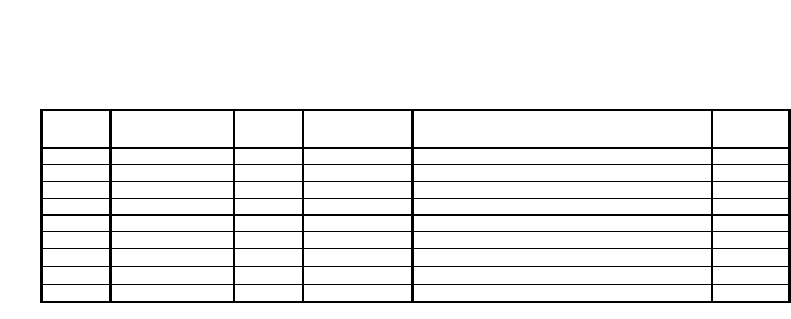
Item Designations Qty Bin # Description Package
1U701 1 ICT 52000 IC, temperture sensor, SPI 8-MSOP
2 C707 1 CAP 08402 CAPACITOR 100pF, 50V, 5% SMD 0805
3C701 1 CAP 11502 CAPACITOR, 1000pF, 50V SMD 0805
4C702, C703 2 CAP 14902 CAPACITOR, 0.01uF, 50V SMD 0805
5 C700, C706 2 CAP 17202 CAPACITOR 0.1uF, 50V, 10% SMD 0805
6 R701,R702 2 RES 3212 RESISTOR, 100 ohm, 1% SMD 0805
7 L700 1 IND 3176 INDUCTOR, 22 uH 5% 150MA 1210 SMD 1210
8 J700 1 CON 45021 CONNECTOR, modular, jack, 8-8 R/A, shielded
91
PCB 0183 PRINTED CIRCUIT BOARD, FR4, 0.062"
Modified: 21-Jan-2014
Revision: 1.13
Bill of Materials - ASY 0183
Circuit: Temperature Sensor
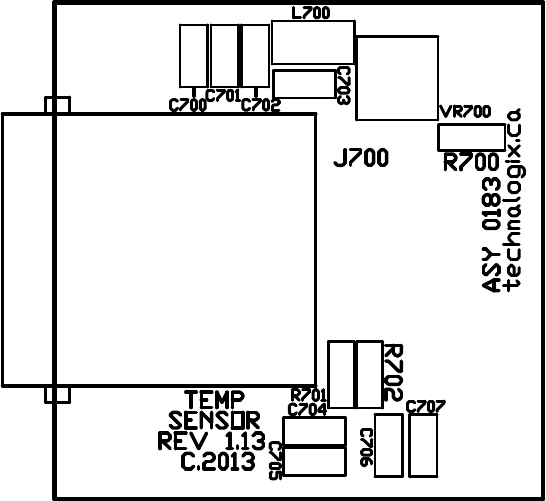
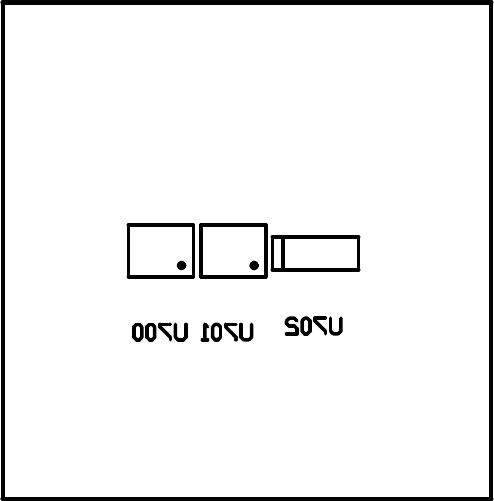
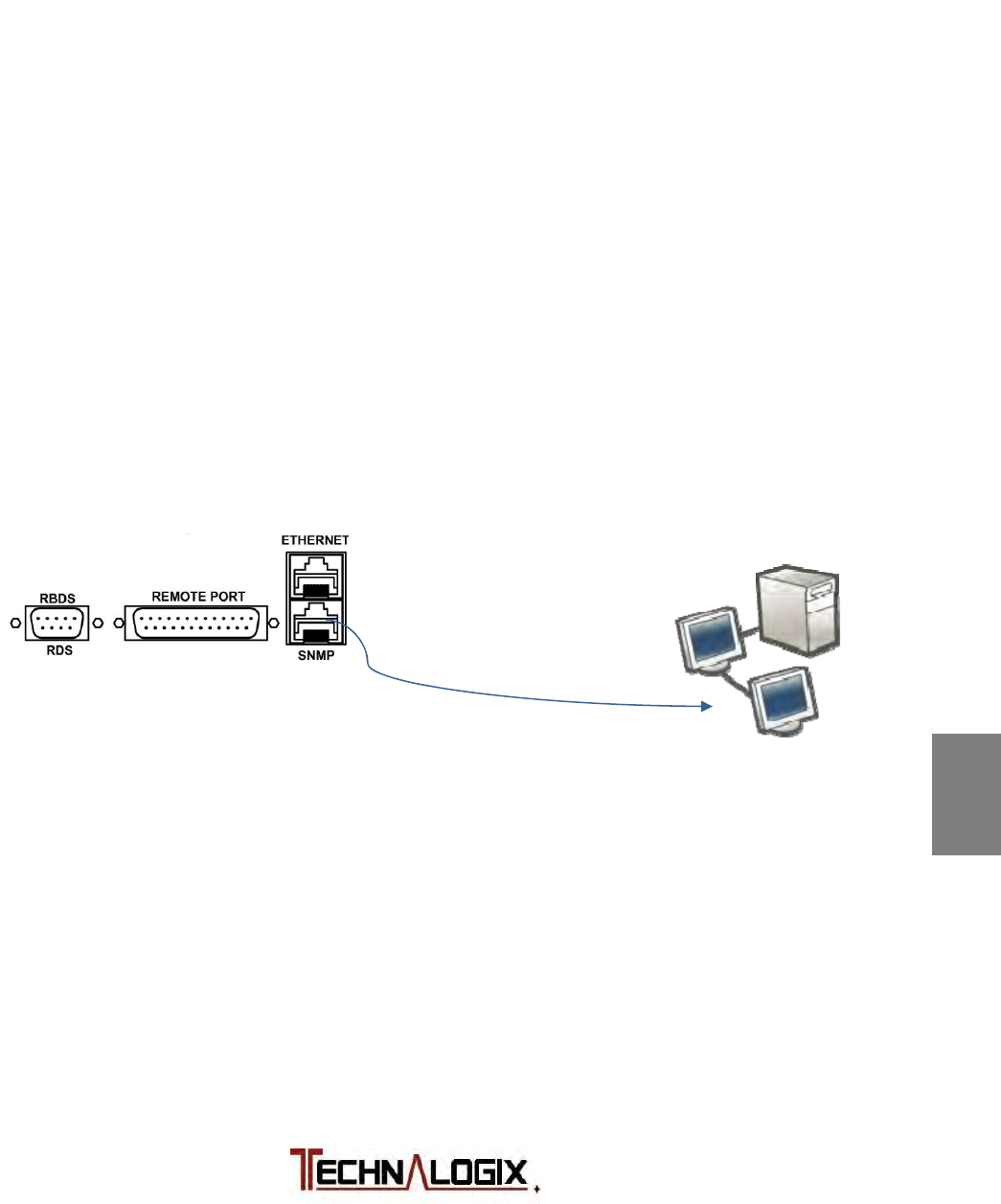
1
Safeguards
2
Terms and
Warranty
3
Principle of
Operation
4
Installation
5
Operation
6
Control System
7
RF Components
8
Power Supply
9
Maintenance
10
Troubleshooting
Web Interface
To access the Technalogix Adrenaline Web Interface, a series of four simple
steps are required:
1. Connect power amplifier/transmitter to your network/PC
2. Open web browser for monitor and control
3. Optimize user parameters
The following pages will describe each step in detail. Descriptions specific to the
user’s computer, router, or network setup are limited due to the differences in the
multitude of networking equipment.
1. Connect Power Amplifier/Transmitter to your Network/PC
Connect an Ethernet cable from the RJ45 port (labelled ETH / SNMP – use
bottom connector) on the back panel of the power amplifier or transmitter to
your network’s Ethernet connection. Most new computers can do this with a
standard Ethernet cable but older network cards may require a crossover
Ethernet cable.
If preferred in place of the touch screen, a computer can be plugged directly
into the Ethernet port on the power amplifier/transmitter to directly access the
on-board web interface.
Turn on the power amplifier or transmitter to establish communication
between the power amplifier and the network.
The Adrenaline control system in the power amplifier or transmitter will source
an internal IP from your router or you can set this manually (see Optimize
User Parameter section).
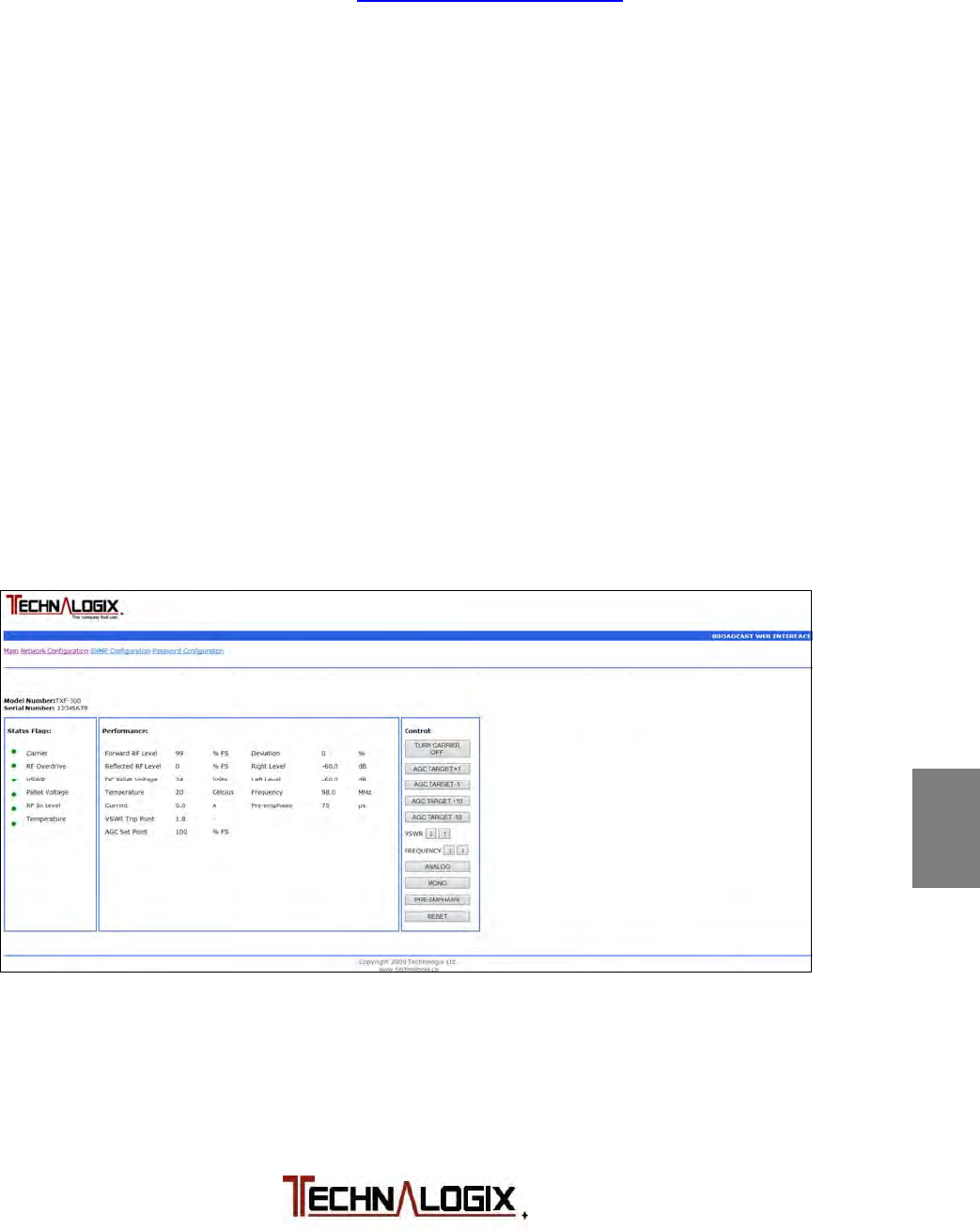
1
Safeguards
2
Terms and
Warranty
3
Principle of
Operation
4
Installation
5
Operation
6
Control System
7
RF Components
8
Power Supply
9
Maintenance
10
Troubleshooting
2. Open web browser for monitor and control
The default internal address is http://adrenaline/index.htm. Type this default
internal address into the URL address bar of your favorite web browser. The
web pages cannot be accessed until you have established basic
communication with the power amplifier or transmitter (turned on).
2.1 Web Page Password Protection
After entering the above internal address into a web browser, you will be
asked for a password. Initially, please use the following:
username: admin
password: admin
The password can later be changed (see Optimize User Parameter section).
2.2 Main Page Description
After entering the login information, the main page is then shown on the
browser, as illustrated below for either single amplifier systems or multiple
amplifier systems that are combined:

1
Safeguards
2
Terms and
Warranty
3
Principle of
Operation
4
Installation
5
Operation
6
Control System
7
RF Components
8
Power Supply
9
Maintenance
10
Troubleshooting
The model number and serial number of the unit are displayed in the top left
of the browser screen.
The Status Flags section provides the user with feedback from the system.
Specifically, there are status flags for:
RF Carrier is on or off
Forward RF in Overdrive (>110% Full Scale (FS) )
High VSWR
Pallet Voltage Supply Good
RF In Level Good
High Temperature
The Performance section provides the user with specific parameters and
measurements in the system. Measurements that can be viewed from the
Performance box are:
Forward RF Levels as a % of Full Scale (FS)
Reflected RF Levels as a % of FS
DC Supply Voltage in volts
Temperature in °C
Current of pallet(s) in Adc
VSWR Trip Point Limit
AGC measured against 100% FS
Deviation
Right Level/Left Level input attenuation
Frequency in MHz
Pre-Emphasis, selectable between 0, 25, 50, or 75 us

1
Safeguards
2
Terms and
Warranty
3
Principle of
Operation
4
Installation
5
Operation
6
Control System
7
RF Components
8
Power Supply
9
Maintenance
10
Troubleshooting
The Control section of the web interface screen allows the user to control
functions inside the equipment, including:
Turn Carrier On/Off - Turn the Carrier on/off
AGC - Increase the Carrier by removing attenuation (steps of 1
or 10 dB)
VSWR ↑↓ - Increase or Decrease the VSWR Trip point by 0.1
between 1.1:1 and factory determined limit.
Frequency ↑↓ - Increase or Decrease the FM carrier frequency
(MHz)
Analog/Digital – Toggle between analog or digital audio inputs
Mono/Stereo – Toggle between mono or stereo
Pre-Emphasis – Toggle between no added emphasis, or 25, 50,
or 75 us emphasis
Reset - Forces the system to reboot
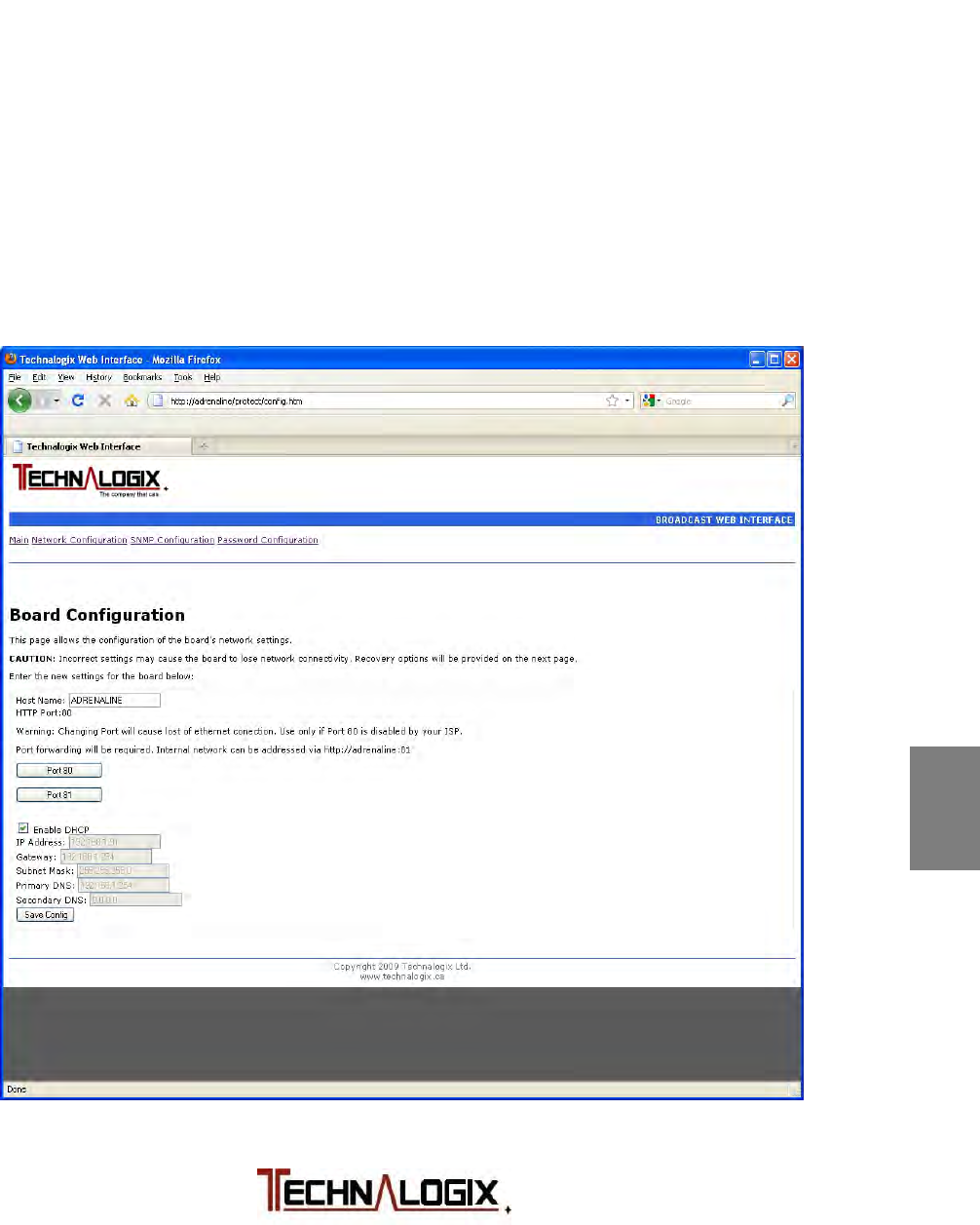
1
Safeguards
2
Terms and
Warranty
3
Principle of
Operation
4
Installation
5
Operation
6
Control System
7
RF Components
8
Power Supply
9
Maintenance
10
Troubleshooting
3. Optimize user parameters
Also on the main web Ethernet page, along the top, are links to the other user
parameter pages:
Main – Returns to Main Index page
Network Configuration
SNMP Configuration
Password Configuration
The following sections describe the user parameter pages in detail.
3.1 Network Configuration
The Network Configuration page allows the administrator to optimize the
network settings to best suit their application.
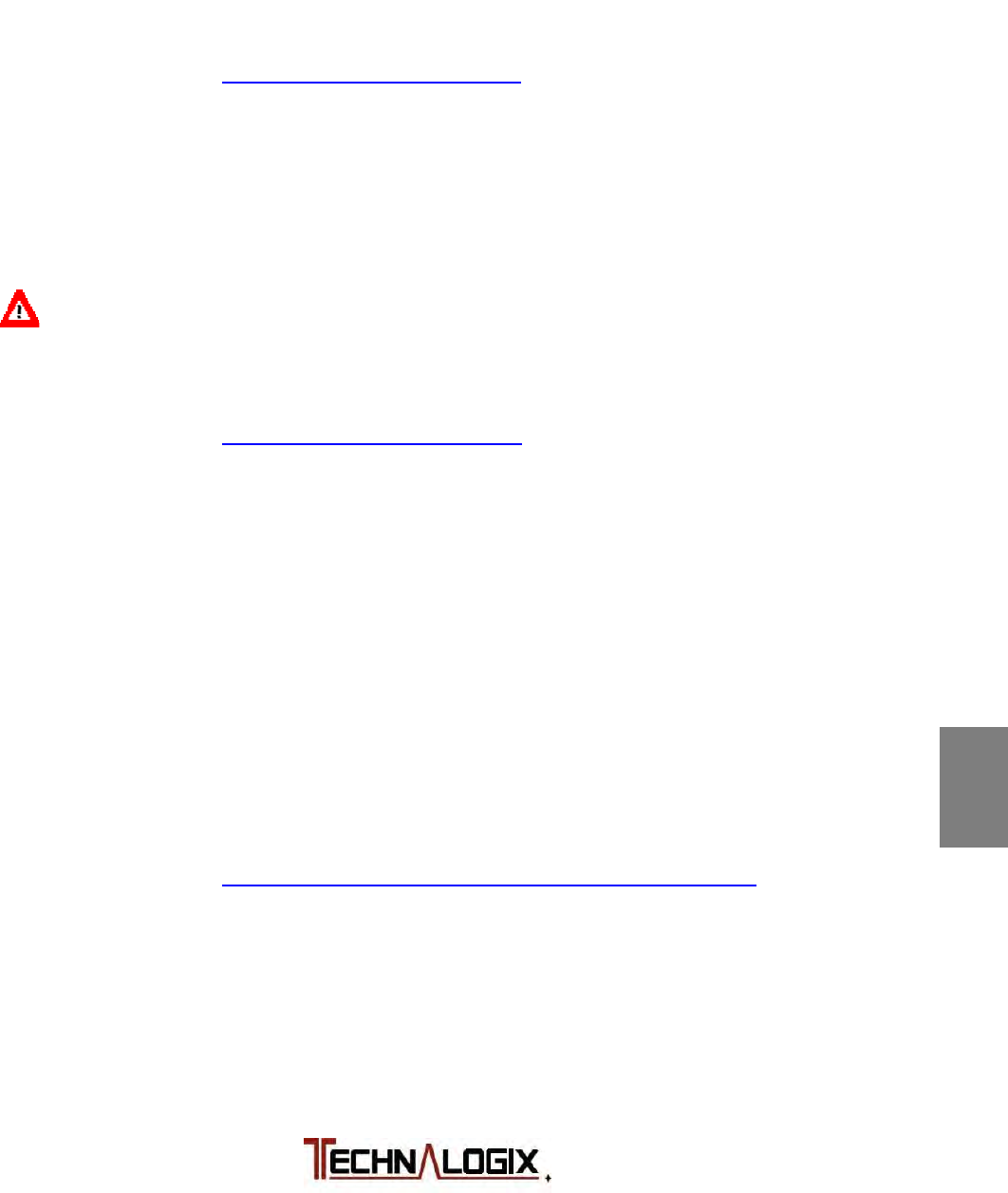
1
Safeguards
2
Terms and
Warranty
3
Principle of
Operation
4
Installation
5
Operation
6
Control System
7
RF Components
8
Power Supply
9
Maintenance
10
Troubleshooting
3.1.1 Host Name
The Host Name shows the current webpage name (default is ADRENALINE).
Enter a new name here if you wish to change this.
For example entering YourCompany will make the web address:
http://yourcompany/index.htm
3.1.2 HTTP Port
The HTTP Port shows the current port used for internet access, 80 or 81. Port
80 is the default and is the accepted standard. Port 81 is available because
some internet providers block access to port 80 unless you pay more.
Be very careful changing HTTP ports as it can be difficult to go back to an
original port.
You can force a web browser to use port 81 by address to:
http://adrenaline:81/index.htm
To use this with an internet address will require port forwarding. Consult your
routers manual to set this up.
3.1.3 IP Addressing
With DHCP enabled the system will automatically try to find a router and
acquire an IP address. If you want to set this manually, uncheck the Enable
DHCP box and enter it below then click Save Config.
To view the webpage from the internet rather than an internal network you
need an external IP address, generally provided by your internet provider.
Note that you can only have one web server using the same port. With this,
anyone can access the system over the internet with something like:
http://www.yourcompanywebaddress.com/adrenaline
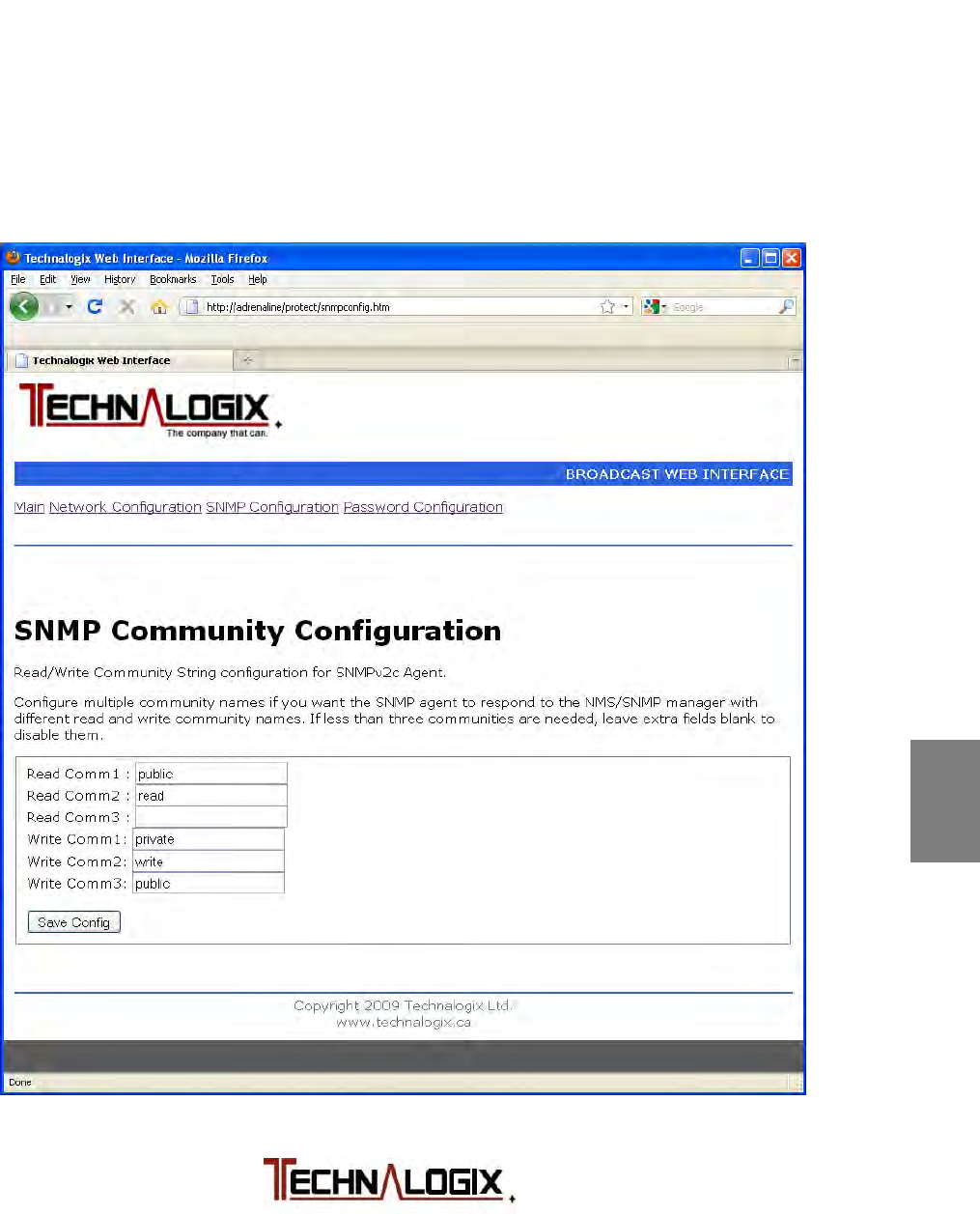
1
Safeguards
2
Terms and
Warranty
3
Principle of
Operation
4
Installation
5
Operation
6
Control System
7
RF Components
8
Power Supply
9
Maintenance
10
Troubleshooting
3.2 SNMP Configuration
3.2.1 SNMP Communities
The SNMP Configuration page allows you to set the SNMP communities. Set
these to limit access to the system via SNMP.
Default communities are READ: public
read
WRITE: private
write
public

1
Safeguards
2
Terms and
Warranty
3
Principle of
Operation
4
Installation
5
Operation
6
Control System
7
RF Components
8
Power Supply
9
Maintenance
10
Troubleshooting
3.2.2 SNMP Management Information Base (MIB)
The Technalogix.mib file allows access to the following data via the SNMP
protocol:
Read Only
Pallet Supply Voltage - voltage level (Vdc)
Temperature - temperature in (°C)
48V Current - current on high voltage bus (Adc)
Attenuation - attenuation level
Reflected Level - reflected level as % rated full scale
Forward Level - forward level as % rated full scale
RF Input Level - input level as % rated full scale
Deviation - modulation level as %
Left Level - left audio input level shown as dB
Right Level - right audio input level shown as dB
Serial Number
Model Number
SNMP Error Flag - error flag, also for trap (see below)
VSWR Flag - error flag for high VSWR
Overdrive - error flag for overdrive
Temperature Flag - error flag for high temperature
Preemphasis - 0,25,50 or 75 us
Read/Write
Reset - 1 Reset System, 0 Normal
Carrier On - 1 Carrier On, 0 Carrier Off
Carrier Up - 1 Increase Carrier Level for AGC target 1%
Carrier Down - 1 Decrease Carrier Level for AGC target 1%
VSWR Trip point - 1-8 for 1.1:1 – 1.8:1
Frequency - 880 – 1080 for 88.0 to 108.0 MHz
Change Preemphasis - rotate through 0,25,50, and 75
AGC Setpoint - set target output power 0-100% rated power
Analog/Digital - 1 Analog audio input, 2 Digital audio input
Digital Input - 1 AES 2 SPDIF 3 TOSLINK
Analog Input - 1 Mono 2 Stereo 3 MPX
Left Attenuation - 0 – 79 dB Attenuation (shows 100dB when
channel disabled)
Right Attenuation - 0 – 79 dB Attenuation (shows 100dB when
channel disabled)
MPX Attenuation - 0 – 79 dB Attenuation (shows 100dB when
channel disabled)
SCA1 Attenuation - 0 – 79 dB Attenuation
SCA2 Attenuation - 0 – 79 dB Attenuation
Read and Write communities can be set from the web interface, as described
earlier in this section.
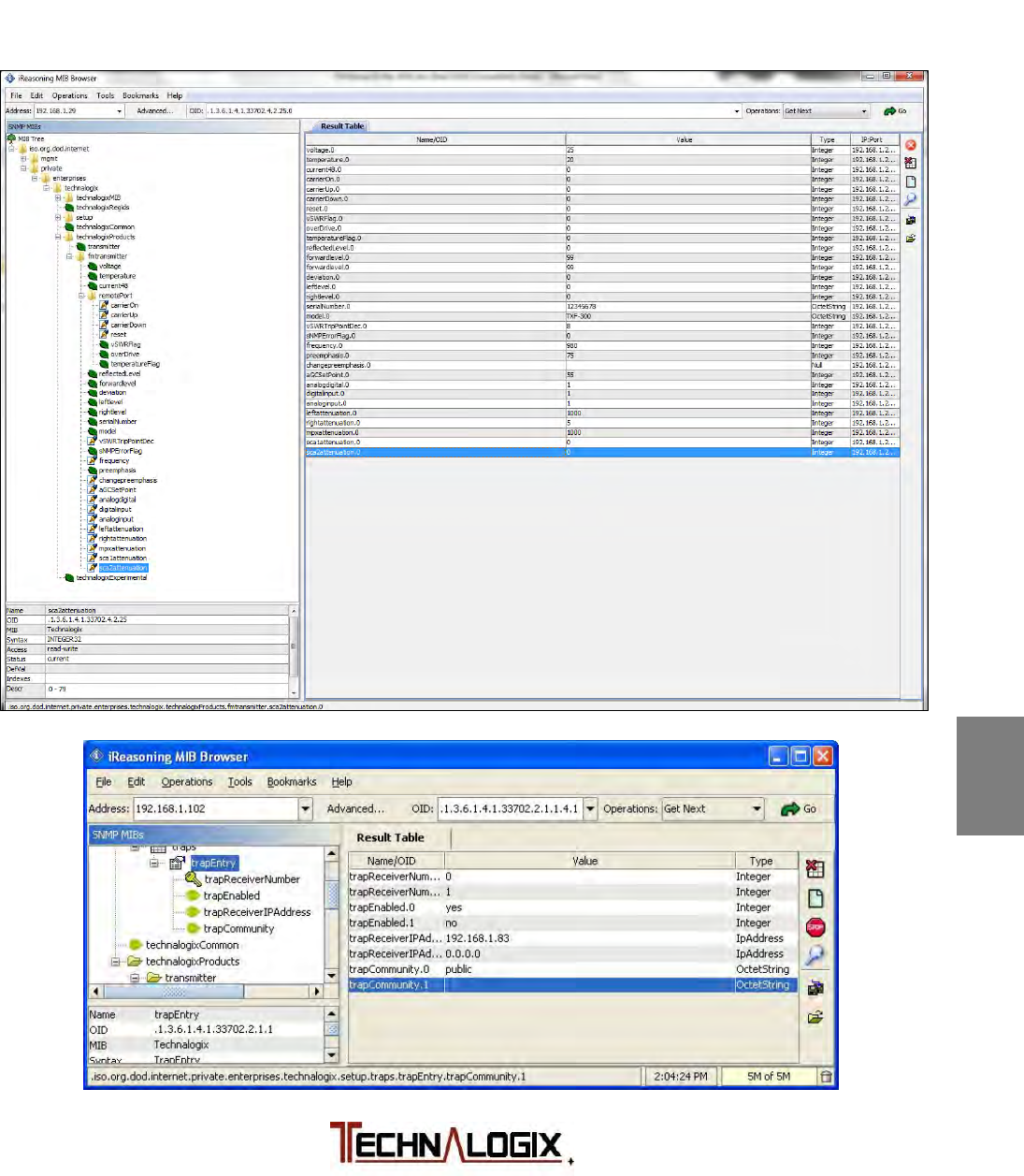
1
Safeguards
2
Terms and
Warranty
3
Principle of
Operation
4
Installation
5
Operation
6
Control System
7
RF Components
8
Power Supply
9
Maintenance
10
Troubleshooting
3.2.3 SNMP Traps
To enable the SNMP traps, within the MIB browser that you choose:
Set enable traps to 1 (or yes, depending on MIB browser).
Set the IP address to that of the receiving computer.
Set the community to one of the read communities set above.
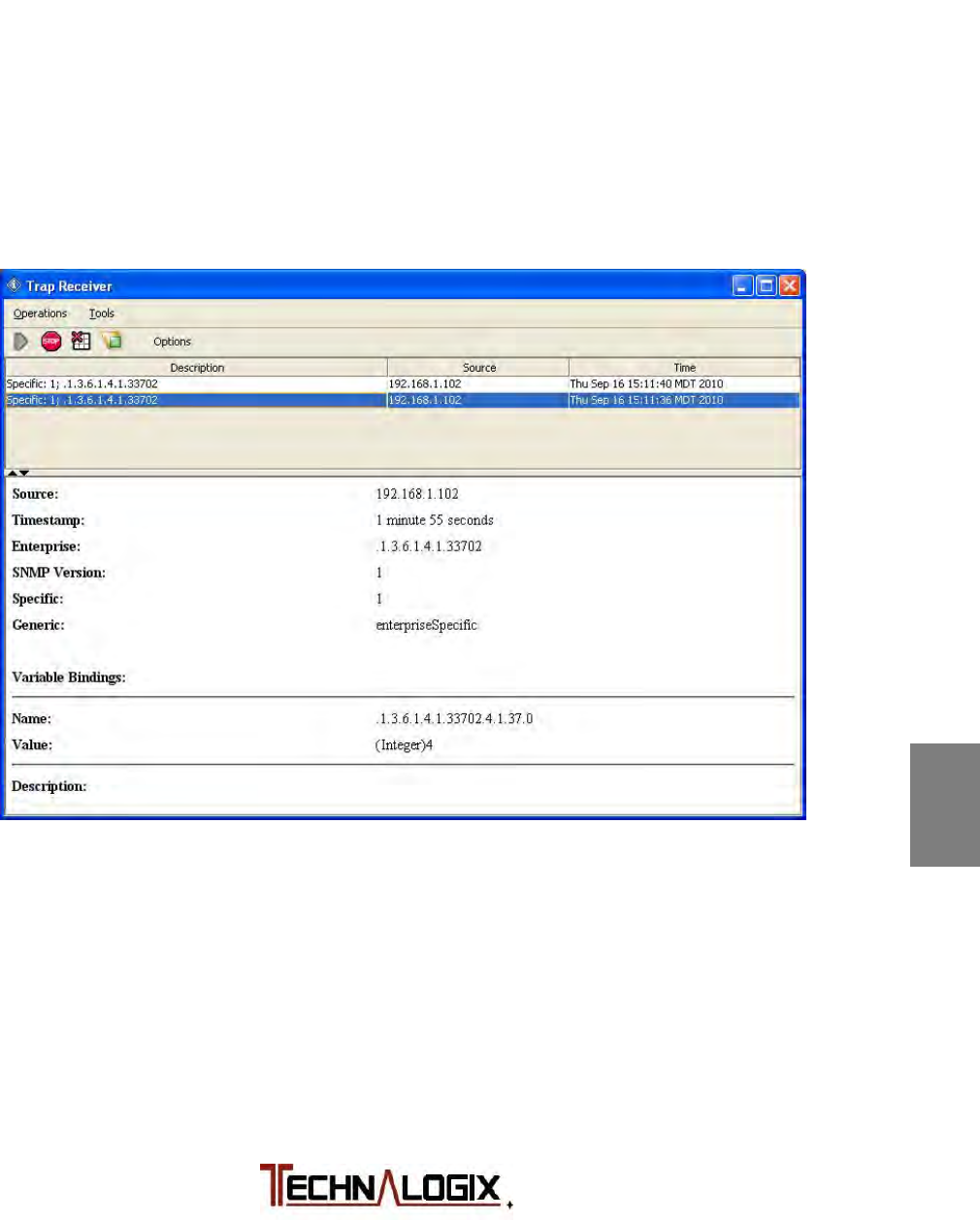
1
Safeguards
2
Terms and
Warranty
3
Principle of
Operation
4
Installation
5
Operation
6
Control System
7
RF Components
8
Power Supply
9
Maintenance
10
Troubleshooting
Ensure that your receiver’s port is set to 162
The system will generate a general trap on any error flag and send an 8-bit
value indicating the type of error, as follows:
Bit 0(LSB) Overdrive
Bit 1 High VSWR
Bit 2 High Temperature
Bit 3 High Speed Hardware Shutdown
Bit 4(MSB) High Input Level
As an example, the following is a screen shot of a high temperature fault
(Value 4).
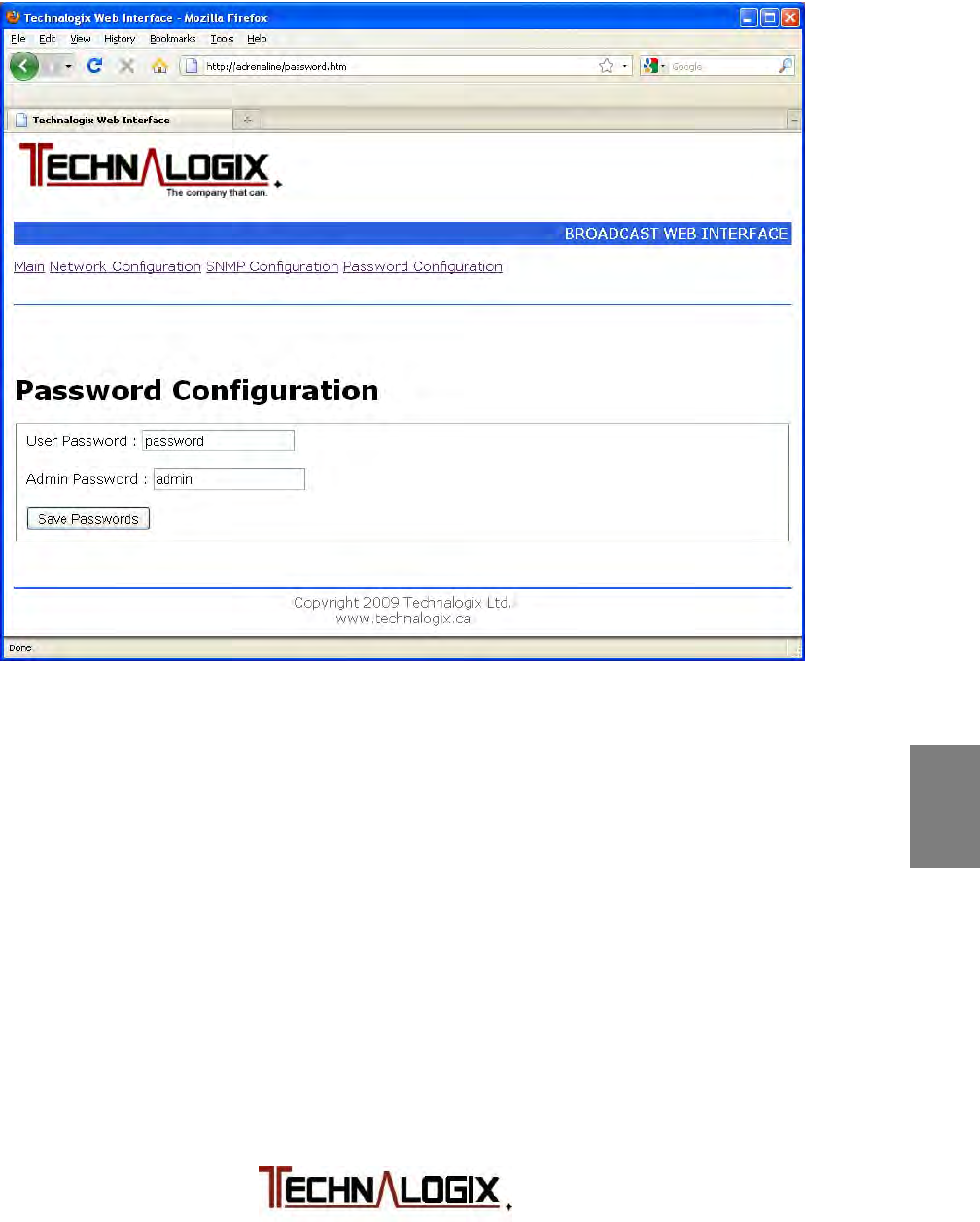
1
Safeguards
2
Terms and
Warranty
3
Principle of
Operation
4
Installation
5
Operation
6
Control System
7
RF Components
8
Power Supply
9
Maintenance
10
Troubleshooting
3.3 Password Configuration
This page allows the setting of the web browser’s User or Admin password,
as illustrated below.
The User account allows access only to the main page. The Admin account
allows access to the main and all the configuration pages.
Passwords are to be a maximum of 7 characters long. Don’t forget your
password. Resetting passwords isn’t as fun as it sounds and may cause loss
of all settings.
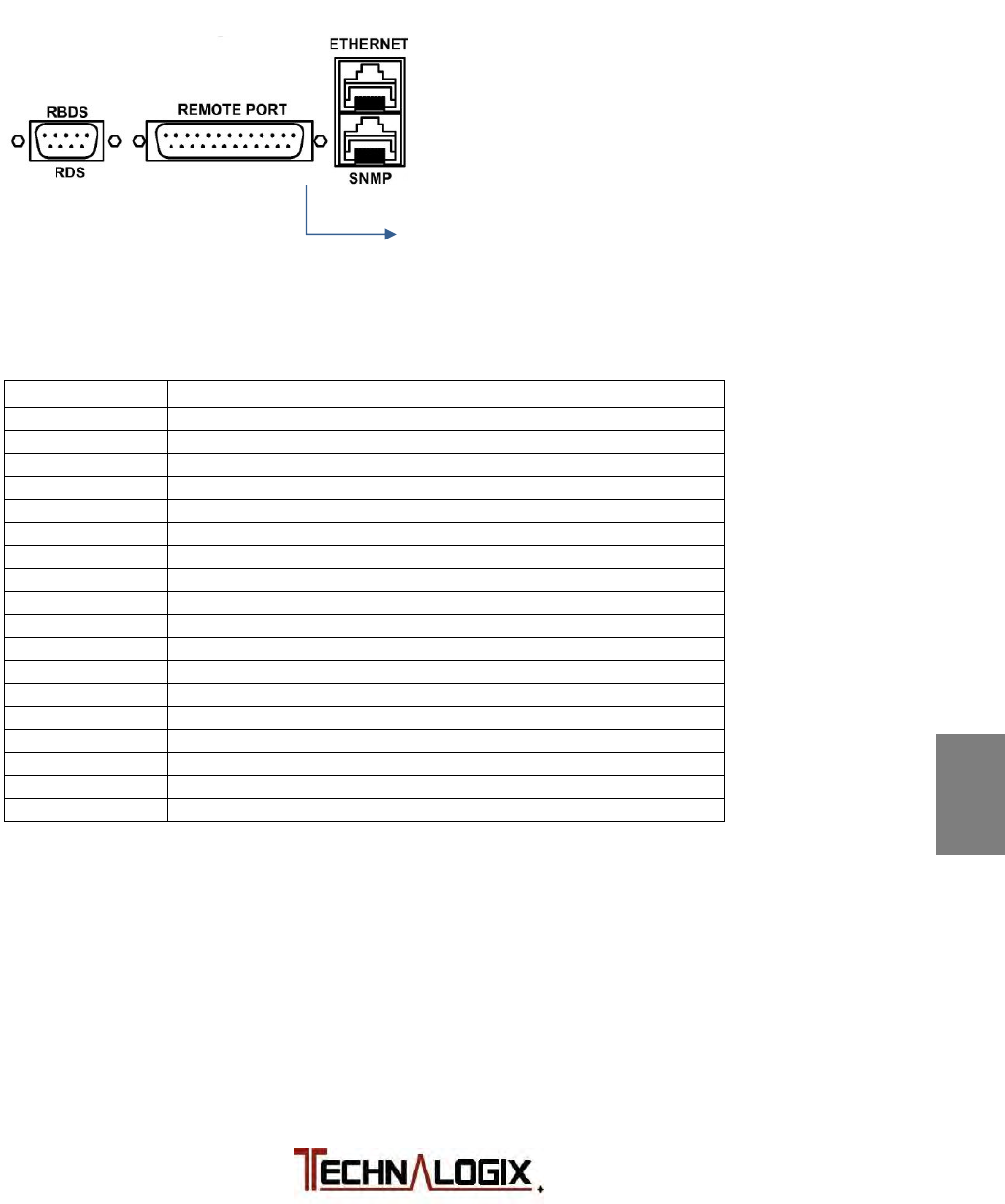
1
Safeguards
2
Terms and
Warranty
3
Principle of
Operation
4
Installation
5
Operation
6
Control System
7
RF Components
8
Power Supply
9
Maintenance
10
Troubleshooting
Remote Control (via DB25)
An additional option for remote control of the power amplifier/transmitter is
through the DB25 connector found on the back panel of the power
amplifier/transmitter, as illustrated below:
The overall functions of each pin on the Remote Port are indicated in the
following DB25 pinout:
Pin Number Description
1 Ground
2 Forward power sample
1
3 Reflected power sample
1
4 Carrier off
2
5 Carrier on
2
6
3
Increase carrier level 1%, if AGC on
2
7
3
Decrease carrier level 1%, if AGC on
2
8 Do not use
9 Reset
2
10 Do not use
11 High temperature flag
2
12 High VSWR flag
2
13 Amplifier overdriven flag
2
14 Do not use
15 +3.3Vdc (for testing only, do not load)
16 Ground
17 Ground
18-25 Do not use
Notes: 1. Analog output with voltage ranging from 0 to 3.3Vdc.
2. Open collector configuration on RF 1.04 and later. On RF 1.04 and
later, ground to activate input control on inputs; ground indicates fault
occurrence on fault outputs. On RF 1.03 and earlier, the inputs are TTL
digital inputs, active on rising edge and the outputs are active high.
3. If AGC off, these pins turn on AGC to the current FWD level, +/- 1%.
In addition to the DB25 parallel data connector, the user may chose to remotely
control the RF amplifier/transmitter via an optional Ethernet web server or
through an optional Simple Network Managed Protocol (SNMP) interface,
described later in this section.
Attach a male DB25 cable
to this female connector

1
Safeguards
2
Terms and
Warranty
3
Principle of
Operation
4
Installation
5
Operation
6
Control System
7
RF Components
8
Power Supply
9
Maintenance
10
Troubleshooting
RBDS and RDS
Radio Broadcast Data System (RBDS) is commonly used for FM broadcast in
North America, while the Radio Data System (RDS) is implemented in Europe. In
1998, the two standards were largely unified. Both systems are implemented as
standard features on Technalogix FM transmitters, including the control,
generator, and interface.
RDS uses a subcarrier to embed the FM signal with information. This can be
used to transmit time, station identification, programming information and more.
To control the RBDS/RDS connect to the DB9 on the back of the unit using a
RS232 connection. A USB-to-RS232 or Ethernet-to-RS232 convertor can be
used instead (not included with transmitter).
To interface with the RBDS/RDS you need to install the Magic RDS software.
Magic RDS software is found at http://www.pira.cz/rds/MagicRDS_Setup.exe.
General operating questions are answered here:
http://www.pira.cz/rds/show.asp?art=magic_rds_how_to.
The RBDS/RDS subcarrier level can be adjusted using R108 on the FM Exciter
1.01 circuit board. It should be set between 1.5 and 10% modulation. It is
recommended to turn to 0% if not RBDS/RDS is not being used to provide the
maximum available modulation for the audio signal.
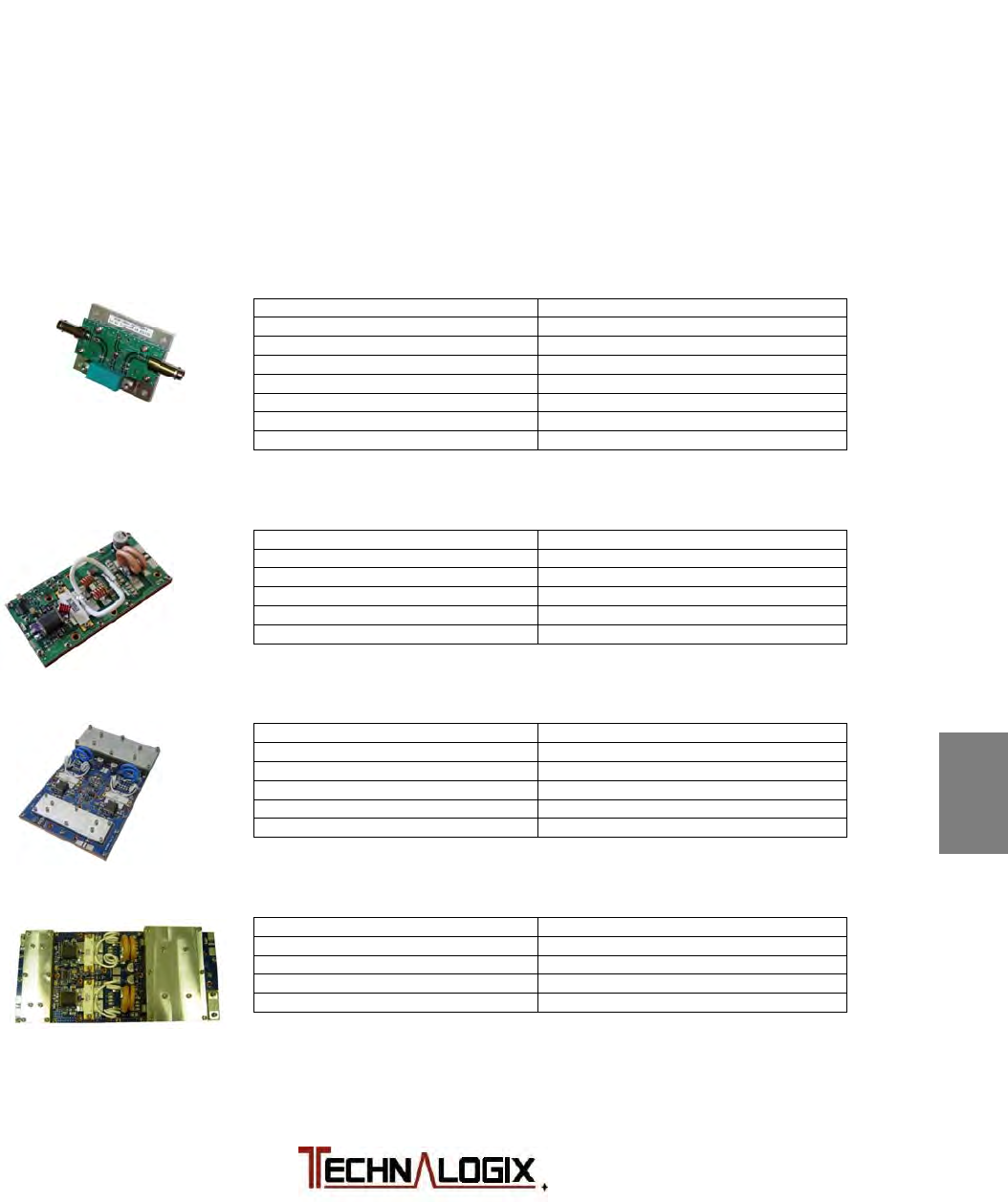
1
Safeguards
2
Terms and
Warranty
3
Principle of
Operation
4
Installation
5
Operation
6
Control System
7
RF Components
8
Power Supply
9
Maintenance
10
Troubleshooting
RF Components
FM Amplifier Pallets
The following is a summary of the typical FM amplifier pallets used in
Technalogix power amplifiers and transmitters out of the many pallets that have
been designed for production or custom applications. The exact bias and drain
currents of your system are found in the Final Inspection Report supplied in the
Quickstart package. Output power levels are absolute maximum levels.
Technalogix operates the pallets at reduced levels to improve performance and
increase reliability.
PB1A-50-1000-1042H
Typical gain 21.5 dB
Pout max (NTSC) 1 W peak sync
Pout max (8VSB) 0.4 W rms
Pout max (DVB-T) 0.25 W
Pin max 15 dBm
Frequency 50 – 1000 MHz
ID max 0.47 Adc
VD 24 Vdc
PB1000F-88-108-188XR
Typical gain 25 dB
Pout max (FM) 1050 W peak saturated at 50V
Pout max (DVB-T) 400 W
Frequency 87.5 – 108.1 MHz
ID max 28 Adc
VD 48 Vdc
PB1200F-86-110-574-25
Typical gain 25 dB
Pout max (FM) 1050 W peak saturated at 50V
Pout max (DVB-T) 400 W
Frequency 87.5 – 108.1 MHz
ID max 28 Adc
VD 48 Vdc
PB1200F-86-110-574-49
Minimum 25 dB
Pout max (FM) 1200 W peak saturated at 50V
Frequency 87.5 – 108.1 MHz
ID max 32-36 Adc
VD 32-50 Vdc
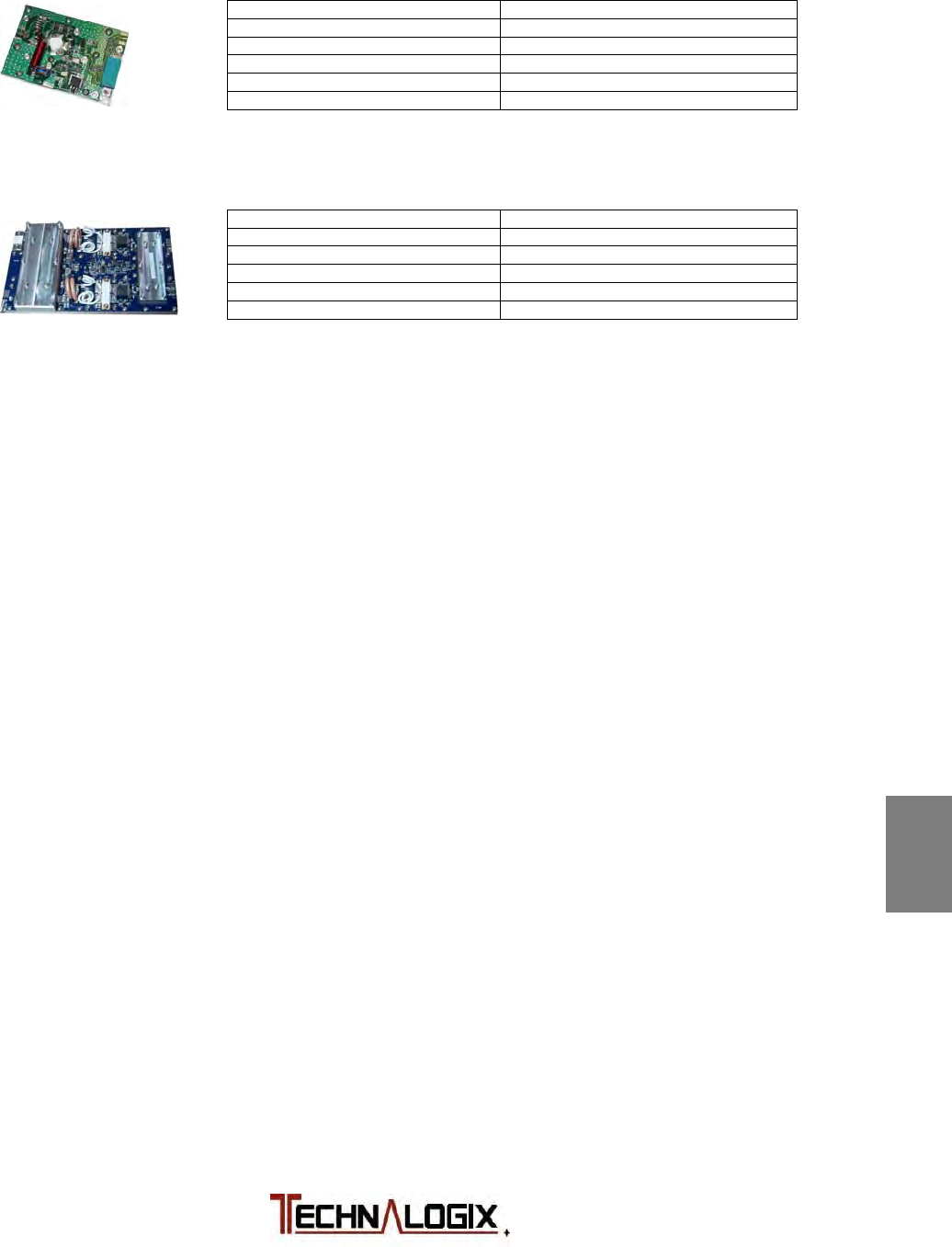
1
Safeguards
2
Terms and
Warranty
3
Principle of
Operation
4
Installation
5
Operation
6
Control System
7
RF Components
8
Power Supply
9
Maintenance
10
Troubleshooting
PB25C-86-110-xxx Typical gain 40 dB
Pout max (8VSB) 25 W rms
Frequency 88 – 108 MHz
Pin max 10 dBm
ID max 1.6 Adc
VD 28 Vdc
PB1200C-86-110-574 Typical gain 25 dB
Pout min (FM) 1125 W (w/ 3.5 W input)
Frequency 86 – 110 MHz
Pin max 10 dBm
ID typ 32 - 36 Adc
VD 32 - 50 Vdc
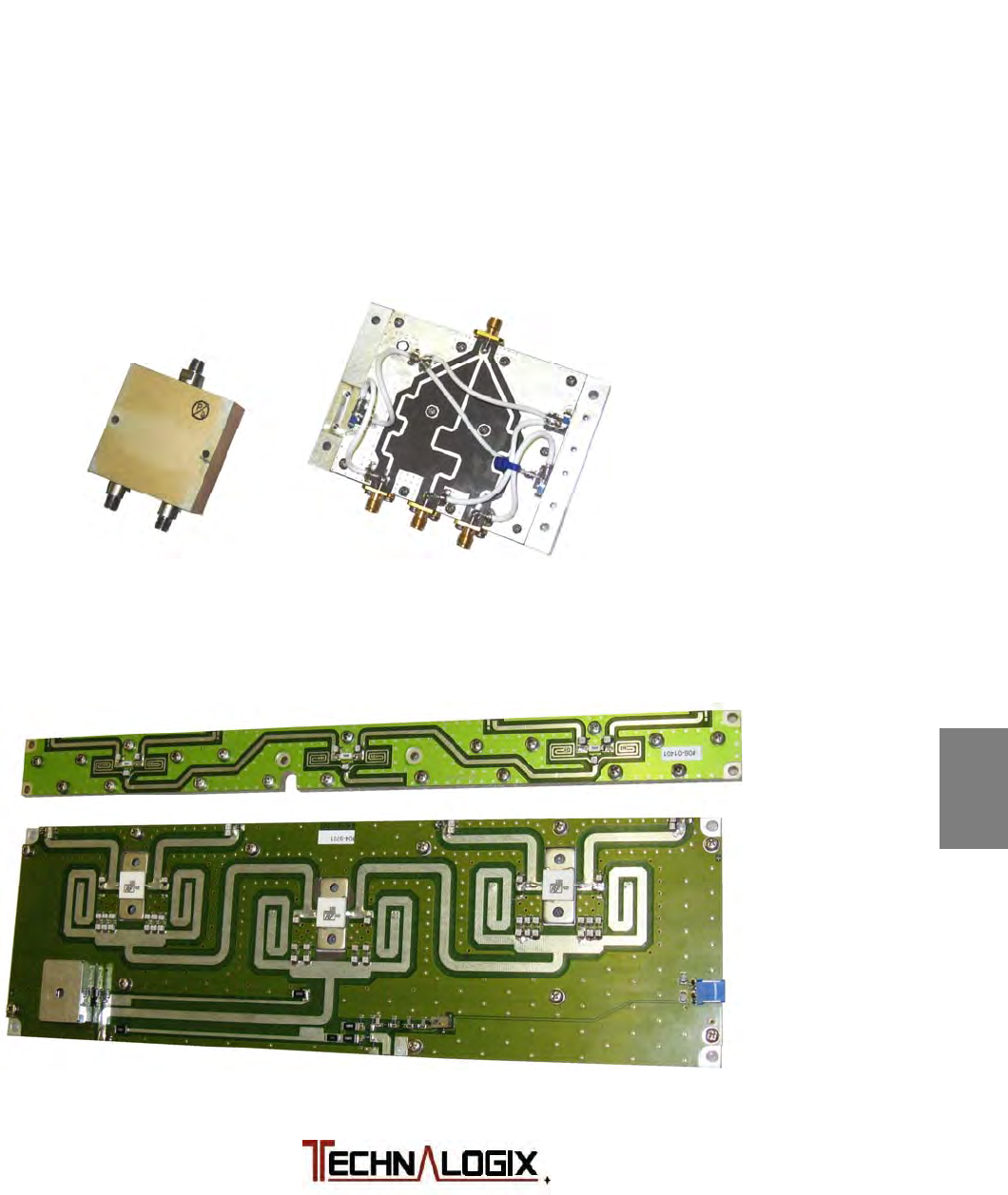
1
Safeguards
2
Terms and
Warranty
3
Principle of
Operation
4
Installation
5
Operation
6
Control System
7
RF Components
8
Power Supply
9
Maintenance
10
Troubleshooting
Splitter/Combiner
If used, the splitter and combiner are used to split the RF signal into, and
combine the amplified RF signal out of the final amplifier pallets, within an
amplifier/transmitter enclosure. The splitter and combiner can be 2-, 3-, or 4-way
depending on how many finals pallets are used. Most designs are based on the
simple isolated Wilkinson combiner design. Due to its electrical and mechanical
symmetry, the Wilkinson design’s performance over moderate bandwidths is
superior to other types.
2-, 3-Way:
4-Way:
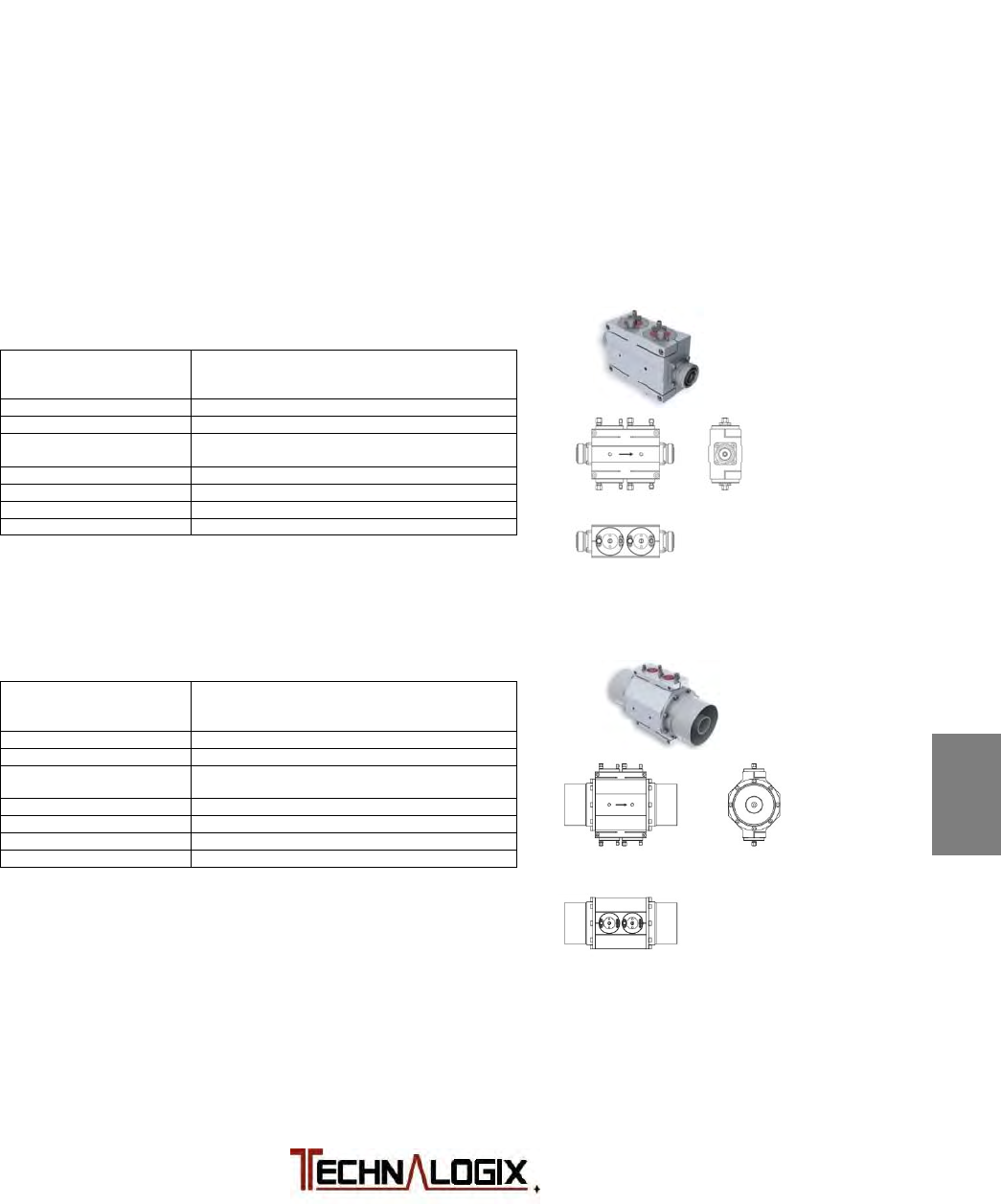
1
Safeguards
2
Terms and
Warranty
3
Principle of
Operation
4
Installation
5
Operation
6
Control System
7
RF Components
8
Power Supply
9
Maintenance
10
Troubleshooting
Directional Coupler
The dual directional coupler provides RF samples proportional to forward and
reflected RF power to be converted to DC voltages for monitoring. These analog
voltages are converted for processing using analog-to-digital converters and
provide the control system with valuable data for monitoring purposes. Output
power should be set following the operating procedure found elsewhere in this
manual. The directional coupler uses Type N connectors on lower power systems
and 7-16 DIN connectors are used for increased power handling capability. Other
connectors are available upon request – this connector is typically the RF output
connector on the back panel of the enclosure. On higher power systems, high
power handling connectors are used, especially in the overall output combiner.
On lower power systems, the coupler is typically based on microstrip architecture
on the exciter circuit board.
Frequency Ran
g
e 41
–
100 MHz (option A)
162 – 254 MHz (option B)
470 – 862 MHz (option C)
Max Output Powe
r
2 kW DTV (3 kW ATV)
Couplin
g
-36 to -60 dB (on any channel)
Couplin
g
variation < ±0.15 dB 162
–
254 MHz
< ±0.15 dB 470 – 862 MHz
Return Loss > 30 dB (VSWR < 1.07)
Directivity > 30 dB
Environmental Conditions -5 to +55 °C (+23 to +131 °F)
Connectors N, 7-16DIN, EIA 7/8” (dependent on power level)
Frequency Ran
g
e 41
–
100 MHz (option A)
162 – 254 MHz (option B)
470 – 862 MHz (option C)
Max Output Powe
r
20 kW DTV (30 kW ATV)
Couplin
g
-48 to -72 dB (on any channel)
Couplin
g
variation < ±0.15 dB 162
–
254 MHz
< ±0.15 dB 470 – 862 MHz
Return Loss > 30 dB (VSWR < 1.07)
Directivity > 30 dB
Environmental Conditions -5 to +55 °C (+23 to +131 °F)
Connectors EIA 1-5/8” or 3-1/8”(dependent on power level)
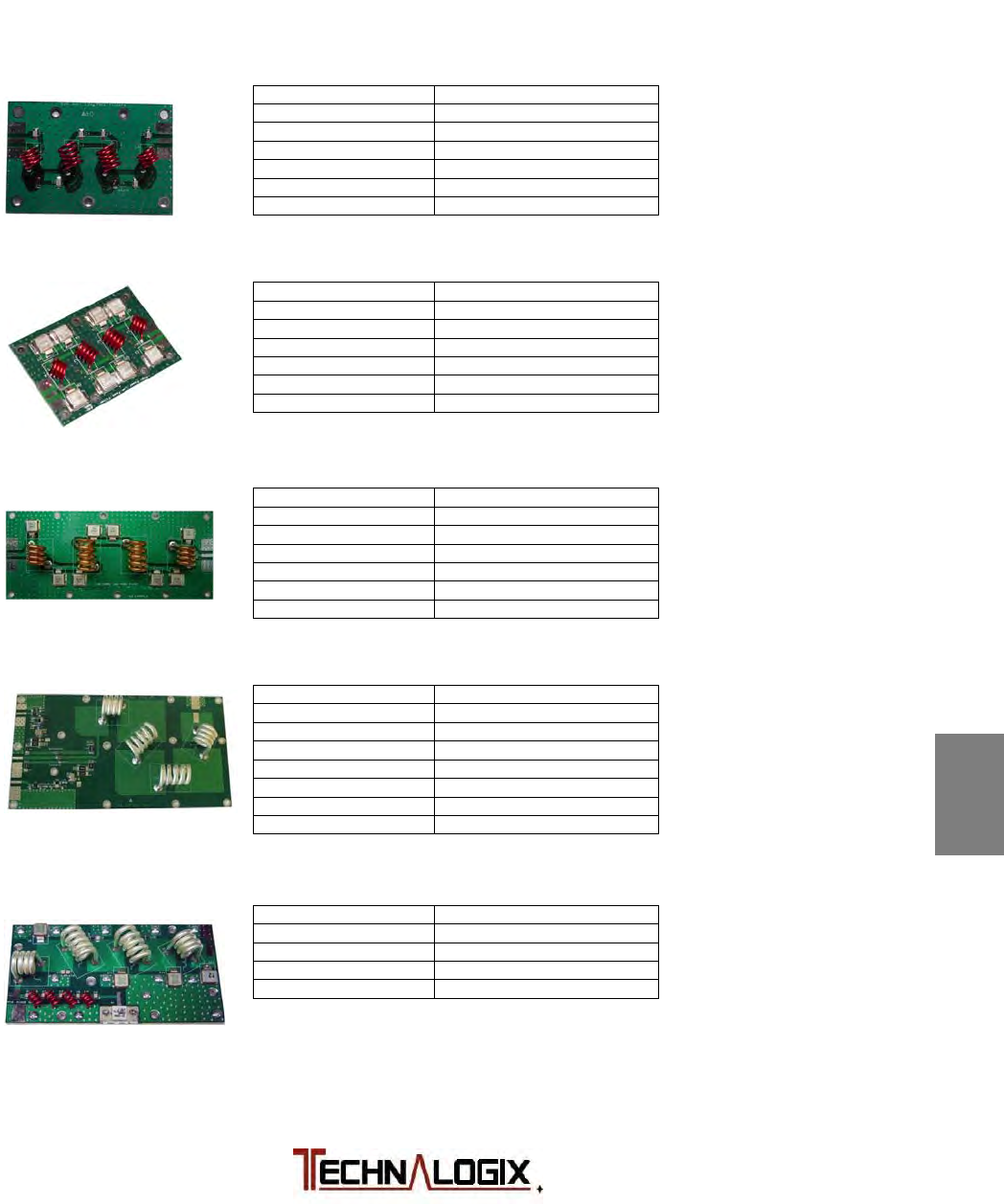
1
Safeguards
2
Terms and
Warranty
3
Principle of
Operation
4
Installation
5
Operation
6
Control System
7
RF Components
8
Power Supply
9
Maintenance
10
Troubleshooting
Filter
Our passive 50 ohm lowpass FM filters reject (and in some cases, absorb)
spurious and harmonic output products and passes the modulated FM output
carrier to the antenna or load.
150W LPF, no coupler Frequency Range 86 – 110 MHz
Input Power (max) 150 W continuous
Insertion Loss (max) < 0.3 dB
Insertion Loss (typ) < 0.25 dB
Return Loss (max) > 25 dB
Return Loss (typ) > 28 dB
Rejection at 176 MHz > -45 dB
250W LPF, no coupler Frequency Range 86 – 110 MHz
Input Power (max) 250 W continuous
Insertion Loss (max) < 0.3 dB
Insertion Loss (typ) < 0.25 dB
Return Loss (max) > 25 dB
Return Loss (typ) > 28 dB
Rejection at 176 MHz > -45 dB
800W LPF, no coupler Frequency Range 86 – 110 MHz
Input Power (max) 800 W continuous
Insertion Loss (max) < 0.25 dB
Insertion Loss (typ) < 0.2 dB
Return Loss (max) > 25 dB
Return Loss (typ) > 28 dB
Rejection at 176 MHz > -60 dB
1,200W LPF, with coupler Frequency Range 86 – 110 MHz
Input Power (max) 1,200 W continuous
Insertion Loss (max) < 0.2 dB
Insertion Loss (typ) < 0.15 dB
Return Loss (max) > 25 dB
Return Loss (typ) > 30 dB
Rejection at 176 MHz > -47 dB
Directivity (min) 25 dB
1,500W LPF, absorbing, no coupler
Frequency Range 87.5 - 108 MHz
Input Power (max) 1,500 W continuous
Insertion Loss (typ) < 0.1 dB
Return Loss (typ) > 30 dB
Rejection at 176 MHz > 10 dB return loss
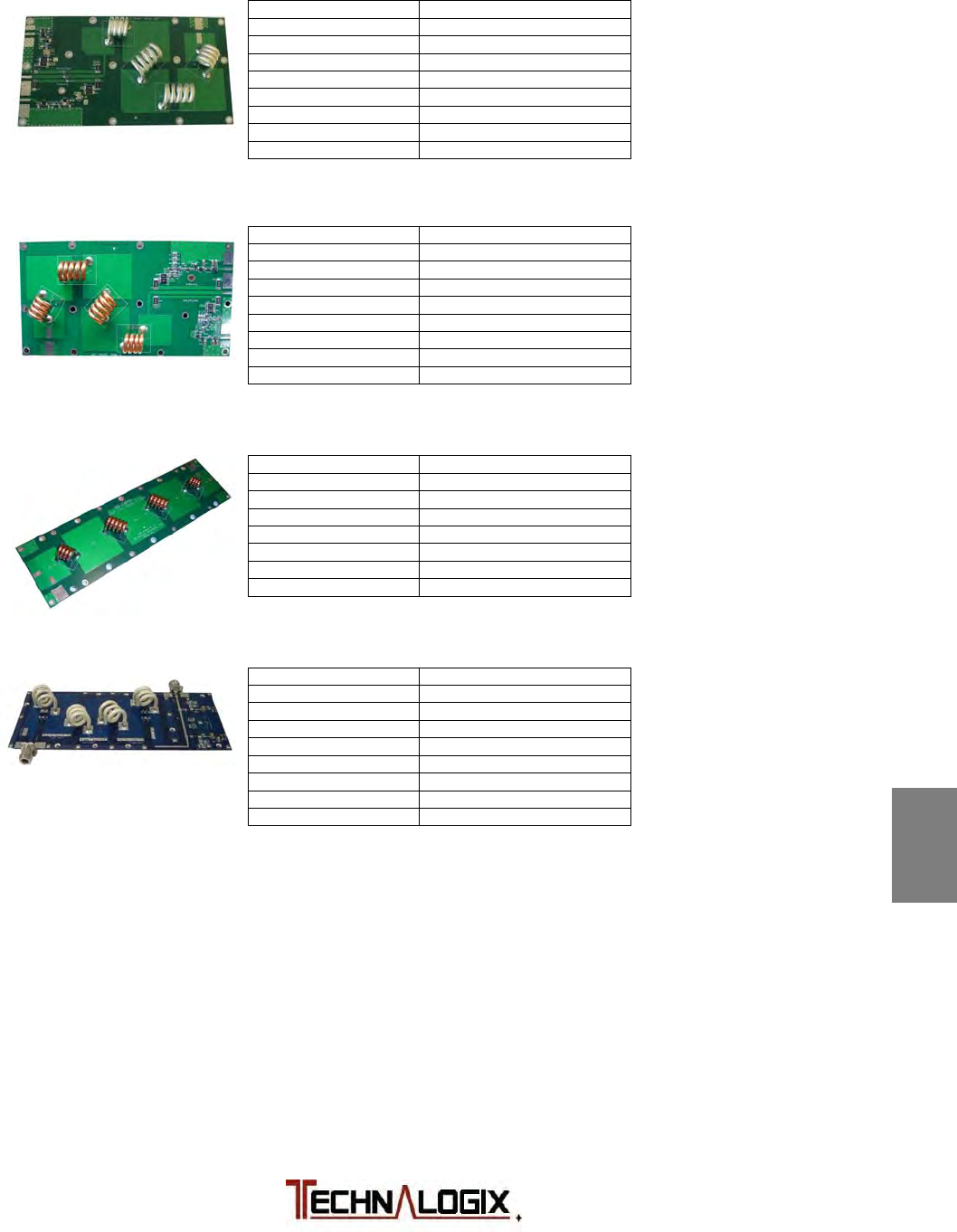
1
Safeguards
2
Terms and
Warranty
3
Principle of
Operation
4
Installation
5
Operation
6
Control System
7
RF Components
8
Power Supply
9
Maintenance
10
Troubleshooting
1,500W LPF, with coupler Frequency Range 86 – 110 MHz
Input Power (max) 1,500 W continuous
Order 9
th
order Chebyshev
Insertion Loss (max) < 0.2 dB
Insertion Loss (typ) < 0.15 dB
Return Loss (max) > 25 dB
Return Loss (typ) > 30 dB
Rejection at 176 MHz > -47 dB
Directivity (min) 20 dB
1,500W LPF, with -50dB coupler
Frequency Range 86 – 110 MHz
Input Power (max) 1,500 W continuous
Order 9
th
order Chebyshev
Insertion Loss (max) < 0.12 dB
Insertion Loss (typ) < 0.1 dB
Return Loss (max) > 28 dB
Return Loss (typ) > 33 dB
Rejection at 176 MHz > -47 dB
Directivity (min) 20 dB
2,000W LPF, no coupler Frequency Range 86 – 110 MHz
Input Power (max) 2,000 W continuous
Order 9
th
order Chebyshev
Insertion Loss (max) < 0.12 dB
Insertion Loss (typ) < 0.1 dB
Return Loss (max) > 23 dB
Return Loss (typ) > 25 dB
Rejection at 176 MHz > -45 dB
3,600W LPF, with coupler Frequency Range MHz
Input Power (max) 3,600 W continuous
Order 9
th
order Chebyshev
Insertion Loss (max) < dB
Insertion Loss (typ) < dB
Return Loss (max) > dB
Return Loss (typ) > dB
Rejection at 176 MHz > dB
Directivity (min) > - dB

1
Safeguards
2
Terms and
Warranty
3
Principle of
Operation
4
Installation
5
Operation
6
Control System
7
RF Components
8
Power Supply
9
Maintenance
10
Troubleshooting
Power Supply Components
Switching AC-DC power supplies are used to power the amplifier pallets, the
control circuits, and all of the fans. The DC system voltage is set at either 24, 30,
or 48Vdc nominally, depending on the system. All fans run off this same DC
supply. The specific DC system voltage is found in the Final Inspection Report,
and the model and number of power supplies, is documented in the Block
Diagram supplied in the Quickstart package.
AC is fed into the power supply enclosure via a filtered AC entry and then
through a circuit breaker/switch. Specific AC current draw is documented in the
Final Inspection Report supplied in the Quickstart package. AC is then converted
to DC using one or more AC-DC switching power supplies.
The following is the switching power supply data sheet(s) used to convert the AC
to DC for the internal amplifier or transmitter components.
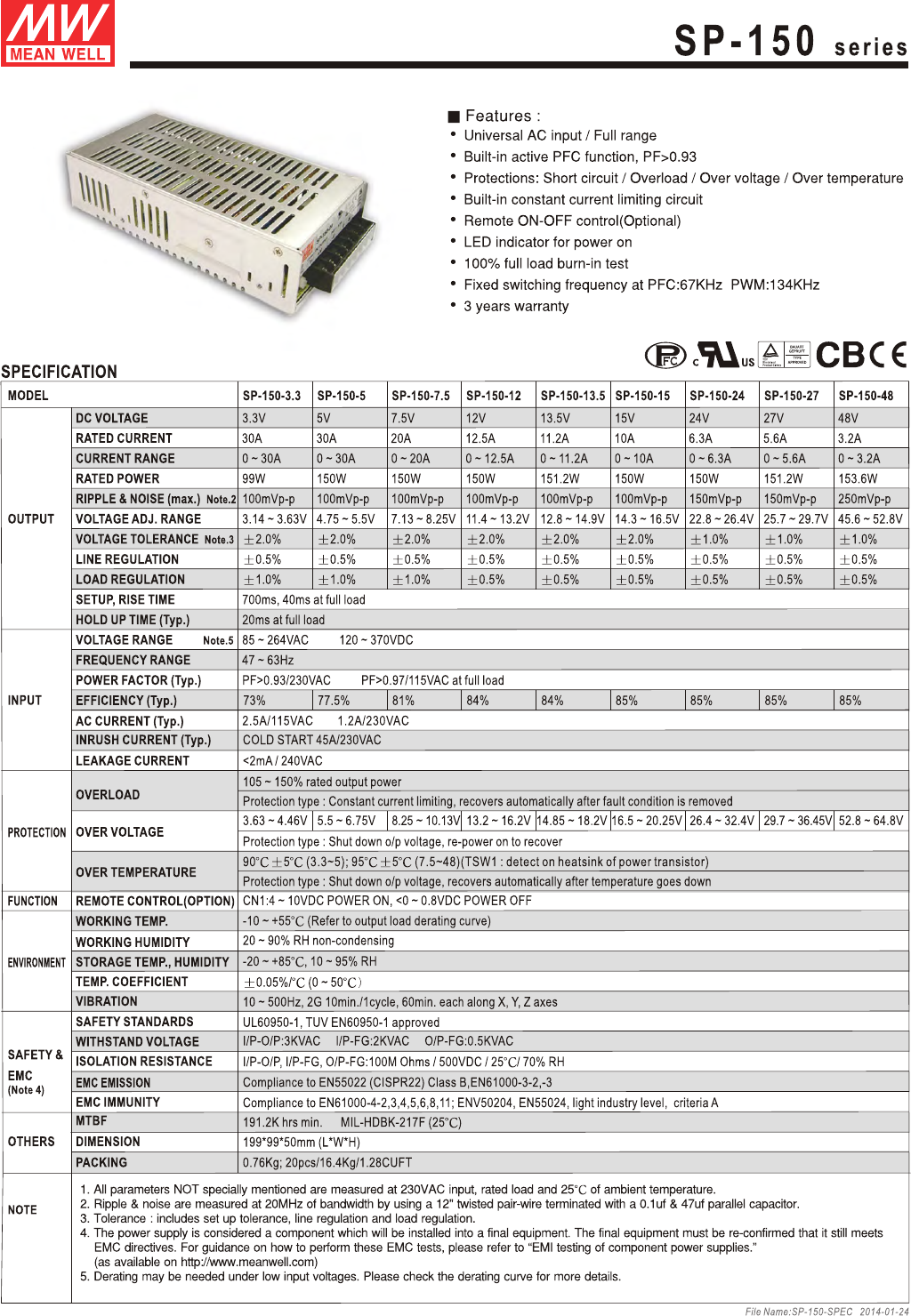
150W Single Output with PFC Function
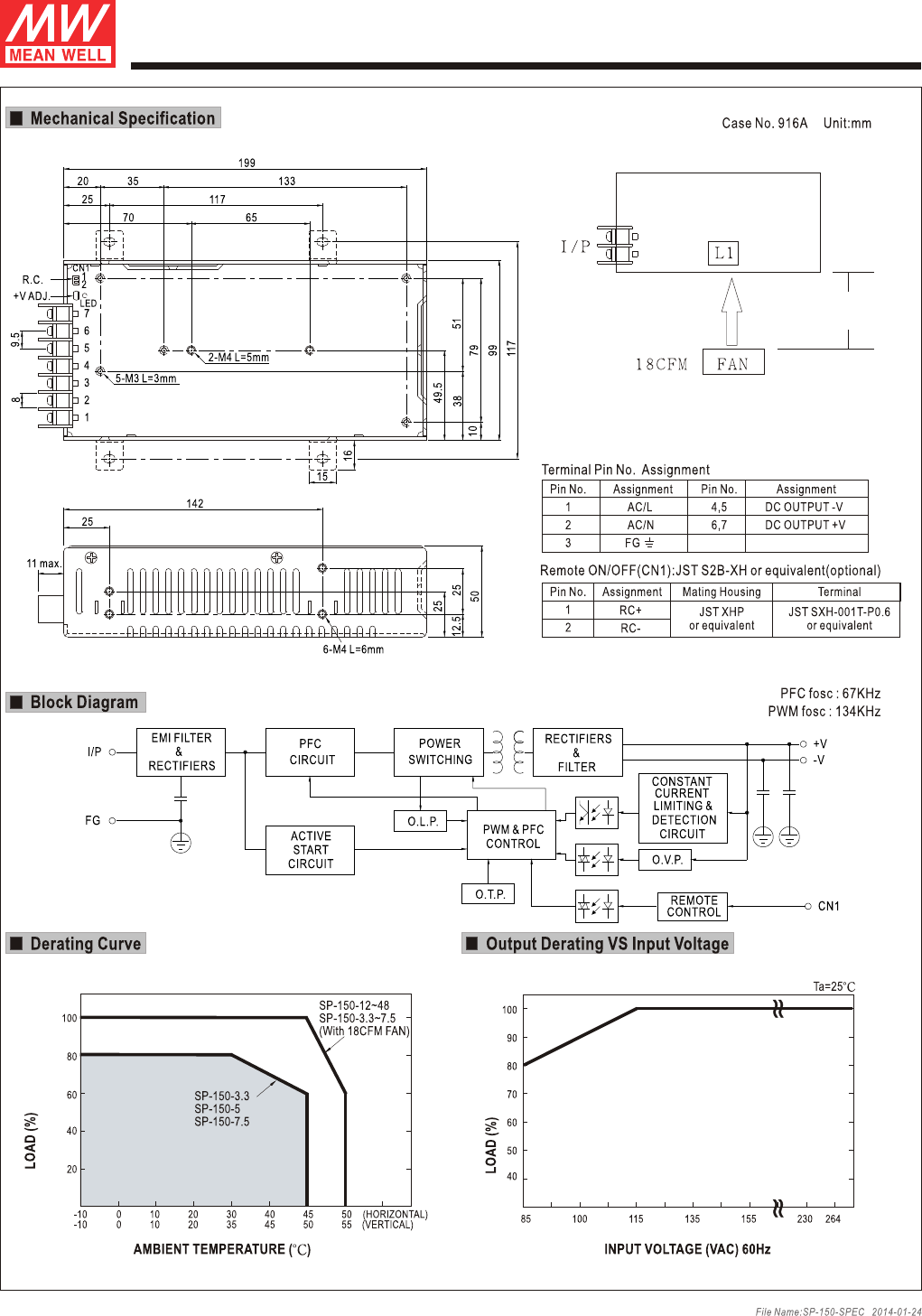
150W Single Output with PFC Function SP-150 series
15 mm
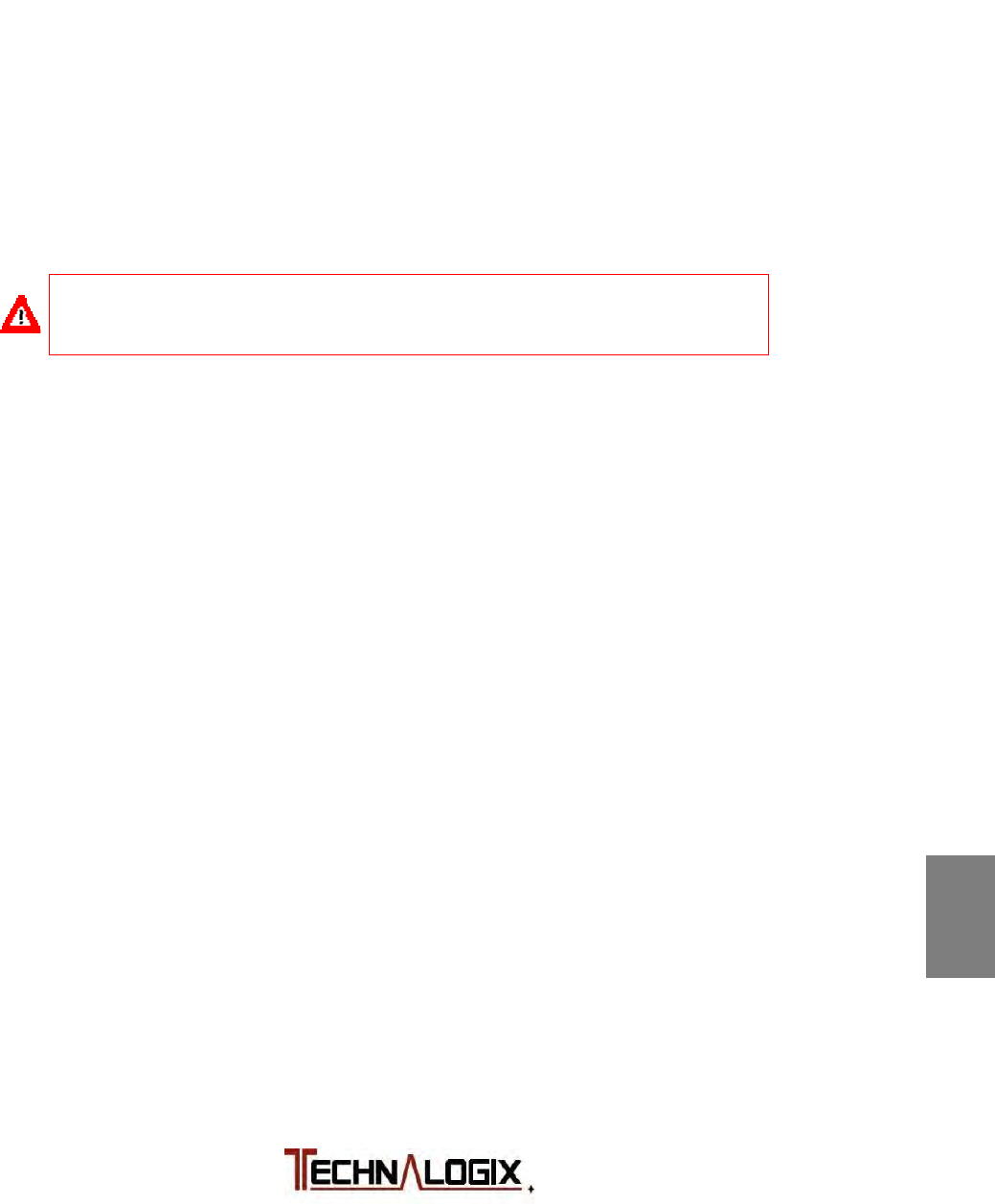
1
Safeguards
2
Terms and
Warranty
3
Principle of
Operation
4
Installation
5
Operation
6
Control System
7
RF Components
8
Power Supply
9
Maintenance
10
Troubleshooting
Maintenance
If your unit employs a filter on the air inlet for the fans, the filter should be cleaned
every 30 days. If the equipment is operated in a severe dust environment, the
filters on the inlet fan may need to be cleaned more regularly. Turn the system off
and unplug all of the AC inlet cords. The filter can be lifted off the fan and
cleaned using an air compressor at low pressure. While the filter is out, clean the
fan blades themselves with a small brush. The fans themselves do not need
lubrication.
The interior of the cabinets should be cleaned and inspected annually. Turn the
system off and unplug all of the AC inlet cords. Remove the top lid by unscrewing
the 6-32 machine screws.
Use extreme caution when working near the AC input terminal. The
power amplifier/transmitter and power supply store hazardous
capacitances and voltages.
Using either compressed air or a brush with soft bristles, loosen accumulated
dust and dirt and then vacuum the interior of the cabinet. Complete a visual
inspection of the interior, making sure there are no loose connections or
discolorations on any components from heat. Nothing inside the power amplifier
or transmitter enclosure exceeds a temperature that is not comfortable to the
touch under normal operating conditions (unless it is RF!), so any signs of
discoloration indicate potential damage.
All modular components inside the enclosure are attached to aluminium
mounting plates for easy removal and replacement. Ensure that plates are
secured and the mounting hardware is tight.

1
Safeguards
2
Terms and
Warranty
3
Principle of
Operation
4
Installation
5
Operation
6
Control System
7
RF Components
8
Power Supply
9
Maintenance
10
Troubleshooting
Troubleshooting
The first and most important aspect of troubleshooting anything is to be
systematic. Note where you have looked and what you found.
Look first for the obvious.
Make a physical inspection of the entire facility. Are all necessary
connections properly made? Do you see any signs of obvious damage within
the equipment?
Is the AC power ‘ON’ to the site and the equipment? (Check fuses and circuit
breakers if necessary.)
Are all the switches in the correct operating position?
Is the input signal present and at the correct level?
Check display readings for presence of forward and reflected power and DC
supply levels.
The following flowcharts are an aid in determining the fault if some aspect of the
system is not operating.
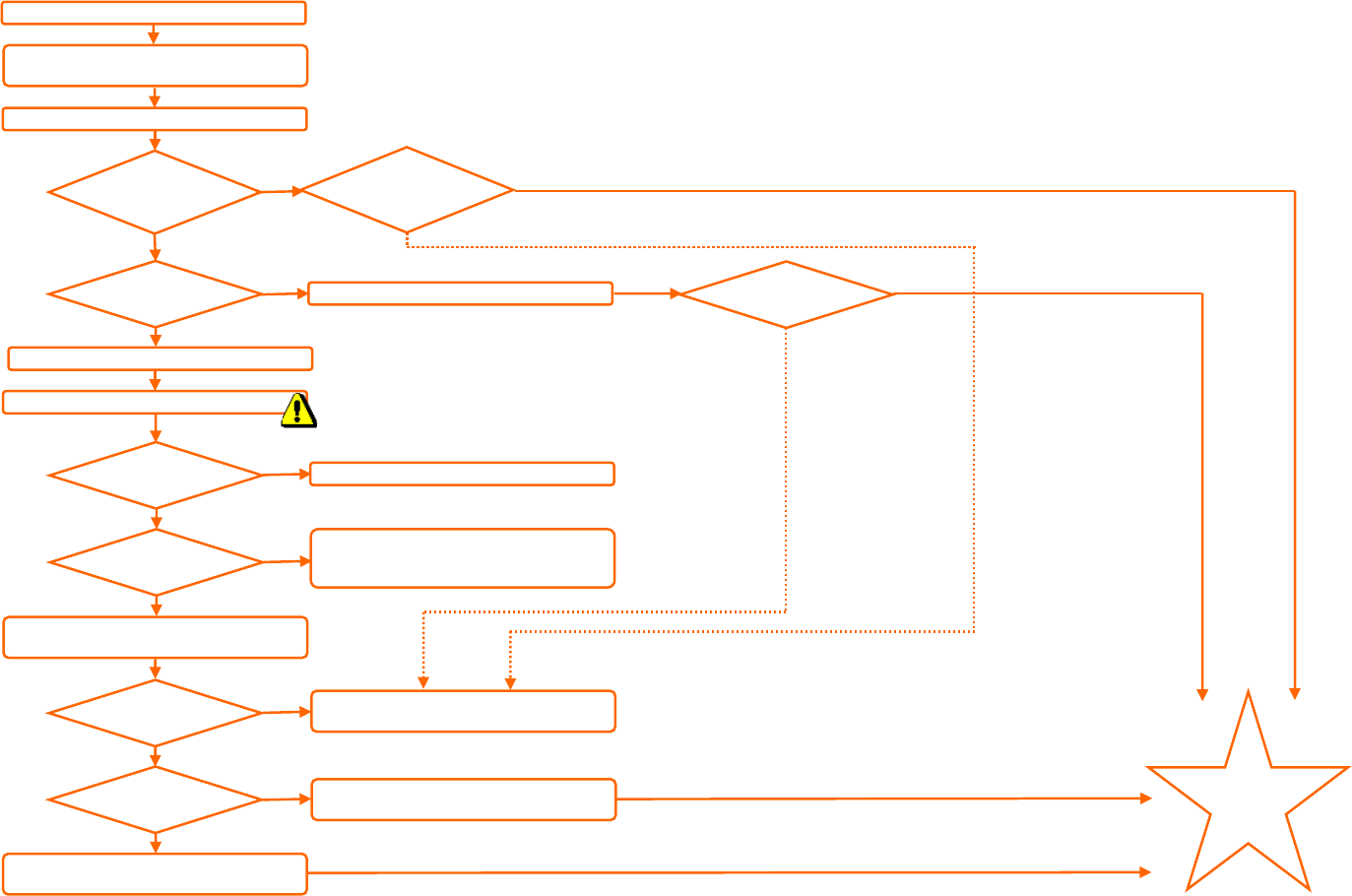
AC-DC Power Supply (PSU) Troubleshooting
Pro
p
erl
y
terminate PA into 50ohm load.
YES
PSU is
operating
correctly.
NO
Apply proper AC power to back panel
(
check if 110V or220V
)
.
Turn on AC rocker switch on back
p
anel.
Reset circuit breaker on back panel.
DC
voltage on
display
correct?
AC breake
r
tri
pp
ed?
NO
NO
N
O
YES
YES
YES
NO
Remove lid of enclosure with
p
ower su
pp
l
y
. DANGEROUS
VOLTAGES INSIDE!
AC voltage present
on PSU in
p
ut? NO Faulty AC connection, entry, switch, or breaker.
DC voltage present
on PSU output? YES
Disconnect DC loads (tape off so they do not
short out
)
to see if DC out
p
ut loaded down.
Proper DC voltage
on PSU output? YES
YES
NO
Bad PSU - magic smoke released.
Replace PSU.
Pallet, fan, or control system loading PSU down.
Troubleshoot control system or RF signal path.
Last Updated: 12-Jul-2011
Is PSU in
shutdown mode? NO
YES
Remove shutdown conditions and
reset the PSU.
Display
on?
Display and
PSU come
back on?
Screen not displaying, but DC PSU
voltage okay. Troubleshoot control
system.
Turn off
p
ower from bac
k
p
anel.
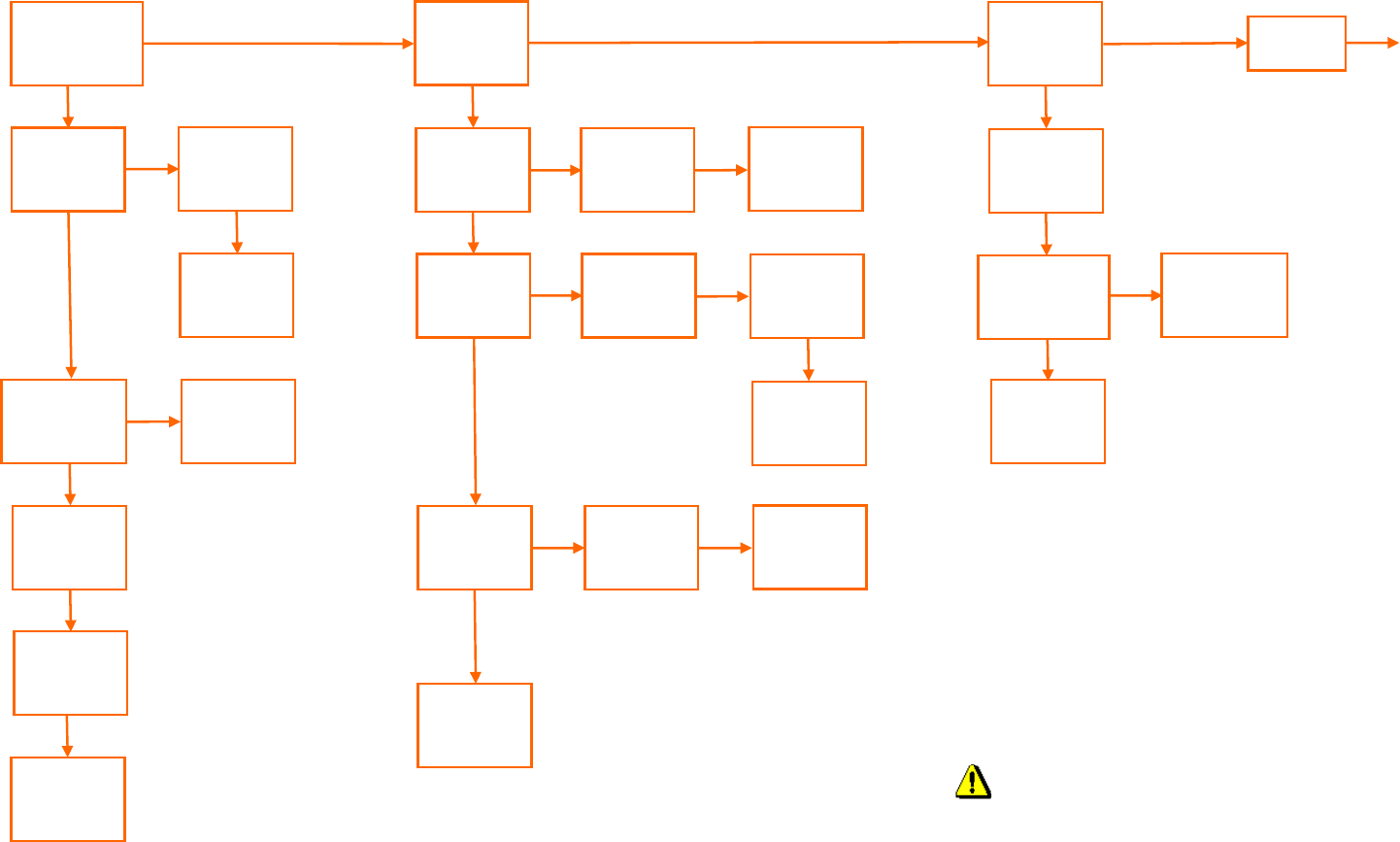
Control System (Adrenaline) Troubleshooting (1 of 2)
YES
NO
YES YES
NO
DANGEROUS VOLTAGES
INSIDE ENCLOSURE!
NO
YES
YES
NO
Last Updated: 29-Aug-2011
NO
YES
Front panel
membrane
Buttons (if used)
functioning?
NO
Alternative
button inputs
on remote
port working?
Bad / loose
membrane
connector /
wiring
Membrane
connected
properly to
PCB?
FWD and
RFL display
data
accurate?
Display
showing text
and data
accurately?
Follow power
supply trouble-
shooting guide
Is text /
graphics
readable?
AC-DC power
supply output
at proper
voltage?
PSU wiring
inputs to
control PCBs
secure?
Contact
Technalogix
for further
information
Power supply
display data
accurate?
Remote port
working
correctly?
Goto page
2 of 2
YES
YES
YES
DC or RF
from dir.
coupler
correct?
Display pins /
connector
seated
properly?
Type of
modulation,
A/V ratio, etc
correct?
Contact
Technalogix
for further
information
RF or DC
Distribution
PCB issue
NO
YES
YES
Replace pre-
programmed
touchscreen
or display
Check cable
that mates to
DB25 panel
connector
NO
NO
Contact
Technalogix
for further
information
Bad
membrane
switch or
control PCB
YES
Is external
equipment
loading down 5V
or 3V on port?
YES Power external
equipment from
dedicated
power supply
Contact
Technalogix
for further
information
Contact
Technalogix
for further
information
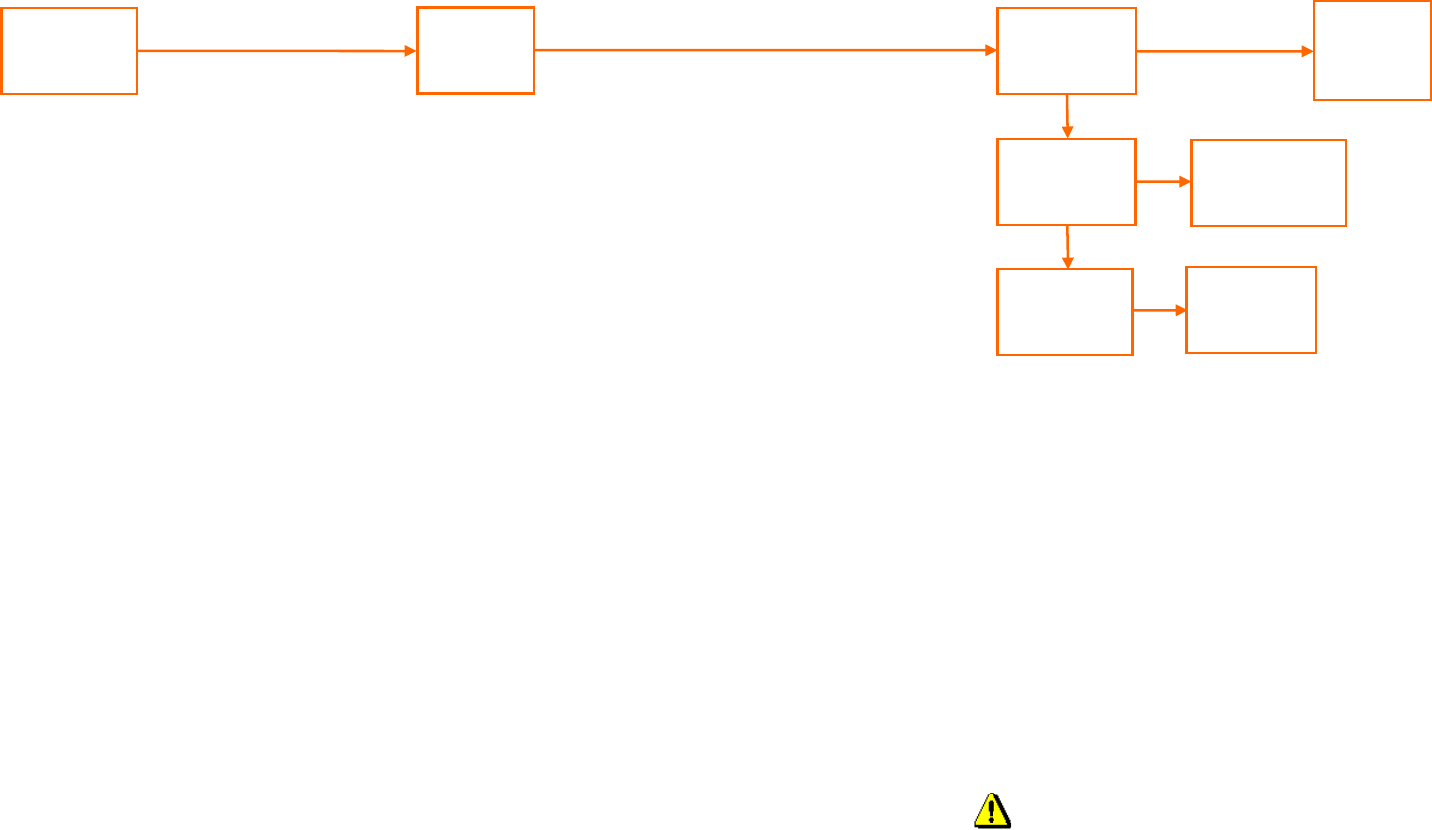
Control System (Adrenaline) Troubleshooting (2 of 2)
YES YES
DANGEROUS VOLTAGES
INSIDE ENCLOSURE!
Last Updated: 29-Aug-2011
Ethernet
interface
functioning?
SNMP
interface
functioning?
Communication
between PCBs
working (CAN)?
Contact
Technalogix
for any
issues not
listed
YES
Display Interface
orange S/W LED
flashing?
NO
Is FWD, RFL, or
DC voltage
displayed on
screen?
YES Contact
Technalogix for
any issues not
listed
NO Display Int. not
communicating with
RF PCB. Check
CAT5 cables

1
Safeguards
2
Terms and
Warranty
3
Principle of
Operation
4
Installation
5
Operation
6
Control System
7
RF Components
8
Power Supply
9
Maintenance
10
Troubleshooting
Thank you
for choosing
Technalogix Ltd.
If there is anything we can do to help in your success, please do not hesitate to
contact us. We also welcome suggestions for product improvements or feature
enhancements, as long as it is not a built in coffee maker.